D Link IR604A1 Wireless N 150 Pocket Router & Access Point User Manual
D Link Corporation Wireless N 150 Pocket Router & Access Point
D Link >
User Manual
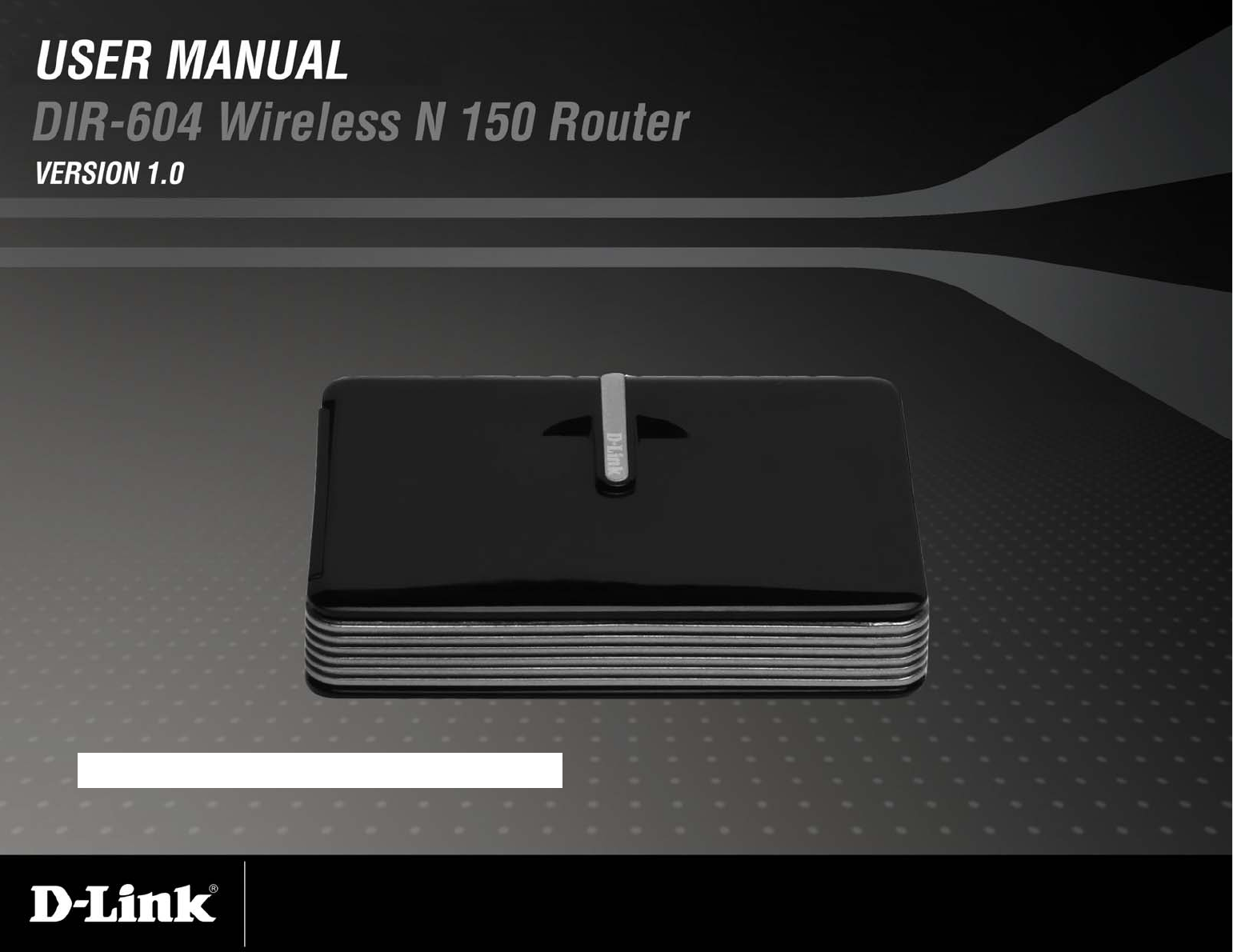
X
jsfmftt!O!261!Bddftt!Qpjou0Spvufs!

iD-Link DIR-604 User Manual
D-Link reserves the right to revise this publication and to make changes in the content hereof without obligation to
notify any person or organization of such revisions or changes.
Trademarks
D-Link and the D-Link logo are trademarks or registered trademarks of D-Link Corporation or its subsidiaries in the
United States or other countries. All other company or product names mentioned herein are trademarks or registered
trademarks of their respective companies.
Copyright © 2010 by D-Link Systems, Inc.
All rights reserved. This publication may not be reproduced, in whole or in part, without prior expressed written permission
from D-Link Systems, Inc.
Preface

iiD-Link DIR-604 User Manual
Table of Contents
Preface...........................................................................i
Manual Revisions ..................................................... i
Trademarks .............................................................. i
Product Overview ........................................................ 1
Package Contents ...................................................1
System Requirements ............................................. 2
Features .................................................................. 3
Hardware Overview ................................................. 4
Connections ....................................................... 4
Top View ............................................................ 5
Switching Between WAN Mode/3G Router
Mode .................................................................. 6
Installation ....................................................................7
Before you Begin ..................................................... 7
Wireless Installation Considerations ........................ 8
Network Diagram ....................................................9
WAN Connection ............................................... 9
Network Diagram ..................................................10
3G Connection ................................................. 10
Connect to Cable/DSL/Satellite Modem ................ 11
Connect to a 3G Internet Service .......................... 13
Connect to Another Router .................................... 14
Conguration ............................................................. 16
Web-based Conguration Utility ............................ 16
Internet Connection Setup Wizard (3G Mode) .17
Manual Conguration (3G Mode) .................... 20
3G Internet Connection ................................ 20
Internet Connection Setup Wizard (WAN
Mode) ...............................................................21
Manual Conguration (WAN Mode) ................. 28
Static IP Address .......................................... 29
Dynamic IP Address (DHCP) .......................30
PPPoE (Username/Password) .....................31
PPTP (Username/Password) .......................33
L2TP (Username/Password) ........................35
Russia PPTP (Dual Access) ........................37
Russia PPPoE (Dual Access) ...................... 39
Wireless Settings ............................................. 41
Manual Wireless Network Setup ..................42
Network Settings .............................................. 44
DHCP Server Settings .................................45
DHCP Reservation .......................................46
Virtual Server ...................................................47
Port Forwarding ............................................... 49
Application Rules .............................................50
QoS Engine ..................................................... 51
Network Filters ................................................. 52
Website Filters ................................................. 53
Firewall Settings .............................................. 54
Firewall Rules ............................................... 55
Advanced Wireless Settings ............................ 57
Wi-Fi Protected Setup ...................................... 58
Table of Contents

iiiD-Link DIR-604 User Manual
Table of Contents
Advanced Network Settings ............................. 59
UPnP ............................................................59
Internet Ping Block .......................................59
Internet Port Speed ......................................59
Multicast Streams ......................................... 59
Administrator Settings ...................................... 60
Change Password ........................................60
Remote Management ................................... 60
Time Settings ................................................... 61
E-mail Settings ................................................. 62
System Settings ............................................... 63
Update Firmware ............................................. 64
DDNS ............................................................... 65
System Check .................................................. 66
Schedules ........................................................67
Device Information ........................................... 68
Logs .................................................................69
Statistics .......................................................... 70
Internet Sessions .............................................71
Wireless ...........................................................72
Support ............................................................ 73
Wireless Security.......................................................74
What is WPA? .......................................................74
Wireless Connection Setup Wizard ....................... 75
Add Wireless Device with WPS Wizard ................. 78
Congure WPA-Personal (PSK) ............................ 79
Congure WPA-Enterprise (RADIUS) ................... 80
Connect to a Wireless Network ................................ 81
Using Windows Vista® ........................................... 81
Congure WPA/WPA2 ..................................... 82
Connect Using WCN 2.0 .................................. 84
Using Windows® XP ............................................... 85
Congure WPA-PSK ........................................ 86
Troubleshooting ........................................................ 88
Wireless Basics ......................................................... 92
What is Wireless? .................................................. 93
Tips ........................................................................ 95
Wireless Modes ..................................................... 96
Networking Basics .................................................... 97
Check your IP address ..........................................97
Statically Assign an IP address ............................. 98
Technical Specications........................................... 99

1D-Link DIR-604 User Manual
Section 1 - Product Overview
Product Overview
Note: Using a power supply with a different voltage rating than the one included with the DIR-604 will cause damage and void the warranty for this
product.
Package Contents
D-Link DIR-604 Wireless 11n Router
Power Adapter
Ethernet Cable
USB Cable

2D-Link DIR-604 User Manual
Section 1 - Product Overview
Network Requirements
• An Ethernet-based Cable or DSL modem
• IEEE 802.11n/g wireless clients
• 10/100 Ethernet
Web-based Conguration
Utility Requirements
Computer with the following:
• Windows®, Macintosh, or Linux-based operating
system
• An installed Ethernet adapter
Browser Requirements:
• Internet Explorer 6.0 or higher
• Mozilla 1.7.12 or higher
• Firefox 1.5 or higher
• Safari 1.0 or higher (with Java 1.3.1 or higher)
• Flock 0.7.14 or higher
• Opera 6.0 or higher
Windows® Users: Make sure you have the latest version
of Java installed. Visit www.java.com to download the
latest version.
System Requirements

3D-Link DIR-604 User Manual
Section 1 - Product Overview
• Faster Wireless Networking - The DIR-604 provides up to 300Mbps* wireless connection with other
802.11n wireless clients. This capability allows users to participate in real-time activities online, such as
video streaming, online gaming, and real-time audio.
• Compatible with 802.11g Devices - The DIR-604 is still fully compatible with the IEEE 802.11g standard,
so it can connect with existing 802.11g PCI, USB, and Cardbus adapters.
• Advanced Firewall Features - The Web-based user interface displays a number of advanced network
management features including:
• Content Filtering - Easily applied content ltering based on MAC Address, URL, and/or
Domain Name.
• Filter Scheduling - These lters can be scheduled to be active on certain days or for a
duration of hours or minutes.
• Secure Multiple/Concurrent Sessions - The DIR-604 can pass through VPN sessions. It
supports multiple and concurrent IPSec and PPTP sessions, so users behind the DIR-604
can securely access corporate networks.
• User-friendly Setup Wizard - Through its easy-to-use Web-based user interface, the DIR-604 lets you
control what information is accessible to those on the wireless network, whether from the Internet or from
your company’s server. Congure your router to your specic settings within minutes.
* Maximum wireless signal rate derived from IEEE Standard 802.11g and Final 802.11n specications. Actual data throughput will vary. Network conditions and
environmental factors, including volume of network trafc, building materials and construction, and network overhead, lower actual data throughput rate. Environmental
conditions will adversely affect wireless signal range.
Features
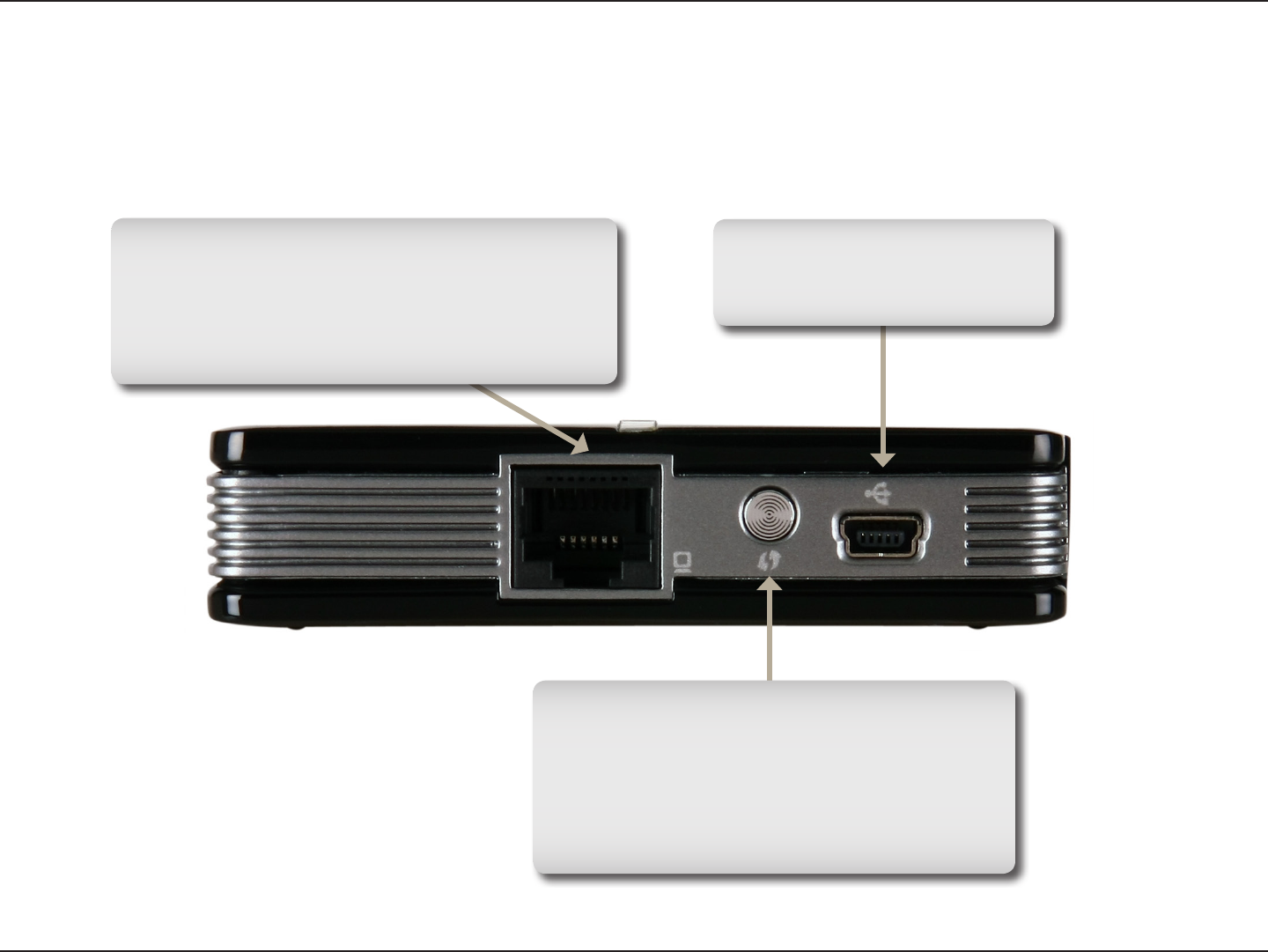
4D-Link DIR-604 User Manual
Section 1 - Product Overview
Power Receptor
Receptor for the supplied power
adapter.
WPS Button
Press the WPS button for 1 second to initiate the
WPS process. The LED indicator on the top of
the device will ash blue while a WPS connection
is being established. The button will light blue for
300 seconds if a successful WPS connection has
been made.
Ethernet Port
In Router mode, the Ethernet port is used to
connect to your WAN connection. In AP mode, the
Ethernet port is used to connect to your switch/
router. In Client mode, the Ethernet port is used to
connect your computer to a wireless network.
Hardware Overview
Connections
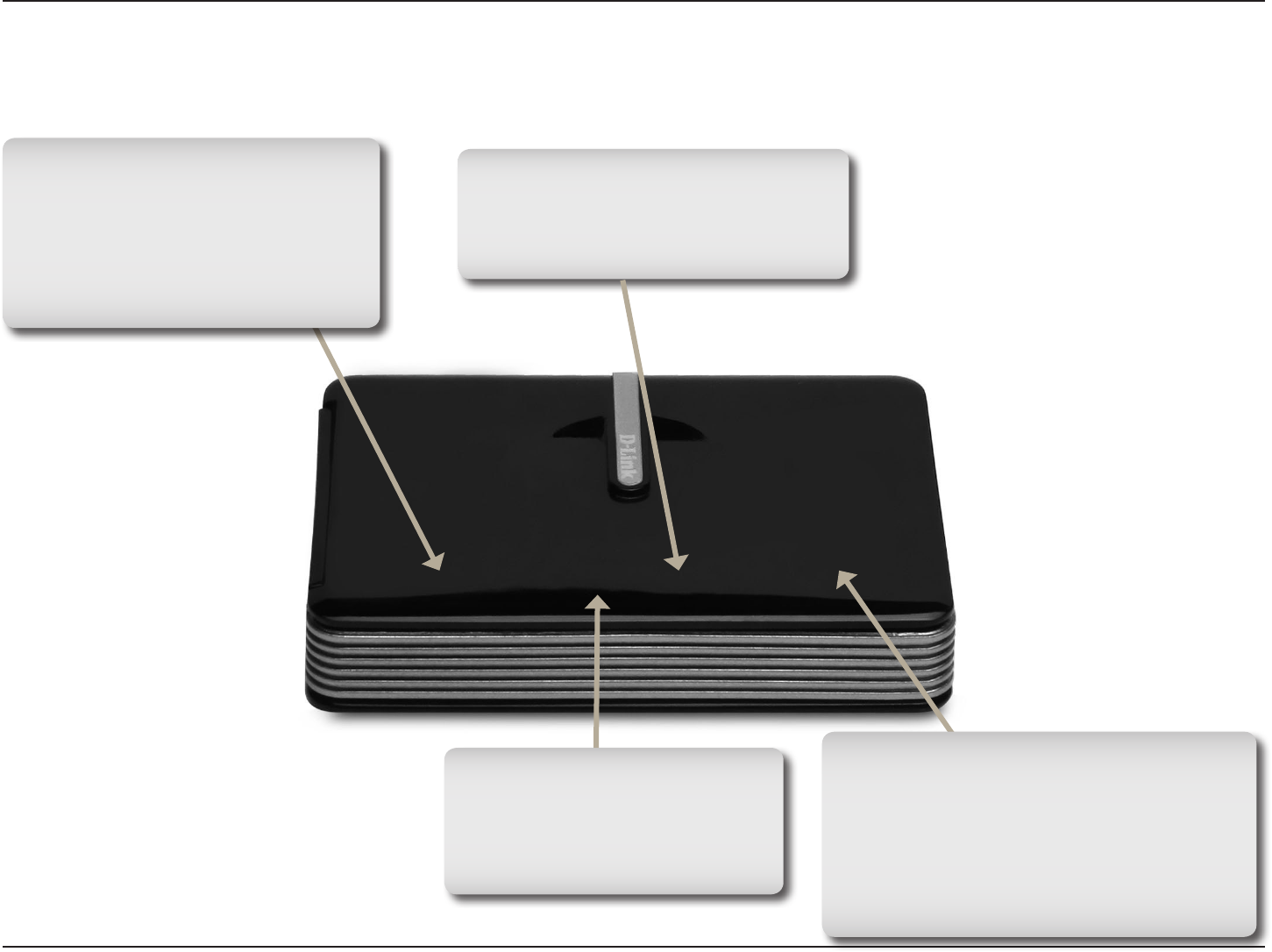
5D-Link DIR-604 User Manual
Section 1 - Product Overview
WLAN LED
A solid green light indicates that
the wireless segment is ready.
This LED blinks during wireless
data transmission.
Power LED
Lights orange during bootup. Lights
green when router has booted
up. A solid green light indicates
a proper connection to the power
supply. If the LED blinks orange
the system has failed.
Ethernet LED
A solid green light indicates that a link
has been established. This LED blinks
during data transmission.
Hardware Overview
Top View
WPS Button
Press the WPS button for 1 second to
initiate the WPS process. The button will
ash blue while a WPS connection is being
established. The button will light blue for 300
seconds if a successful WPS connection
has been made.

6D-Link DIR-604 User Manual
Section 1 - Product Overview
Hardware Overview
Switching Among AP, Client, and Router Mode
The DIR-604 features a hardware switch located on the bottom of the device that enables users to switch among Router
mode, Client mode, and AP mode.
When the DIR-604 is operating in AP mode, the device acts as a basic access point without any routing functionality.
When the DIR-604 is operating in Client mode, the PC that is connected to the device will use it as a wireless network
interface in order that it can connect to a wireless router or access point.
When the DIR-604 is operating in Router mode, WAN connectivity is achieved via the DIR-604’s Ethernet port. In this
mode LAN clients need to access the DIR-604 via the DIR-604’s wireless connection.
Mode Switch
Use to switch among AP mode,
Client mode, and Router mode.
Reset Button
Press the Reset button for 5
seconds to restore the Router to
its original factory default settings.

7D-Link DIR-604 User Manual
Section 2 - Installation
This section will walk you through the installation process. Placement of the Router is very important. Do not place the
Router in an enclosed area such as a closet, cabinet, or in the attic or garage. The D-Link wireless Router lets you
access your network using a wireless connection from virtually anywhere within the operating range of your wireless
network. Keep in mind, however, that the number, thickness and location of walls, ceilings, or other objects that the
wireless signals must pass through, may limit the range. Typical ranges vary depending on the types of materials and
background RF (radio frequency) noise in your home or business. The key to maximizing wireless range is to follow
these basic guidelines:
1. Keep the number of walls and ceilings between the D-Link Router and other network devices to a
minimum - each wall or ceiling can reduce your adapter’s range from 3-90 feet (1-30 meters.) Position
your devices so that the number of walls or ceilings is minimized.
2. Be aware of the direct line between network devices. A wall that is 1.5 feet thick (0.5 meters), at a
45-degree angle appears to be almost 3 feet (1 meter) thick. At a 2-degree angle it looks over 42 feet
(14 meters) thick! Position devices so that the signal will travel straight through a wall or ceiling (instead
of at an angle) for better reception.
3. Building Materials make a difference. A solid metal door or aluminum studs may have a negative effect on
range. Try to position access points, wireless routers, and computers so that the signal passes through
drywall or open doorways. Materials and objects such as glass, steel, metal, walls with insulation, water
(sh tanks), mirrors, le cabinets, brick, and concrete will degrade your wireless signal.
4. Keep your product away (at least 3-6 feet or 1-2 meters) from electrical devices or appliances that
generate RF noise.
5. If you are using 2.4GHz cordless phones or X-10 (wireless products such as ceiling fans, lights, and
home security systems), your wireless connection may degrade dramatically or drop completely. Make
sure your 2.4GHz phone base is as far away from your wireless devices as possible. The base transmits
a signal even if the phone in not in use.
Installation Considerations
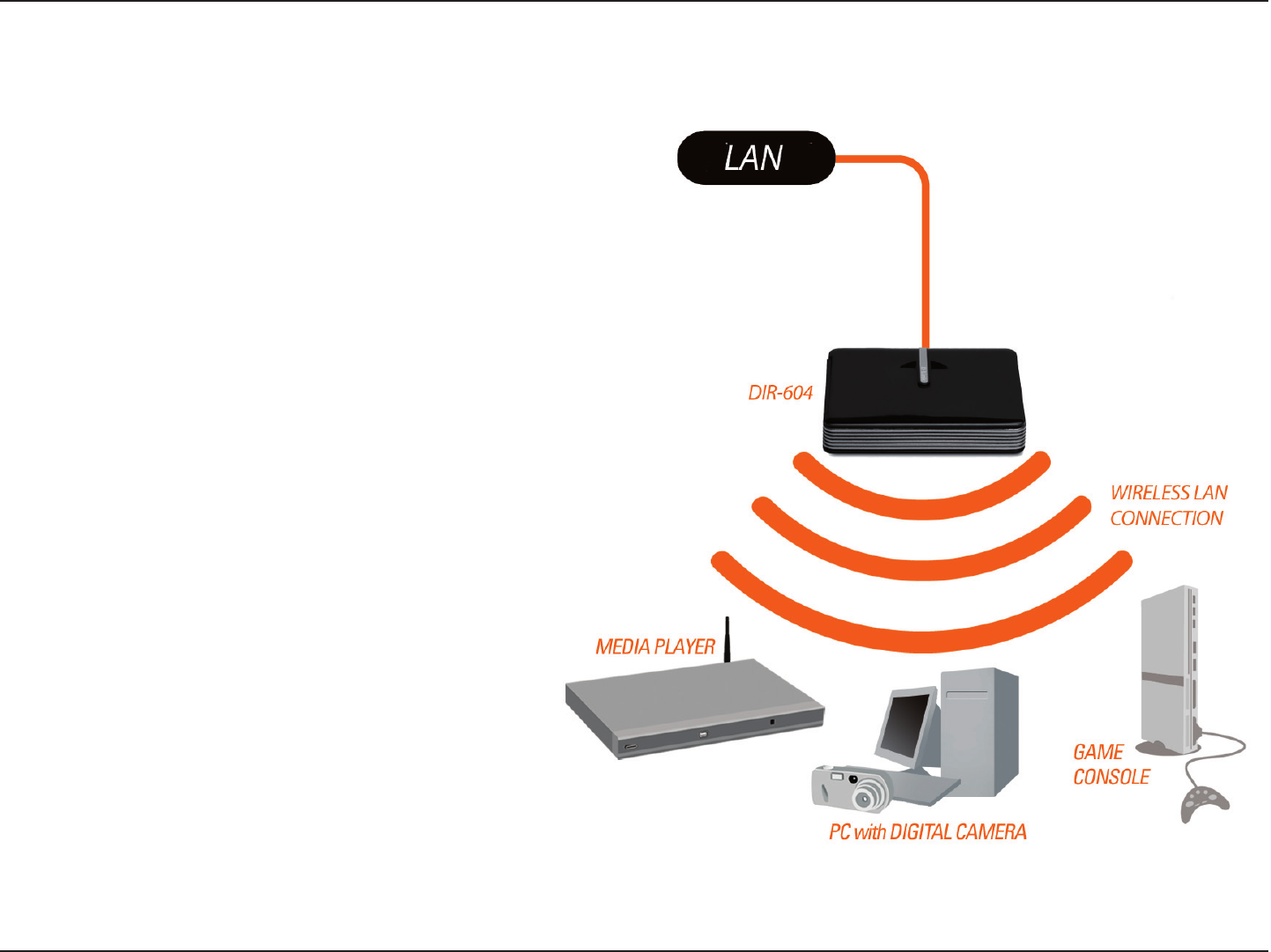
8D-Link DIR-604 User Manual
Section 2 - Installation
Connection - AP Mode
To use the DIR-604 in AP Mode, follow the steps
below:
1. Ensure you have a broadband Internet connector,
such as a cable or DSL client line that connects
the Internet to your home or ofce.
2. Connect the cable properly or install the modem.
3. Connect the cable or modem with the broadband
router.
4. Connect the DIR-604’s Ethernet port to your
LAN.
5. Move the switch to wireless AP Mode.
6. Connect your PC or notebook to the DIR-604
using the PC or notebook’s wireless adapter.

9D-Link DIR-604 User Manual
Section 2 - Installation
Connection - Client Mode
To use the DIR-604 in Client Mode, follow the steps below:
1. Ensure you have a broadband Internet connector, such as a cable or DSL client line that connects the Internet to
your home or ofce.
2. Connect the cable properly or install the modem.
3. Connect the cable or modem with the broadband router.
4. Move the switch to Client Mode.
5. Connect your PC or notebook to the DIR-604 using the PC or notebook’s wireless adapter.

10D-Link DIR-604 User Manual
Section 2 - Installation
Connection - Router Mode
To use the DIR-604 in Router Mode, follow the steps below:
1. Ensure you have a broadband Internet connector, such
as a cable or DSL client line that connects the Internet to
your home or ofce.
2. Connect the cable properly or install the modem.
3. Connect the cable or modem with the broadband router.
4. Move the switch to Router Mode.
5. If you want to link with a computer on the Internet, please
install a wireless dongle on your computer.
6. Install the driver on your computer.

11D-Link DIR-604 User Manual
Section 2 - Installation
If your Internet connection is provided using a cable/DSL/satellite modem, carry out the following procedure before
connecting the router to a cable/DSL/satellite modem:
• Move the AP Mode/Client Mode/Router Mode switch on the DIR-604 so that it is in the Client Mode
position.
• Congure the wireless settings on the DIR-604 in Client Mode (see “Wireless Connection” on page 17 for
more information).
• After conguring the wireless settings, move the AP Mode/Client Mode/Router Mode switch so that it
is in the Router Mode position.
To connect to a cable/DSL/Satellite modem, please follow the steps below:
1. Place the Router in an open and central location. Do not plug the power adapter into the router.
2. Turn the power off on your modem. If there is no on/off switch, then unplug the modem’s power adapter. Shut down
your computer.
3. Unplug the Ethernet cable (that connects your computer to your modem) from your computer and place it into the
Ethernet port on the Router.
5. Turn on or plug in your modem. Wait for the modem to boot (about 30 seconds).
6. Plug the power adapter to the router and connect to an outlet or power strip. Wait about 50 seconds for the router
to boot.
7. Turn on your computer.
8. Use the wireless connection on your computer to connect to the Router, using the wireless settings you congured
Connect to Cable/DSL/Satellite Modem

12D-Link DIR-604 User Manual
Section 2 - Installation
previously.
9. Verify the link lights on the Router. The power light, Internet light, and the Wireless LAN light should be lit. If not,
make sure your computer, modem, and router are powered on and verify the cable connections are correct.
10. Skip to “Conguration” on page 15 to congure your router.

13D-Link DIR-604 User Manual
Section 2 - Installation
If you are connecting the D-Link Router to another router to use as a wireless access point and/or switch, you will have
to do the following before connecting the Router to your network:
• Move the AP Mode/Client Mode/Router Mode switch on the DIR-604 so that it is in the AP Mode position.
• Disable UPnP™
• Disable DHCP
• Change the LAN IP address to an available address on your network. The Ethernet port on the router
cannot accept a DHCP address from your other router.
To connect to another router, please follow the steps below:
1. Plug the power into the router. Connect one of your computers to the Ethernet port using an Ethernet cable. Make
sure your IP address on the computer is 192.168.0.xxx (where xxx is between 2 and 254). Please see the Networking
Basics section for more information. If you need to change the settings, write down your existing settings before
making any changes. In most cases, your computer should be set to receive an IP address automatically in which
case you will not have to do anything to your computer.
2. Open a web browser and enter http://192.168.0.1 and press Enter. When the login window appears, set the user
name to Admin and leave the password box empty. Click Log In to continue.
3. Click on Advanced and then click Advanced Network. Uncheck the Enable UPnP checkbox. Click Save Settings
to continue.
4. Click Setup and then click Network Settings. Uncheck the Enable DHCP Server server checkbox. Click Save
Settings to continue.
5. Under Router Settings, enter an available IP address and the subnet mask of your network. Click Save Settings to
save your settings. Use this new IP address to access the conguration utility of the router in the future. Close the
Connect to Another Router

14D-Link DIR-604 User Manual
Section 2 - Installation
browser and change your computer’s IP settings back to the original values as in Step 1.
6. Disconnect the Ethernet cable from the router and reconnect your computer to your network.
7. Connect an Ethernet cable into the Ethernet port of the router and connect it to your other router.
8. To congure your wireless network, open a Web browser and enter the IP address you assigned to the router. Refer
to the Conguration and Wireless Security sections for more information on setting up your wireless network.

15D-Link DIR-604 User Manual
Section 3 - Configuration
Configuration
This section will show you how to congure your new D-Link wireless Router using the Web-based conguration utility.
Web-based Configuration Utility for AP Mode
To access the conguration utility, open a Web-
browser such as Internet Explorer and enter the IP
address of the router (192.168.0.1).
Type Admin in the User Name eld and then enter
your password. Leave the password blank by default.
Click the Login button to log in to the Router.
If you get a Page Cannot be Displayed error, please
refer to the Troubleshooting section for assistance.
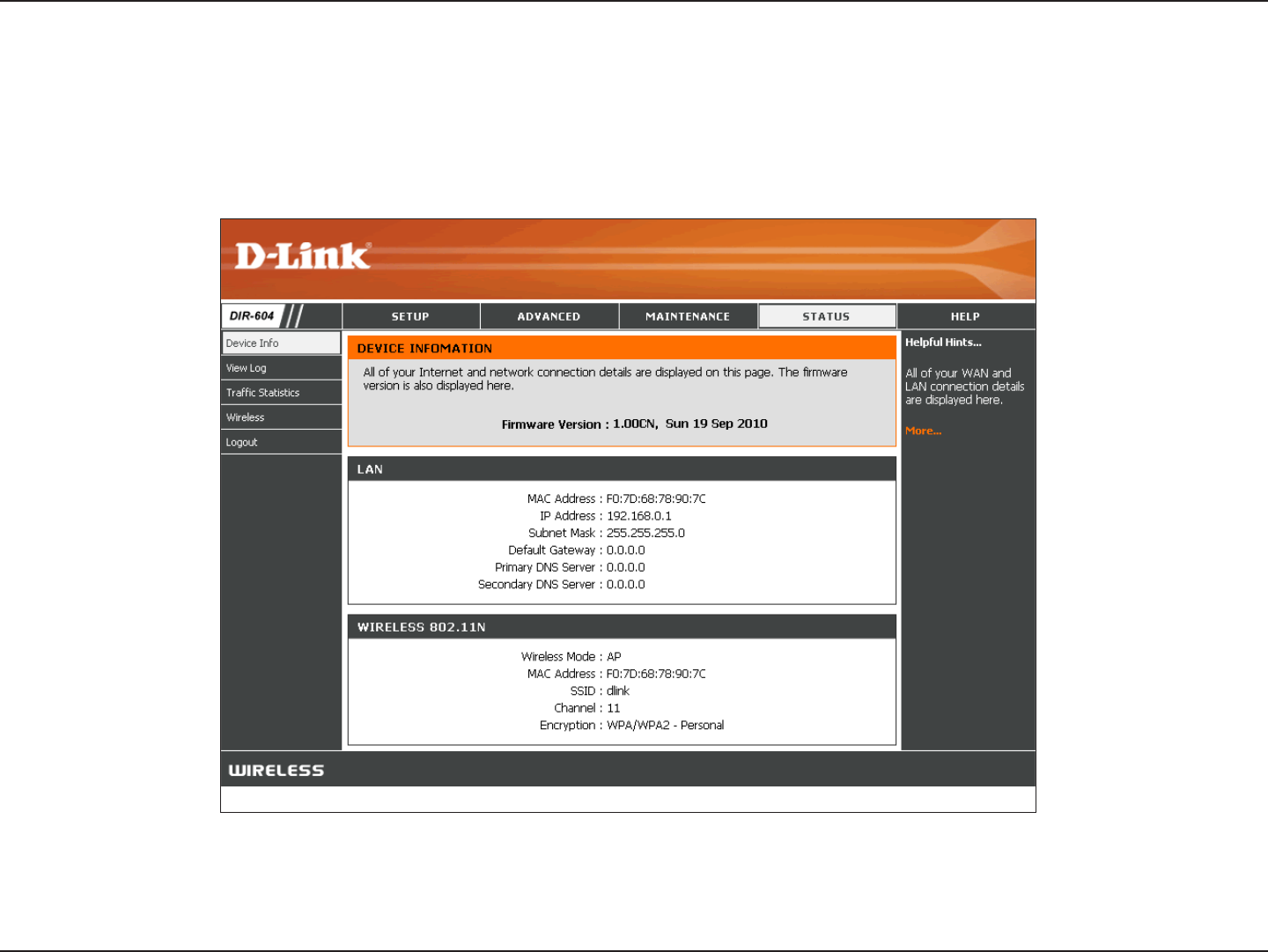
16D-Link DIR-604 User Manual
Section 3 - Configuration
AP Mode Opening Page
Once logged into the Web interface of the Router in AP Mode, the Device Information page will appear. This displays
the SSID, Channel, and Encryption status. To make changes to your wireless network, click Setup to access the
Wireless Connection page.
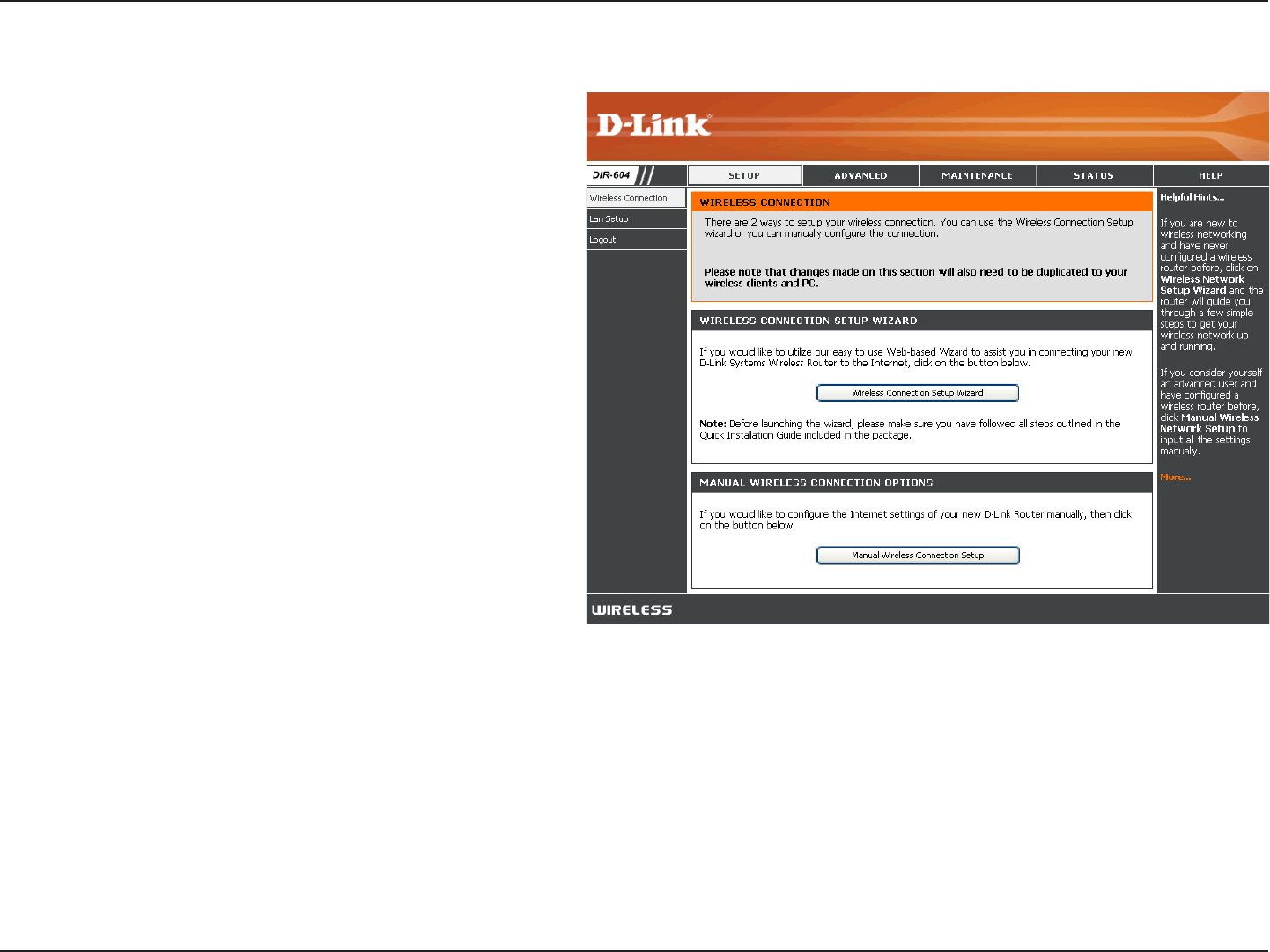
17D-Link DIR-604 User Manual
Section 3 - Configuration
Wireless Connection
If you want to congure the wireless settings on your
Router using the wizard, click Wireless Connection
Setup Wizard and refer to “Wireless Connection
Setup Wizard” on page 81.
If you want to manually congure the wireless settings
on your Router, click Manual Wireless Connection
Setup and refer to the next page.
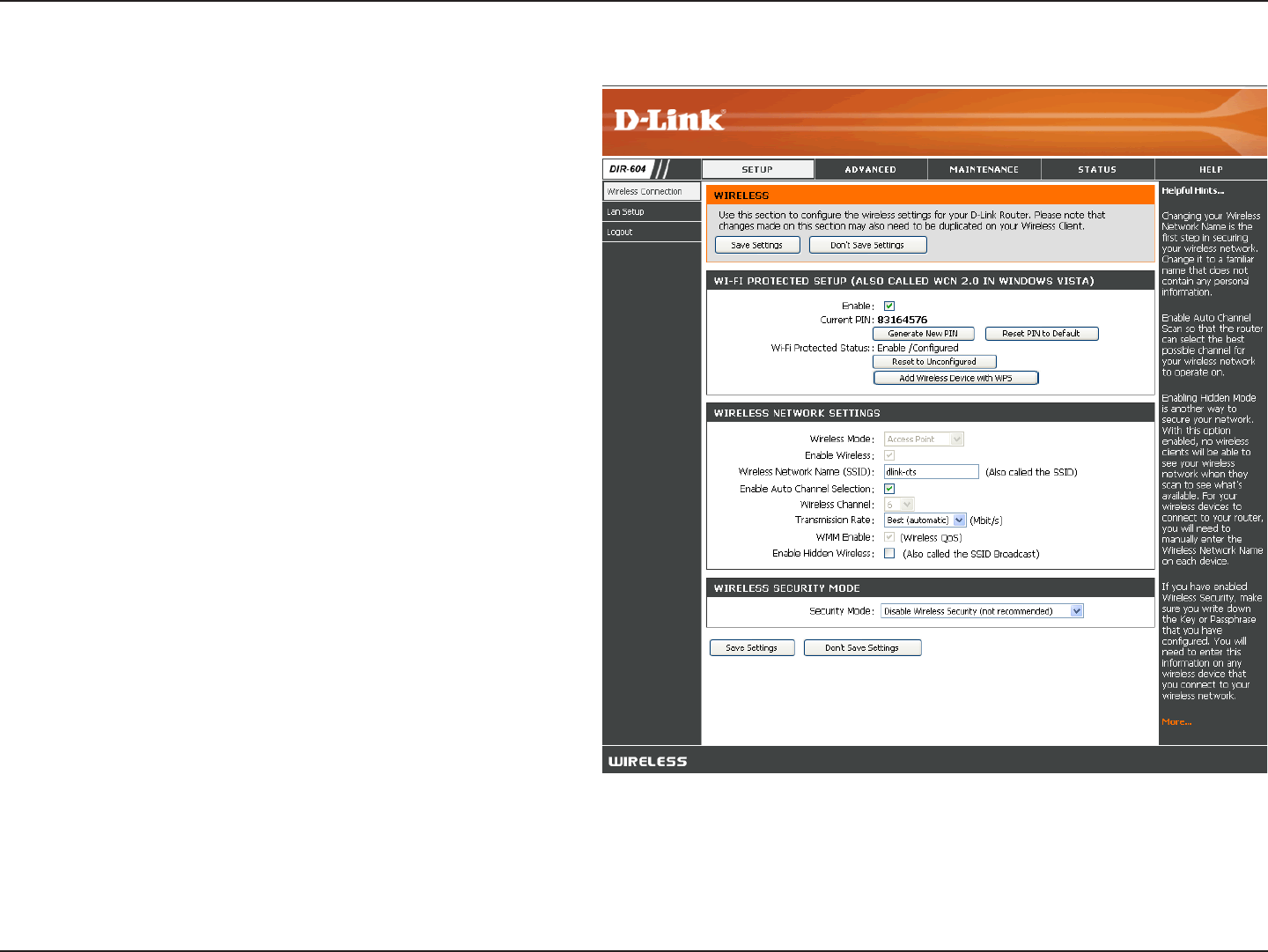
18D-Link DIR-604 User Manual
Section 3 - Configuration
Manual Wireless Network Setup
Tick the check box to enable the wireless
function. If you do not want to use wireless, de-
select the check box to disable all the wireless
functions.
Service Set Identier (SSID) is the name of your
wireless network. Create a name using up to 32
characters. The SSID is case-sensitive.
The Auto Channel Scan setting can be selected
to allow the DIR-604 to choose the channel with
the least amount of interference.
Indicates the channel setting for the DIR-604.
By default the channel is set to 6. The Channel
can be changed to t the channel setting for an
existing wireless network or to customize the
wireless network. If you enable Auto Channel
Scan, this option will be grayed out.
Select the transmit rate. It is strongly suggested
to select Best (automatic) for best performance.
WMM (Wi-Fi Multimedia) is QoS for your wireless
network. Tick this box to improve the quality of
video and voice applications for your wireless
clients. This feature is not available in 802.11n
congurations.
Enable
Wireless:
Wireless
Network Name
(SSID):
Enable Auto
Channel
Selection:
Wireless
Channel:
Transmission
Rate:
WMM Enable:
Enable Hidden
Wireless:
Enabling Hidden Mode is another way to secure your network. With this option enabled, no wireless clients will
be able to see your wireless network when they perform a scan to see what’s available. In order for your wireless
devices to connect to your Router, you will need to manually enter the Wireless Network Name on each device.
Refer to Section 4 - Wireless Security for more information regarding wireless security.
Security
Mode:

19D-Link DIR-604 User Manual
Section 3 - Configuration
LAN Setup
This section will allow you to change the internal network settings of the Router and to congure the DHCP settings.
Enter the IP address of the Router. The default
IP address is 192.168.0.1.
If you change the IP address, once you click
Save Settings, you will need to enter the new
IP address in your browser to get back into the
conguration utility.
Enter the subnet mask. The default subnet mask
is 255.255.255.0.
Enter the default gateway IP address.
Enter the primary DNS server IP address.
Enter the secondary DNS server IP address.
Tick this check box to enable the DHCP server
on your Router. De-select to disable this function.
Enter the starting and ending IP addresses for
the DHCP server’s IP assignment.
Note: If you statically (manually) assign IP
addresses to your computers or devices, make
sure the IP addresses are outside of this range
or you may have an IP conict.
Router
IP Address:
Subnet Mask:
Default Gateway:
Primary DNS Server:
Secondary DNS
Server:
Enable
DHCP Server:
DHCP IP Address
Range:
DHCP Lease Time:
The length of time for the IP address lease. Enter the Lease time in minutes.
Enable IP/
MAC Binding: Tick to enable IP/MAC binding.
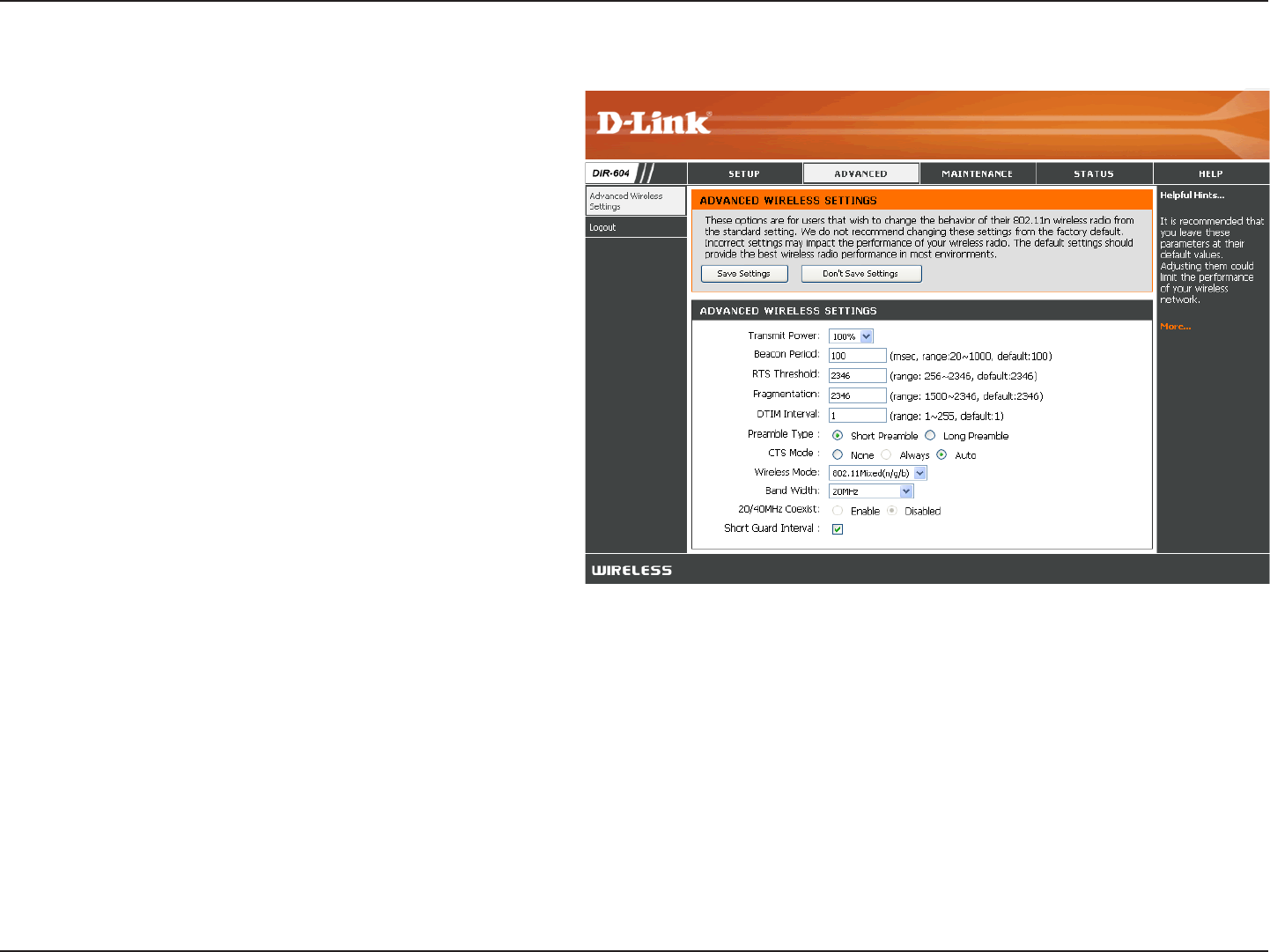
20D-Link DIR-604 User Manual
Section 3 - Configuration
Set the transmit power of the antennas.
Beacons are packets sent by an Access Point to
synchronize a wireless network. Specify a value.
100 is the default setting and is recommended.
This value should remain at its default setting of
2432. If inconsistent data ow is a problem, only
a minor modication should be made.
The fragmentation threshold, which is specied
in bytes, determines whether packets will be
fragmented. Packets exceeding the 2346 byte
setting will be fragmented before transmission.
2346 is the default setting.
(Delivery Trafc Indication Message) 1 is the
default setting. A DTIM is a countdown informing
clients of the next window for listening to
broadcast and multicast messages.
Select Short Preamble or Long Preamble.
The preamble denes the length of the CRC block (Cyclic Redundancy Check is a common technique for detecting data
transmission errors) for communication between the wireless router and the roaming wireless network adapters. Note: High
network trafc areas should use the Short Preamble type.
Select None, Always, or Auto.
Use the drop-down menu to selec the wireless modes you want to enable on the router. The available options are 802.11n
only, 802.11 Mixed (g/b), and 802.11 Mixed (n/g/b).
Tick this check box to reduce the guard interval time therefore increasing the data capacity. However, it is less reliable and
may create higher data loss.
Transmit Power:
Beacon
Period:
RTS
Threshold:
Fragmentation:
DTIM
Interval:
Preamble
Type:
CTS Mode:
Wireless
Mode:
Short Guard
Interval:
Advanced Wireless Settings

21D-Link DIR-604 User Manual
Section 3 - Configuration
Change Password
Remote Management
Administrator Settings
Enter the login name. The default is admin.
Enter a new password for the Administrator
Login Name. The administrator can make
changes to the settings.
Retype the new password for the Administrator
Login Name.
Login Name:
Password:
Confirm
Password:
This page will allow you to change the Administrator and User passwords. You can also enable Remote Management.
There are two accounts that can access the management interface through the Web browser. The accounts are admin
and user. Admin has read/write access while user has read-only access. User can only view the settings but cannot
make any changes. Only the admin account has the ability to change both admin and user account passwords.
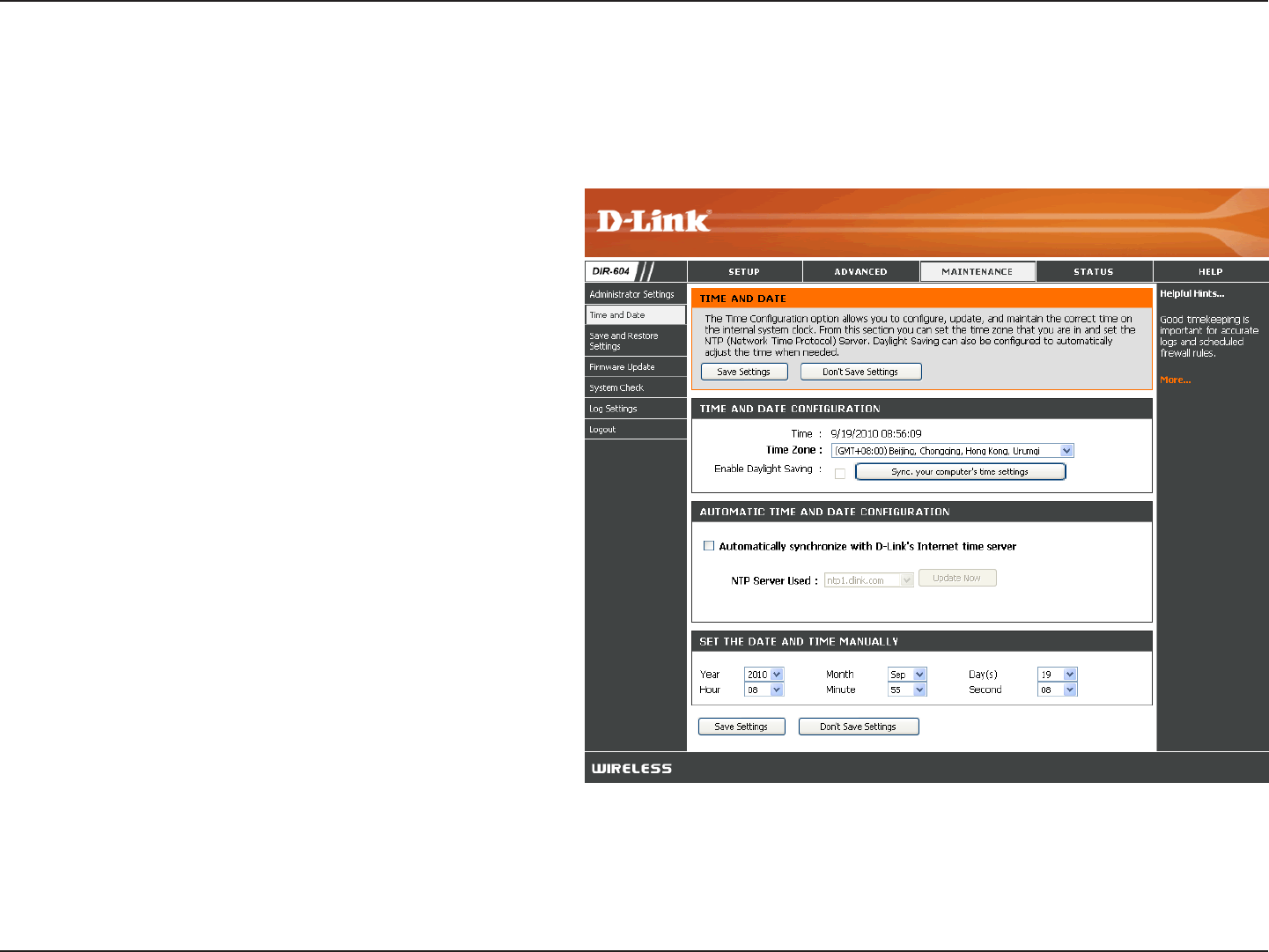
22D-Link DIR-604 User Manual
Section 3 - Configuration
Time and Date
Select the Time Zone from the drop-down menu.
Tick the check box to enable Daylight Saving
Time.
Click this button to set the device’s time the
same to local PC.
Tick the check box to enable the device to
automatically synchronize with a D-Link NTP
Server. NTP stands for Network Time Protocol.
NTP synchronizes computer clock times in a
network of computers. This will only connect
to a server on the Internet, not a local server.
Select one of the D-Link NTP Servers from
the drop-down menu. The DIR-604 will then
synchronize its clock to be the same time as
the D-Link Internet
time server. Click the Update Now button to
synchronize with the D-Link Internet time server
immediatley.
To manually input the time, use the drop-down
menus to enter the values in these elds for the
Year, Month, Day, Hour, Minute, and Second.
Time Zone:
Enable
Daylight
Saving:
Sync your
computer’s time
settings:
Automatically
synchronize
with D-Link’s
Internet time
server:
NTP
Server Used:
Set the Time
and Date
Manually:
The Time and Date Conguration option allows you to congure, update, and maintain the correct time on the internal
system clock. From this section you can set the time zone that you are in and set the Time Server. Daylight Saving
can also be congured to automatically adjust the time when needed.
Click the Save Settings button to save any changes made.

23D-Link DIR-604 User Manual
Section 3 - Configuration
Save and Restore Settings
Use this option to save the current router
conguration settings to a le on the hard disk
of the computer you are using. First, click the
Save button. You will then see a le dialog,
where you can select a location and le name
for the settings.
Use this option to load previously saved
router configuration settings. First, use the
Browse control to nd a previously save le of
conguration settings. Then, click the Upload
Settings button to transfer those settings to
the Router.
Click the Restore Device button to restore
all conguration settings back to the settings
that were in effect at the time the Router was
shipped from the factory. Any settings that have
not been saved will be lost, including any rules
that you have created. If you want to save the
current router conguration settings, use the
Save button above.
Click the Clear button to restore the device back
to the English interface version and remove
other languages installed for the system web
pages.
Save Settings
to Local Hard
Drive:
Load Settings
from Local
Hard Drive:
Restore to
Factory
Default
Settings:
Clear
Language
Pack:
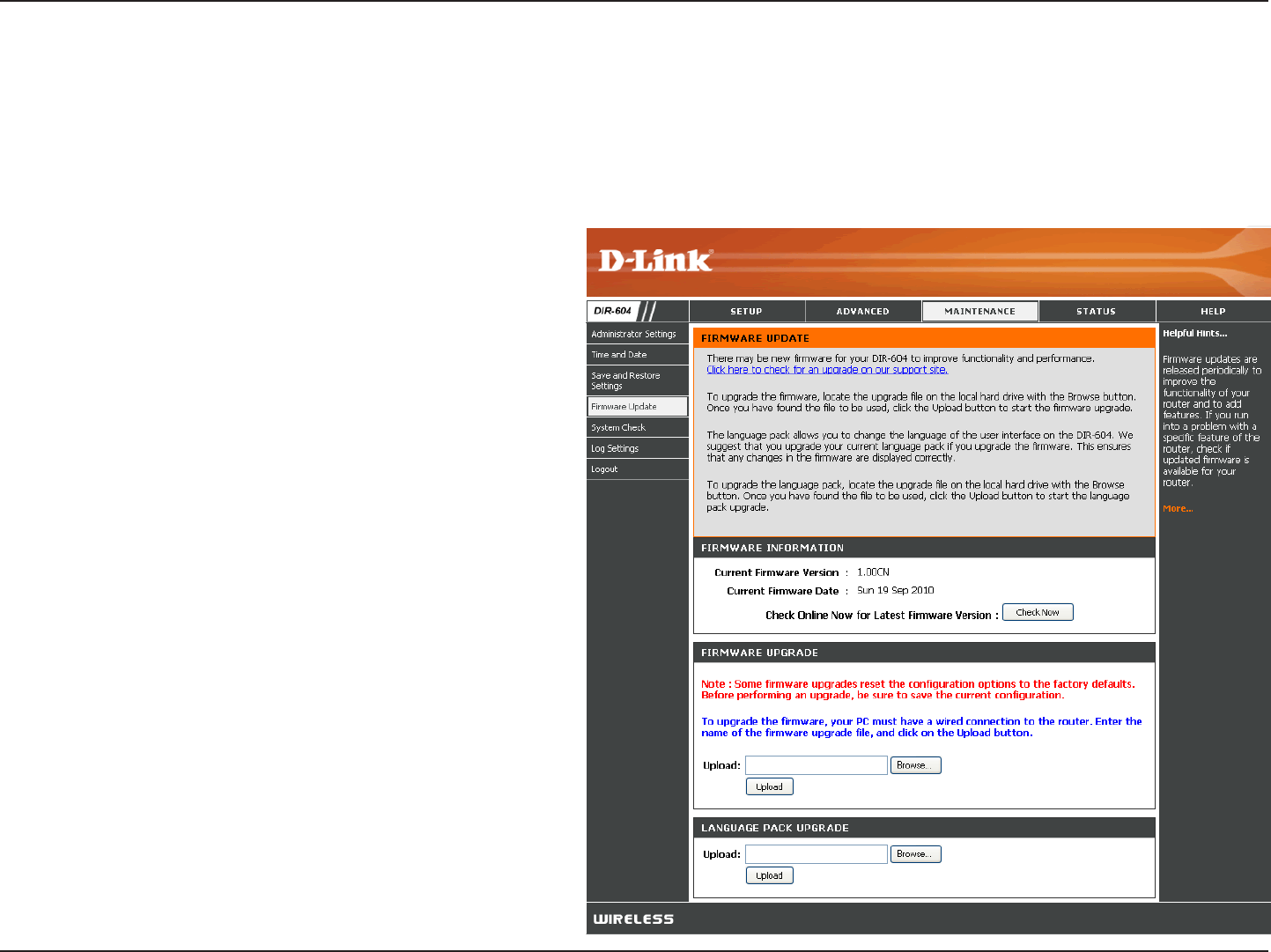
24D-Link DIR-604 User Manual
Section 3 - Configuration
Firmware Update
Displays the current rmware version.
Displays the current rmware date.
Click the Check Now button, or the “Click here
to check for an upgrade on our support site.”
hyperlink at the top of the page, to see what the
latest rmware for the Router is.
After you have downloaded the new rmware,
click the Browse control to locate the rmware
update on your hard drive. Click Upload to
complete the rmware upgrade.
This function allows the user to transfer the
language of the GUI from English to their own
language by upgrading the language pack.
Click the Browse control to locate the desired
language pack on your hard drive. Click Upload
to complete the language pack upgrade.
Current
Firmware
Version:
Current
Firmware
Date:
Check Online
Now for Latest
Firmware
Version:
Firmware
Upgrade:
Language
Pack
Upgrade:
You can upgrade the rmware of the Router here. Please check the D-Link support site for rmware updates at http://
support.dlink.com or simply click the Check Now button located in the Firmware Information section. You can download
rmware upgrades to your hard drive from the D-Link support site. Make sure the rmware you want to use is on the
local hard drive of the computer. Click on Browse to locate the rmware le to be used for the update.
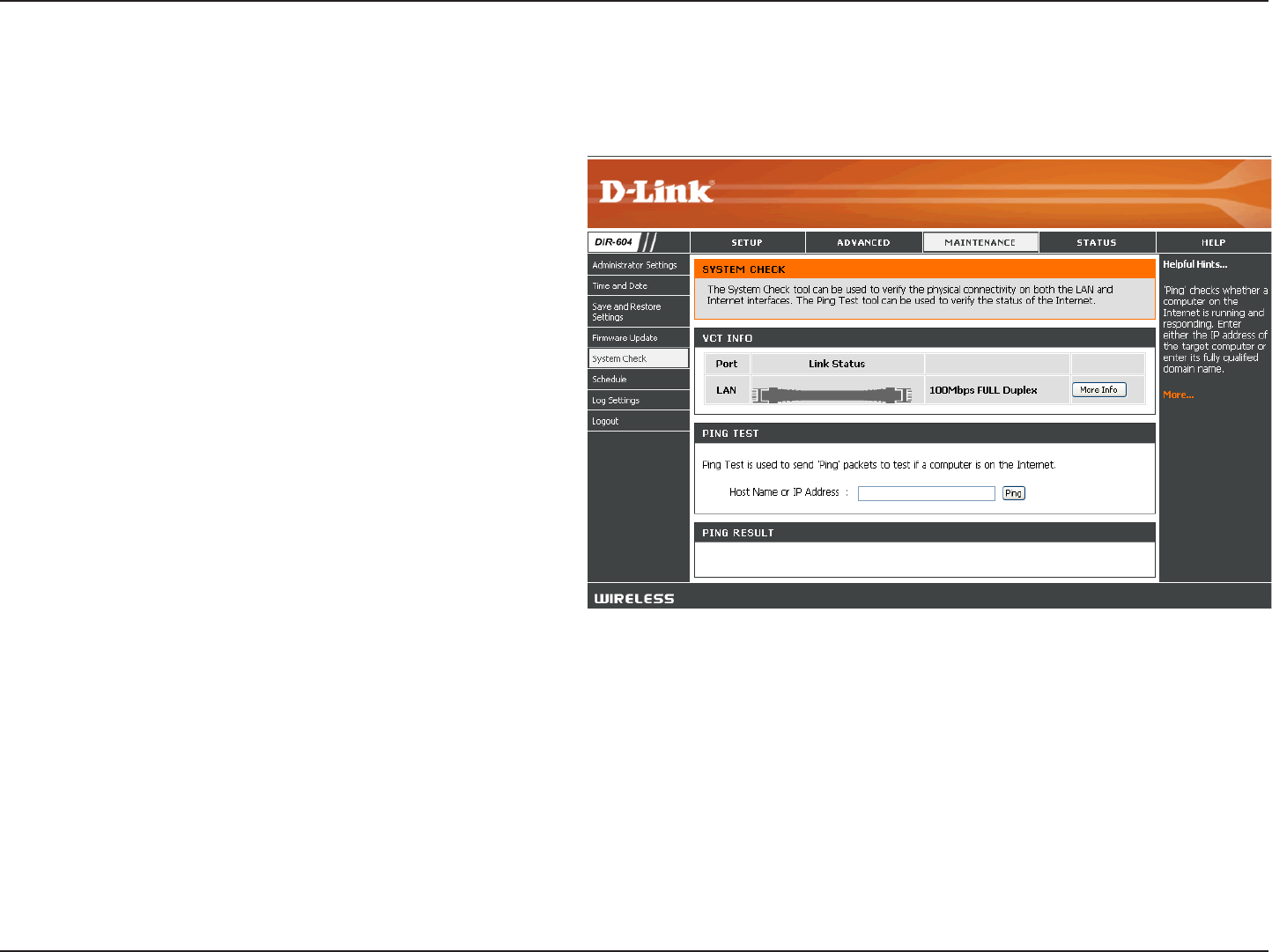
25D-Link DIR-604 User Manual
Section 3 - Configuration
System Check
The Ping Test is used to send Ping packets
to test if a computer is on the Internet. Enter
the IP Address that you wish to Ping, and
click Ping.
The results of your ping attempts will be
displayed here.
Ping Test:
Ping Result:
The System Check feature allows you to verify the physical connectivity on both the LAN and Internet interface.

26D-Link DIR-604 User Manual
Section 3 - Configuration
Log Settings
The Router keeps a running log of events and activities occurring on the device. You can dene what types of events
you want to view and the level of the events to view. The Router also has external Syslog Server support, so you can
send the log les to a computer on your network that is running a Syslog utility.
Click the Save button to save the log le to
your local hard drive.
Tick this check box to send the Router logs to
a SysLog Server.
The address of the SysLog server that will be
used to send the logs. You may also select
your computer from the drop-down menu (only
if receiving an IP address from the Router via
DHCP).
Tick the desired type(s) of logs that should be
displayed: System, Firewall & Security, and
Router Status.
Tick the desired level(s) of importance:
Critical, Warning, and Information.
Enter the e-mail address where you want the
email sent.
Enter a subject description for your e-mail.
This e-mail address will appear as the sender
when you receive a log file or firmware
upgrade notication via e-mail.
Save Log File
to Local Hard
Drive:
Enable
Logging to
Syslog Server:
Syslog Server
IP Address:
Log Type:
Log Level:
Email Address:
Email Subject:
Sender Email
Address:

27D-Link DIR-604 User Manual
Section 3 - Configuration
Click the Save Settings button when you have nished the log settings conguration.
SMTP Server/
IP Address:
User Name:
Password:
Confirm
Password:
Enter the SMTP server address for sending e-mail. If your SMTP server requires authentication, select this option.
Enter your account user name for sending e-mail.
Enter the password associated with the account.
Re-type the password associated with the account and click the Send Mail Now button.
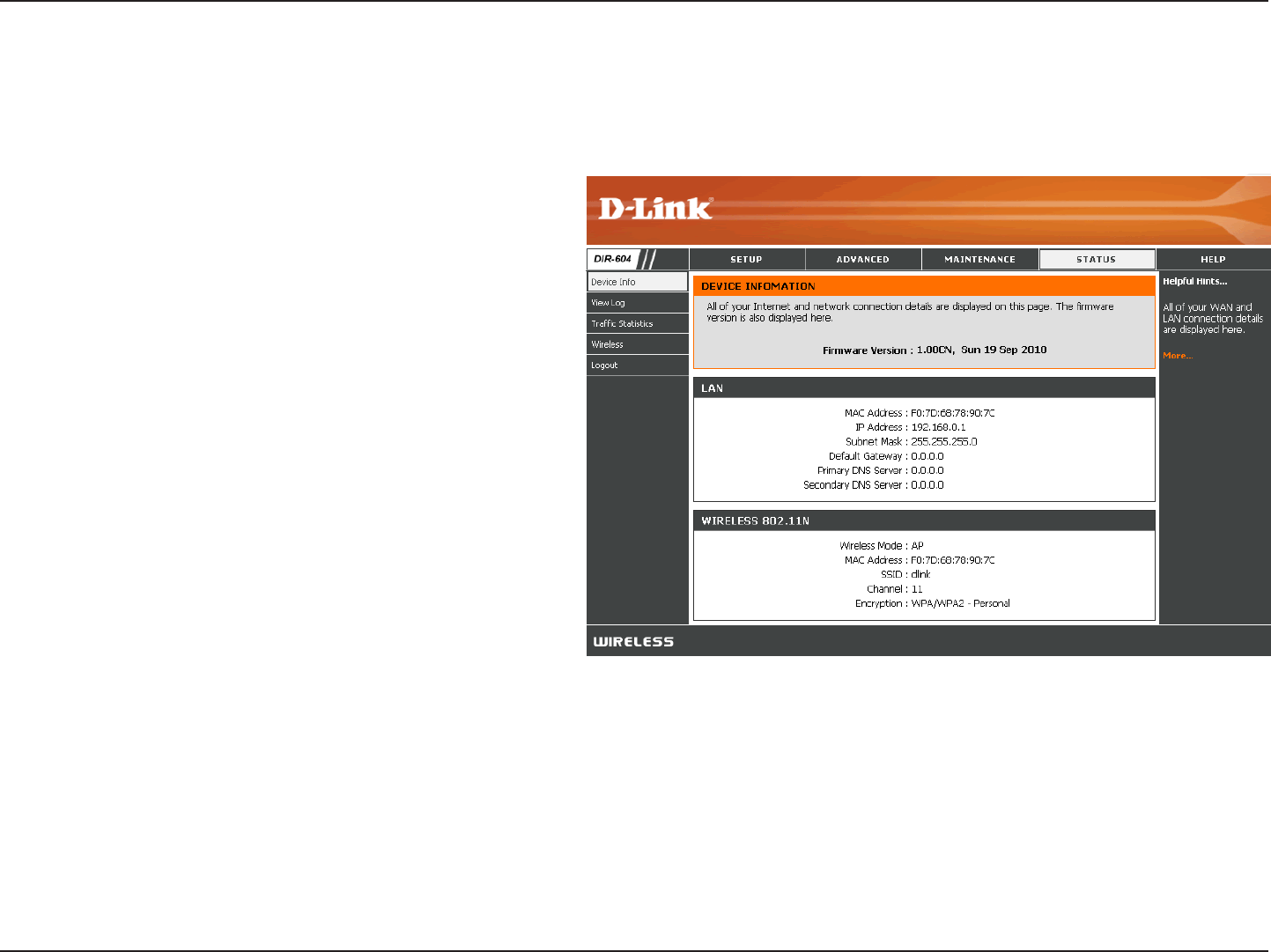
28D-Link DIR-604 User Manual
Section 3 - Configuration
Device Information
This page displays the current information for the DIR-604. It will display the LAN and Wireless information, in addition
to the rmware version and date the rmware was last updated.
If your Internet connection is set up for a Dynamic IP
address then a DHCP Release button and a DHCP
Renew button will be displayed. Use DHCP Release
to disconnect from your ISP and use DHCP Renew
to connect to your ISP.
If your Internet connection is set up for PPPoE,
PPTP, or L2TP, a Connect button and a Disconnect
button will be displayed. Use Disconnect to drop the
Internet connection and use Connect to establish
the Internet connection.See the following for more
information.
LAN:
Wireless
802.11n:
Displays the MAC address and the private
(local) IP settings for the Router.
Displays the wireless mode, MAC address and
your wireless settings such as SSID, Channel,
and Encryption status.

29D-Link DIR-604 User Manual
Section 3 - Configuration
View Log
First Page:
Last Page:
Previous:
Next:
Clear:
Link to Log
Settings:
Click this button to view the rst page of the
log le.
Click this button to view the last page of the
log le.
Click this button to view the previous page of
the log le.
Click this button to view the next page of the
log le.
Clears all of the log contents.
The user can click the button to “ link to log
settings” and save the logs to a local hard drive
or to a Syslog server.
The Router automatically logs (records) events of possible interest in its internal memory. If there is not enough internal
memory for all events, logs of older events are deleted but logs of the latest events are retained. The View Log option
allows you to view the router logs. You can dene what types of events you want to view and the level of the events
to view on the Log Settings page. The Router also has external Syslog Server support, so you can send the log les
to a computer on your network that is running a Syslog utility (see the Log Settings page).
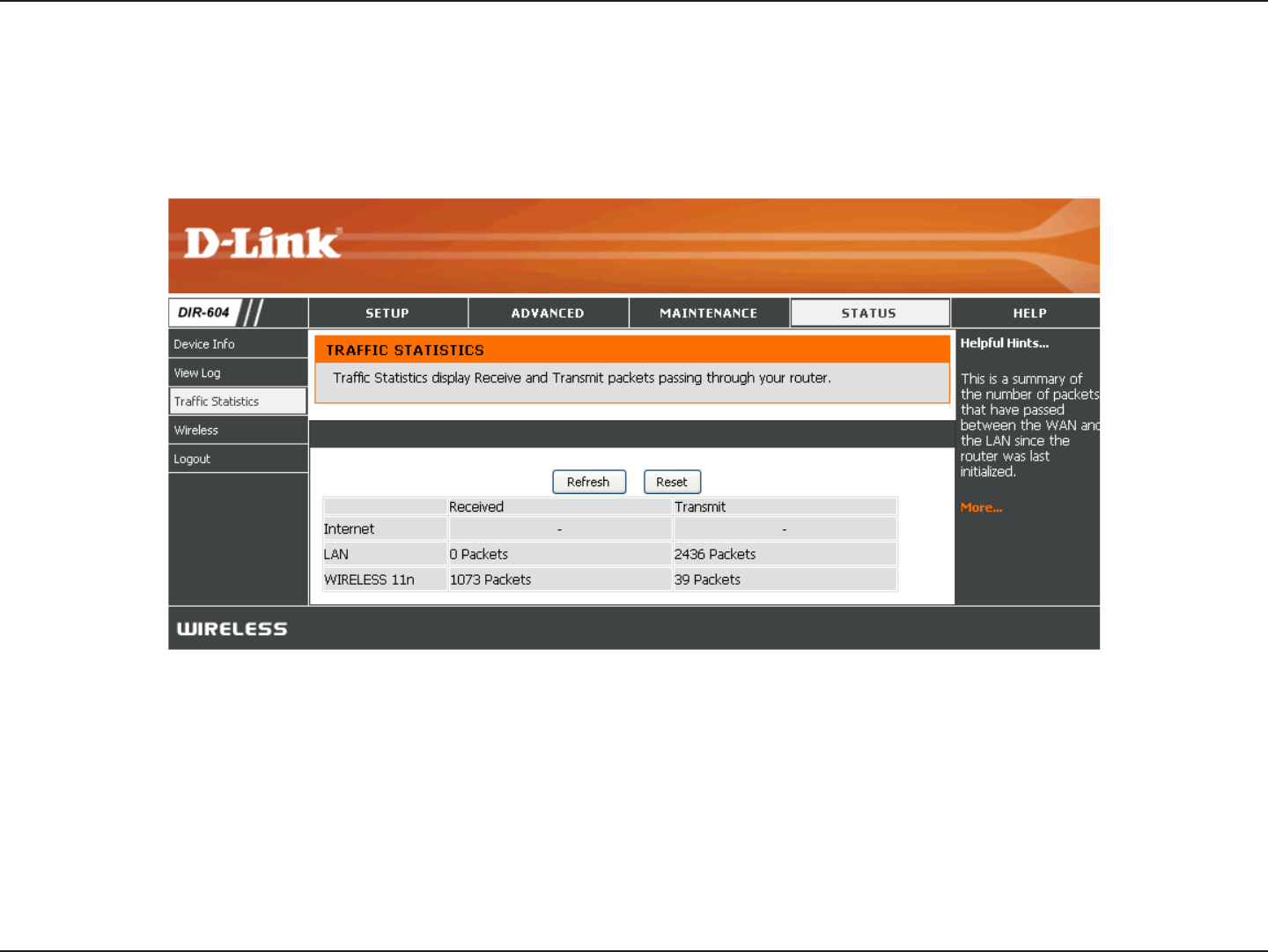
30D-Link DIR-604 User Manual
Section 3 - Configuration
Traffic Statistics
The page displays the Trafc Statistics. Here you can view the amount of packets that pass through the DIR-604 on the
Internet, LAN, and Wireless connections. The trafc counter will reset if the device is rebooted. Alternatively, you can
click either the Reset button or the Refesh button.
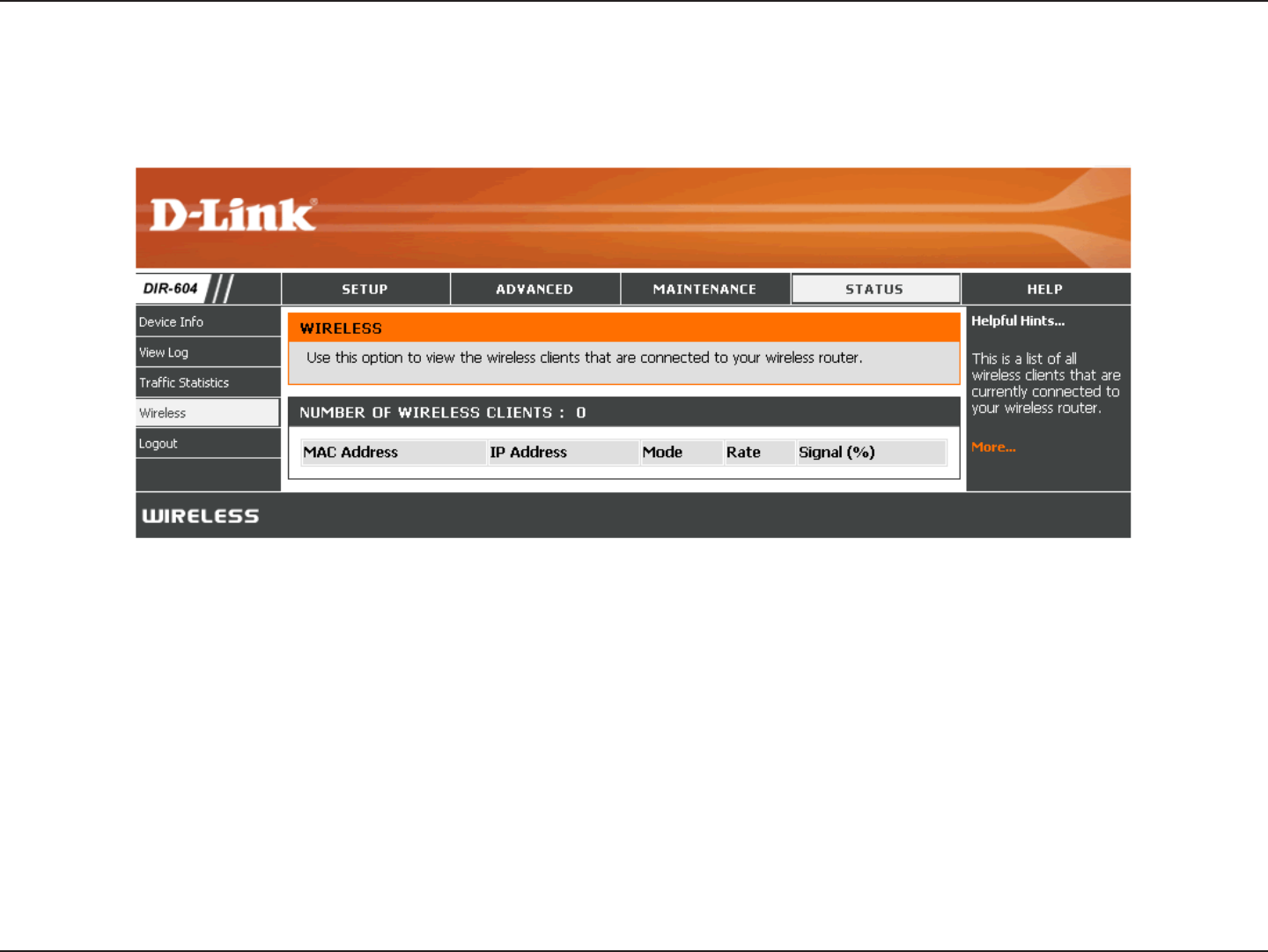
31D-Link DIR-604 User Manual
Section 3 - Configuration
Wireless
The wireless client table displays a list of current connected wireless clients. This table also displays the connection
time and MAC address of the connected wireless clients.
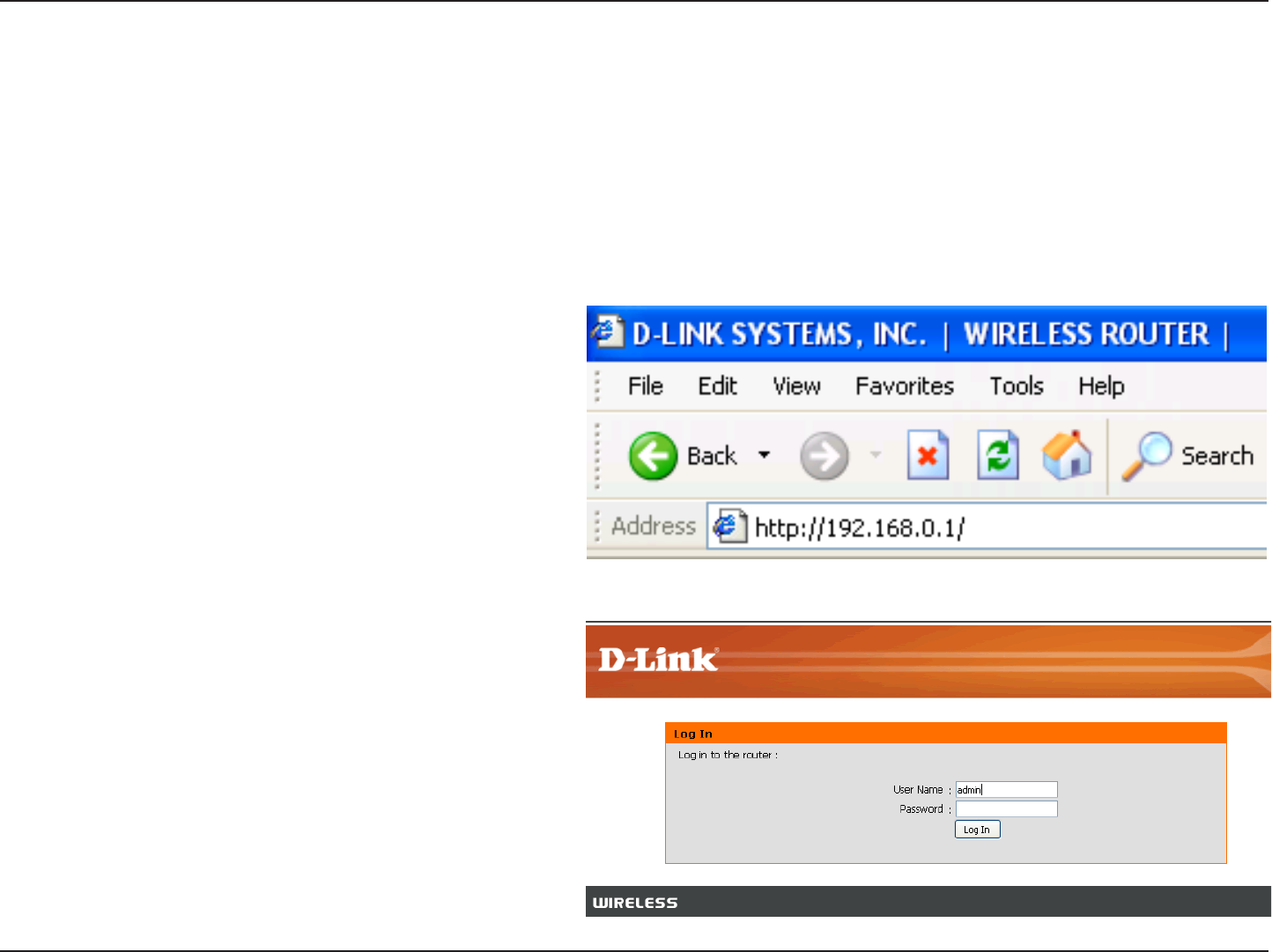
32D-Link DIR-604 User Manual
Section 3 - Configuration
Configuration
This section will show you how to congure your new D-Link wireless Router using the Web-based conguration utility.
Web-based Configuration Utility for Client Mode
To access the conguration utility, open a Web-
browser such as Internet Explorer and enter the IP
address of the router (192.168.0.1).
Type Admin in the User Name eld and then enter
your password. Leave the password blank by default.
Click the Login button to log in to the Router.
If you get a Page Cannot be Displayed error, please
refer to the Troubleshooting section for assistance.

33D-Link DIR-604 User Manual
Section 3 - Configuration
Client Mode Opening Page
Once logged into the Web interface of the Router in Client Mode, the Device Information page will appear. This
displays the MAC Address, Channel, and Encryption status. To make changes to your wireless network, click Setup
to access the Wireless page.

34D-Link DIR-604 User Manual
Section 3 - Configuration
Wireless
Use the Wireless page to make changes to your
wireless conguration.
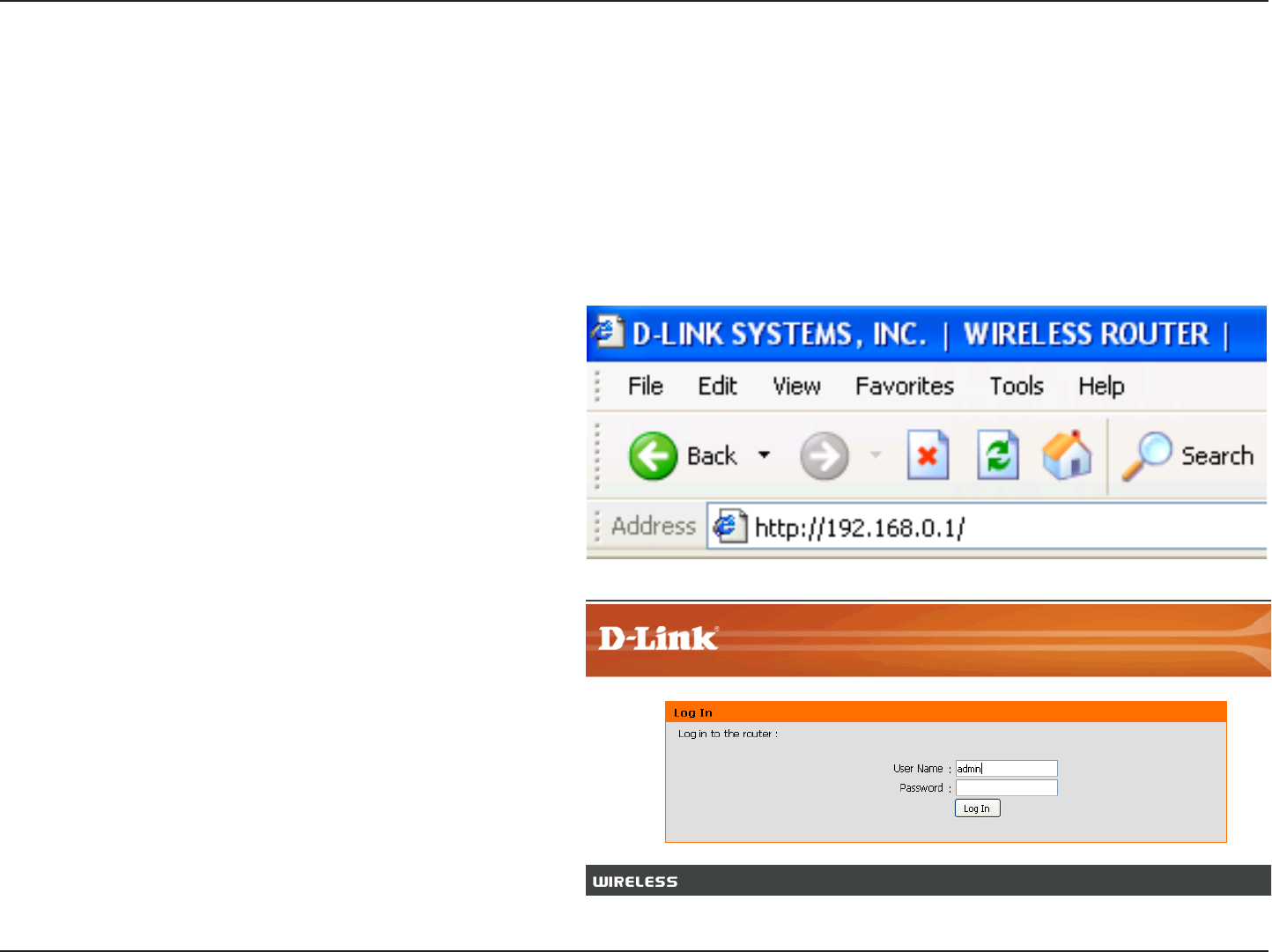
35D-Link DIR-604 User Manual
Section 3 - Configuration
Configuration
This section will show you how to congure your new D-Link wireless Router using the Web-based conguration utility.
Web-based Configuration Utility for Router Mode
To access the conguration utility, open a Web-
browser such as Internet Explorer and enter the IP
address of the router (192.168.0.1).
Type Admin in the User Name eld and then enter
your password. Leave the password blank by default.
Click the Login button to log in to the Router.
If you get a Page Cannot be Displayed error, please
refer to the Troubleshooting section for assistance.
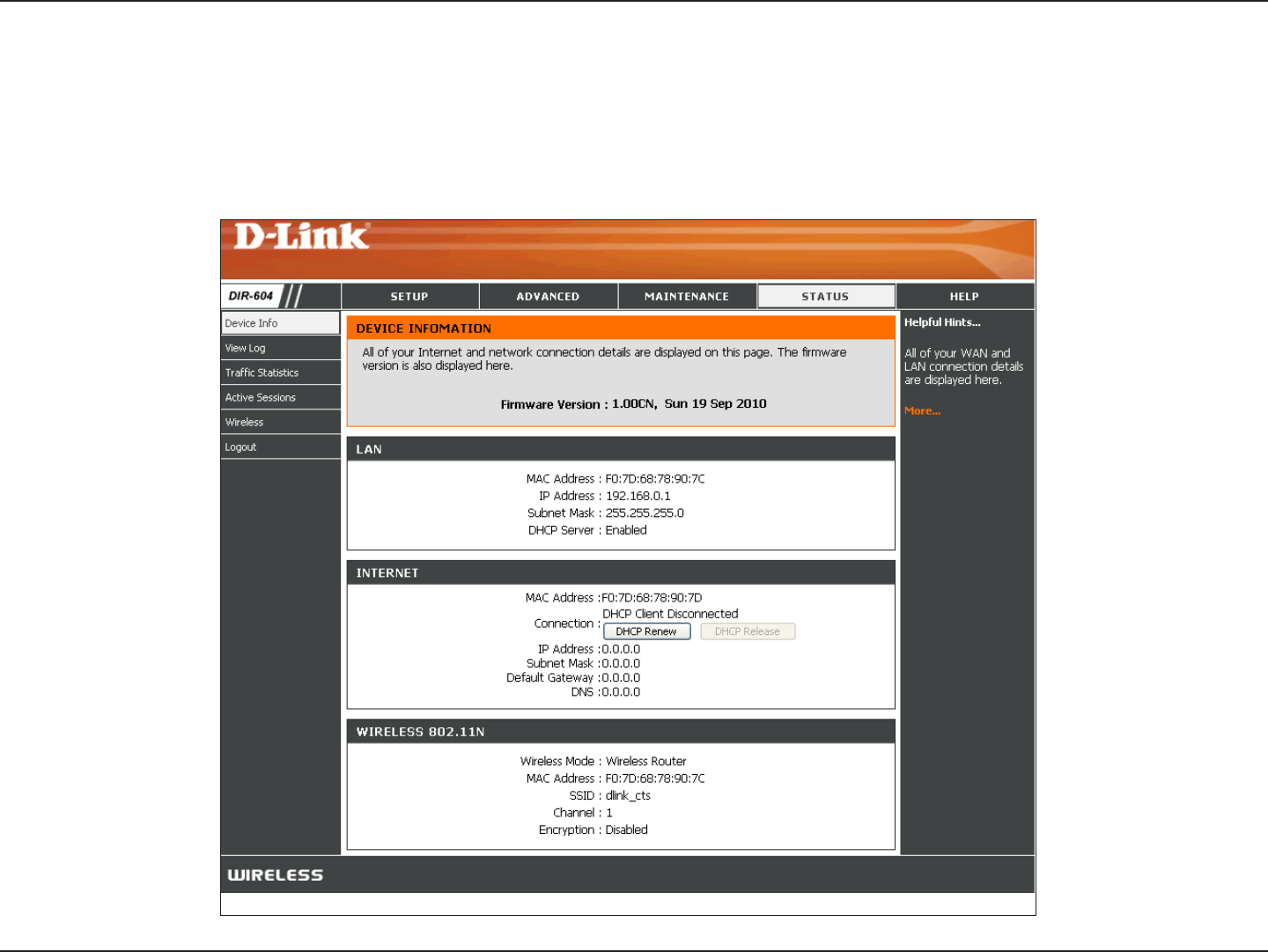
36D-Link DIR-604 User Manual
Section 3 - Configuration
Router Mode Opening Page
Once logged into the Web interface of the Router in Router Mode, the Device Information page will appear. This
displays the LAN’s MAC Address, IP Address, Subnet Mask, and DHCP Server status. This page also displays additional
Internet and Wireless 802.11n information. To make changes to your wireless network, click Setup to access the
Wireless Connection page.
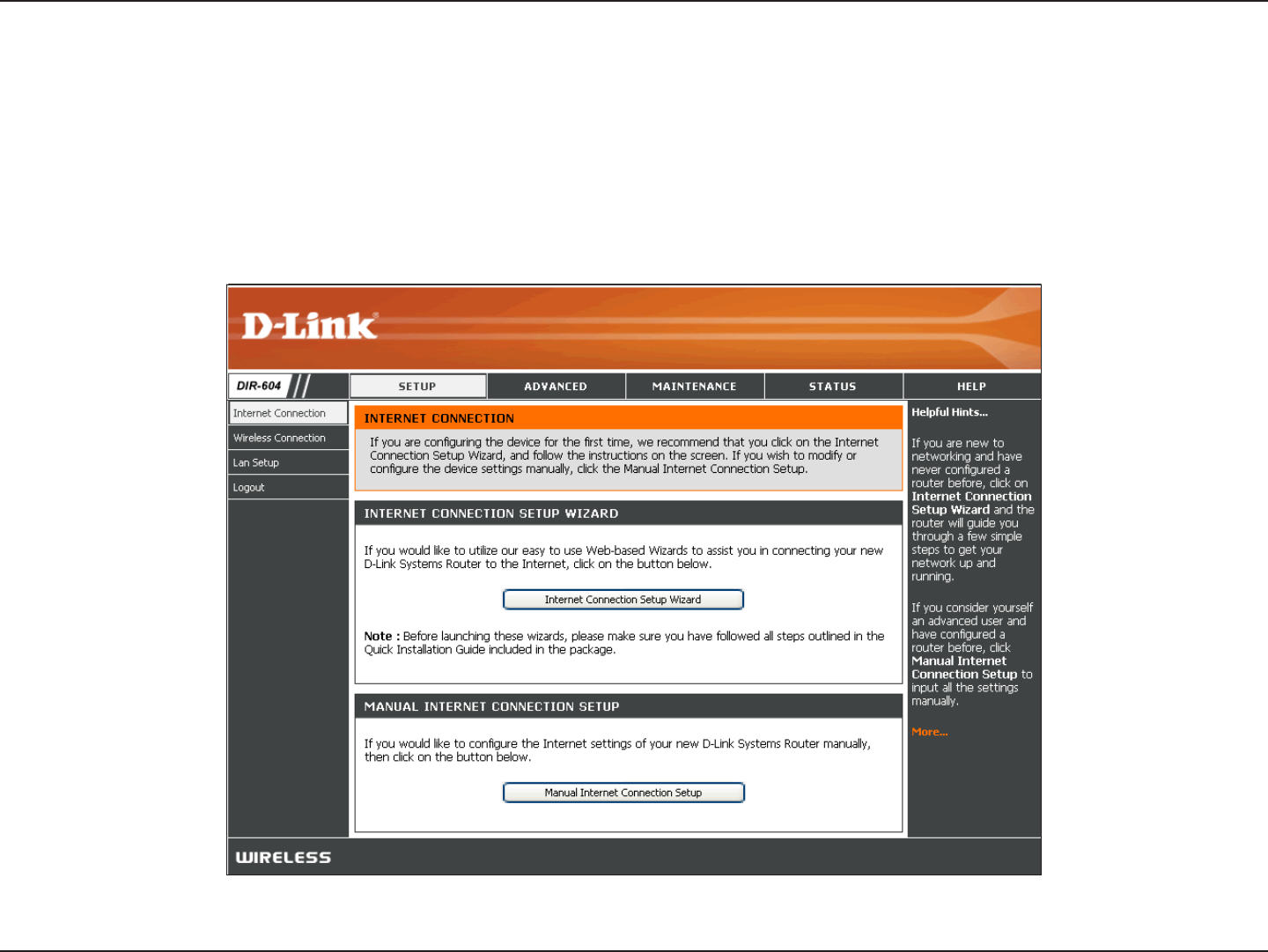
37D-Link DIR-604 User Manual
Section 3 - Configuration
Internet Connection Setup Wizard
Once logged into the Web interface of the Router, the Setup > Internet page will appear. Click the Internet Connection
Setup Wizard button to quickly congure your Router using the setup wizard.
If you want to enter your settings without running the wizard, click Manual Internet Connection Setup and skip to
“Manual Internet Conguration” on page 42.

38D-Link DIR-604 User Manual
Section 3 - Configuration
Click Next to continue.
Create a new password and then click Next to
continue.
Select your time zone and desired NTP server
from the drop-down menus and then click Next to
continue.

39D-Link DIR-604 User Manual
Section 3 - Configuration
To have the Setup Wizard automatically detect the
WAN connection type, select “Yes” and then click
Next.To manually choose your WAN Connection
Mode, select “No, I want to set by manual” and then
click Next to continue.
Select the type of Internet connection you use and
then click Next to continue.
If you selected DHCP Connection (Dynamic IP Address), you
may need to enter the MAC address of the computer that was
last connected directly to your modem. If you are currently
using that computer, click Clone Your PC’s MAC Address
and then click Next to continue.
The Host Name is optional but may be required by some ISPs.
The default host name is the device name of the Router and
may be changed.
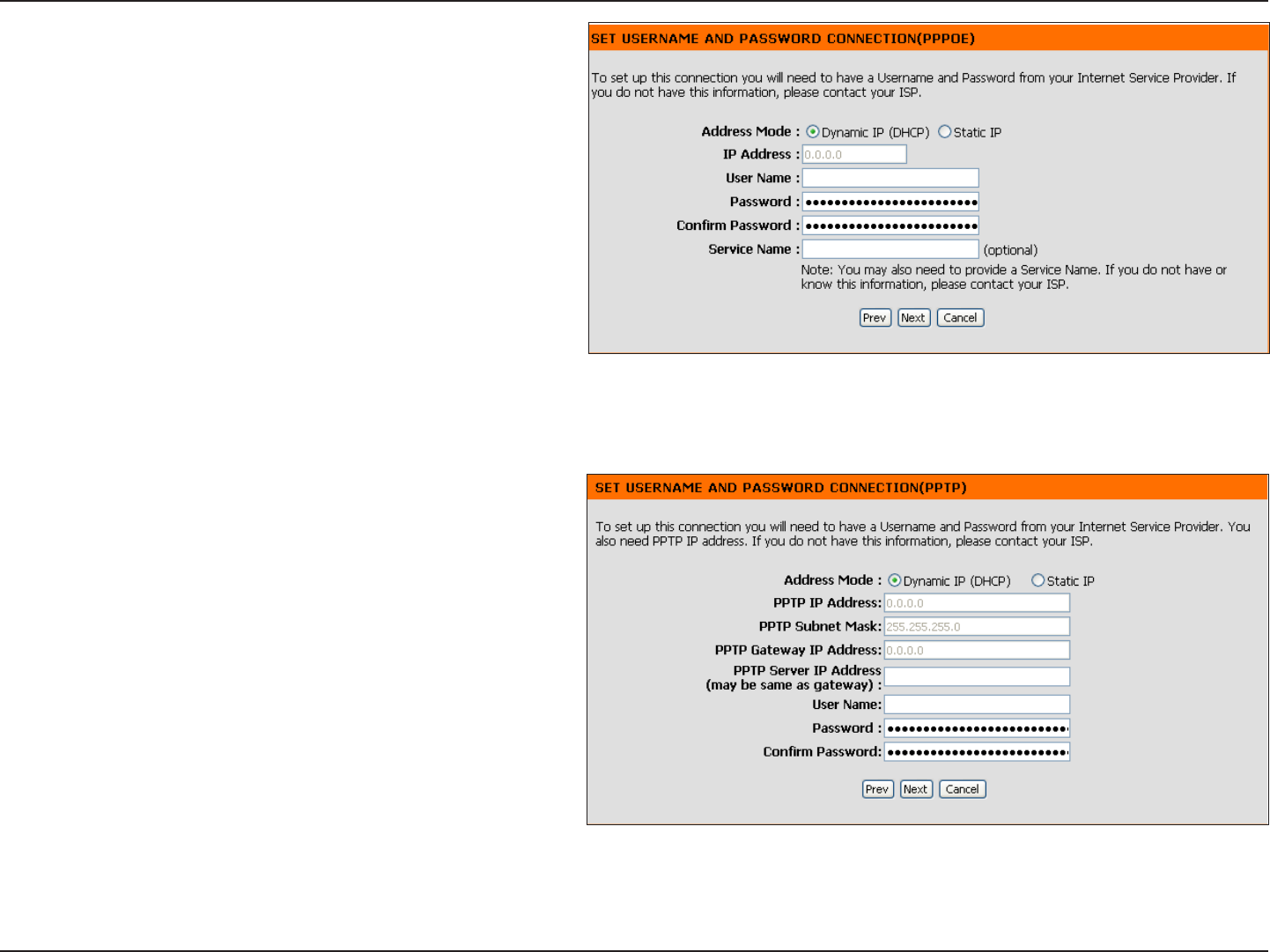
40D-Link DIR-604 User Manual
Section 3 - Configuration
If you selected PPTP, enter your PPTP username and
password. Click Next to continue.
If you selected PPPoE, enter your PPPoE username and
password. Click Next to continue.
Select “Static IP” if your ISP assigned you the IP address,
subnet mask, gateway, and DNS server addresses.
Note: Make sure to remove your PPPoE software from your
computer. The software is no longer needed and will not work
through a router.

41D-Link DIR-604 User Manual
Section 3 - Configuration
If you selected L2TP, enter your L2TP username and
password. Click Next to continue.
If you selected Static, enter your network settings supplied
by your Internet provider. Click Next to continue.
The Setup is now complete. Click the Connect to save your
settings. Please allow 1-2 minutes to connect.

42D-Link DIR-604 User Manual
Section 3 - Configuration
If you opt to set up your Internet connection manually, you will be redirected to a WAN page that allows you to select
your Internet type and enter the correct conguration parameters.
Manual Internet Configuration (Dynamic IP)
Select Dynamic IP (DHCP) to obtain IP address information
automatically from your ISP. Select this option if your ISP
does not give you any IP numbers to use.
The host name is optional but may be required by some
ISPs. Leave blank if you are not sure.
The default MAC address is set to the Internet port’s physical
interface MAC address on the broadband Router. It is not
recommended that you change the default MAC address
unless required by your ISP. You can use the Copy Your
PC’s MAC Address button to replace the Internet port’s
MAC address with the MAC address of your Ethernet card.
Enter the primary DNS server IP address assigned by your
ISP. This address is usually obtained automatically from
your ISP. Leave at 0.0.0.0 if you did not specically receive
an address from your ISP.
Enter the secondary DNS server IP address assigned by
your ISP. This address is usually obtained automatically
from your ISP. Leave at 0.0.0.0 if you did not specically
receive an address from your ISP.
Maximum Transmission Unit. You may need to change the
MTU for optimal performance with your specic ISP. The
default is 1500.
My Internet
Connection
is:
Host Name:
MAC
Address:
Primary DNS
Server:
Secondary
DNS Server:
MTU:
Click the Save Settings button when you have nished conguring the Internet connection.

43D-Link DIR-604 User Manual
Section 3 - Configuration
Choose PPPoE (Point to Point Protocol over Ethernet) if your ISP uses a PPPoE connection. Your ISP will provide
you with a username and password. This option is typically used for DSL services. Make sure to remove your PPPoE
software from your computer. The software is no longer needed and will not work through a router.
Manual Internet Configuration (PPPoE)
Select PPPoE (Username/Password) to obtain IP address
information automatically from your ISP. Select this option
if your ISP does not give you any IP numbers to use.
Select Static IP if your ISP assigned you the IP address,
subnet mask, gateway, and DNS server addresses. In most
cases, users will select Dynamic IP (DHCP).
Enter your PPPoE user name.
Enter your PPPoE password.
Retype the PPPoE password entered above.
Enter the ISP service name (optional).
Enter the IP address (Static PPPoE only).
The default MAC address is set to the Internet port’s physical
interface MAC address on the broadband Router. It is not
recommended that you change the default MAC address
unless required by your ISP. You can use the Copy Your
PC’s MAC Address button to replace the Internet port’s MAC
address with the MAC address of your Ethernet card.
Enter the primary DNS server address (Static PPPoE only).
My Internet
Connection
is:
Address
Mode:
User Name:
Password:
Confirm
Password:
Service
Name:
IP Address:
MAC
Address:
Primary DNS
Server:

44D-Link DIR-604 User Manual
Section 3 - Configuration
Click the Save Settings button when you have nished conguring the Internet connection.
Secondary DNS
Server:
Maximum Idle
Time:
MTU:
Connection
Mode Select:
I need sniper:
Special Dial
Mode:
Enter the secondary DNS server address (Static PPPoE only).
Enter a maximum idle time during which the Internet connection is maintained during inactivity. To disable this feature, select
either Always or Manual for the Connection mode select setting below.
Maximum Transmission Unit. You may need to change the MTU for optimal performance with your specic ISP. The default
is 1492.
Select either Always, Manual, or Connection On-Demand. Click the Add New button to create a new connection.
Tick the check box to indicate you want to use the sniper feature.
Select normal dial mode (default) or special dial mode 1, special mode 2, special mode 3, special mode 4, special
mode 5, or special mode 6.
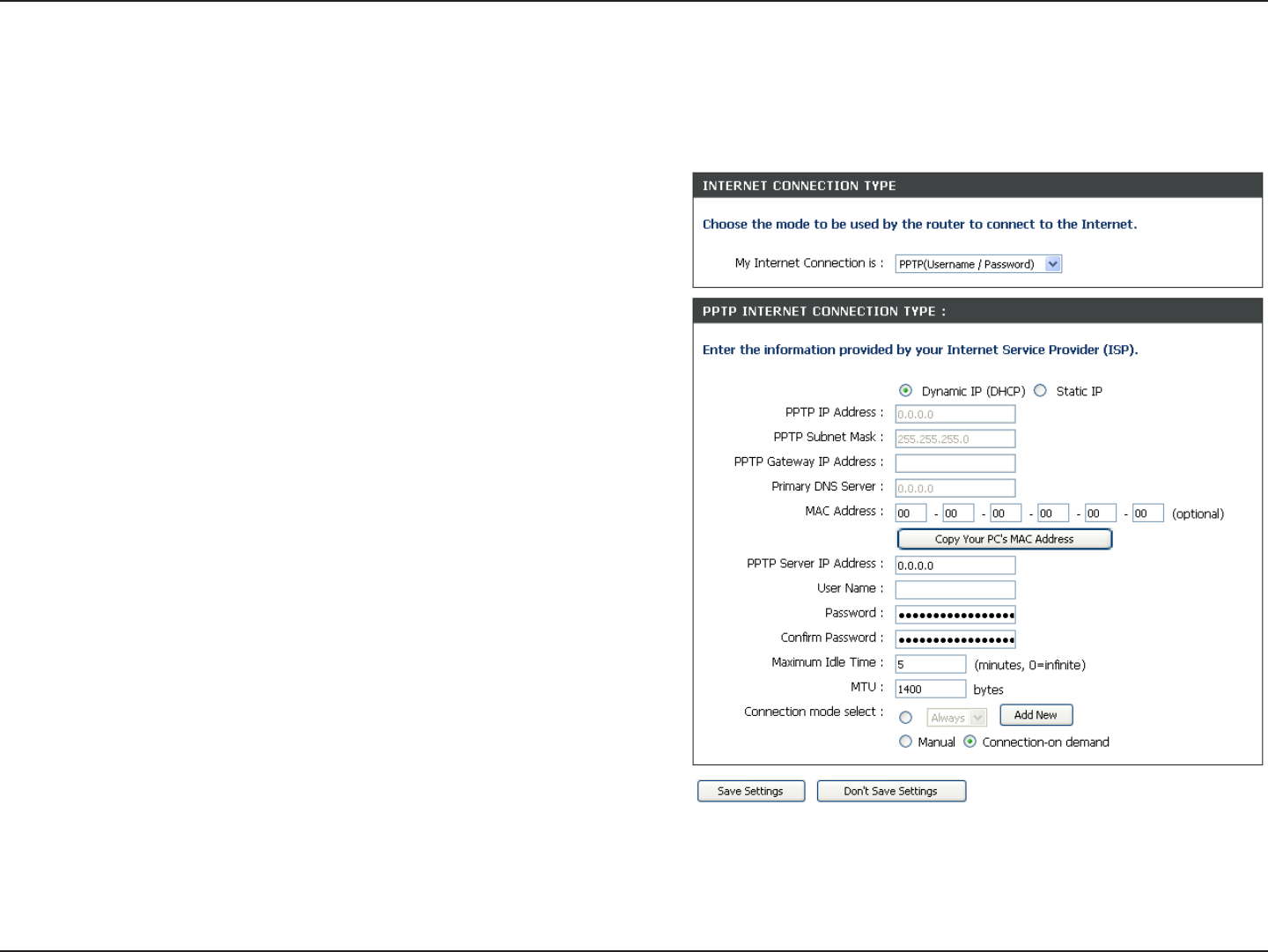
45D-Link DIR-604 User Manual
Section 3 - Configuration
Choose PPTP (Point-to-Point-Tunneling Protocol ) if your ISP uses a PPTP connection. Your ISP will provide you with
a username and password. This option is typically used for DSL services.
Manual Internet Configuration (PPTP)
Select PPTP (Username/Password) to obtain IP Address
information automatically from your ISP.
Select Static IP if your ISP assigned you the IP address,
subnet mask, gateway, and DNS server addresses. In most
cases, users will select Dynamic IP (DHCP).
Enter the IP address (Static PPTP only).
Enter the subnet mask (Static PPTP only).
Enter the gateway IP address provided by your ISP.
Enter the primary DNS server address (Static PPTP only).
The default MAC address is set to the Internet port’s physical
interface MAC address on the broadband Router. It is not
recommended that you change the default MAC address
unless required by your ISP. You can use the Copy Your
PC’s MAC Address button to replace the Internet port’s MAC
address with the MAC address of your Ethernet card.
Enter the server IP address provided by your ISP (optional).
Enter your PPTP user name.
My Internet
Connection is:
Address Mode:
PPTP IP
Address:
PPTP Subnet
Mask:
PPTP Gateway
IP Address:
Primary DNS
Server:
MAC Address:
PPTP Server IP
Address:
User Name:

46D-Link DIR-604 User Manual
Section 3 - Configuration
Click the Save Settings button when you have nished conguring the Internet connection.
Password:
Confirm
Password:
Maximum Idle
Time:
MTU:
Connection
Mode Select:
Enter your PPTP password.
Retype the PPTP password entered above.
Enter a maximum idle time during which the Internet connection is maintained during inactivity. To disable this feature, select
either Always or Manual for the Connection mode select setting below.
Maximum Transmission Unit. You may need to change the MTU for optimal performance with your specic ISP. The default
is 1400.
Select either Always, Manual, or Connection On-Demand. Click the Add New button to create a new connection.
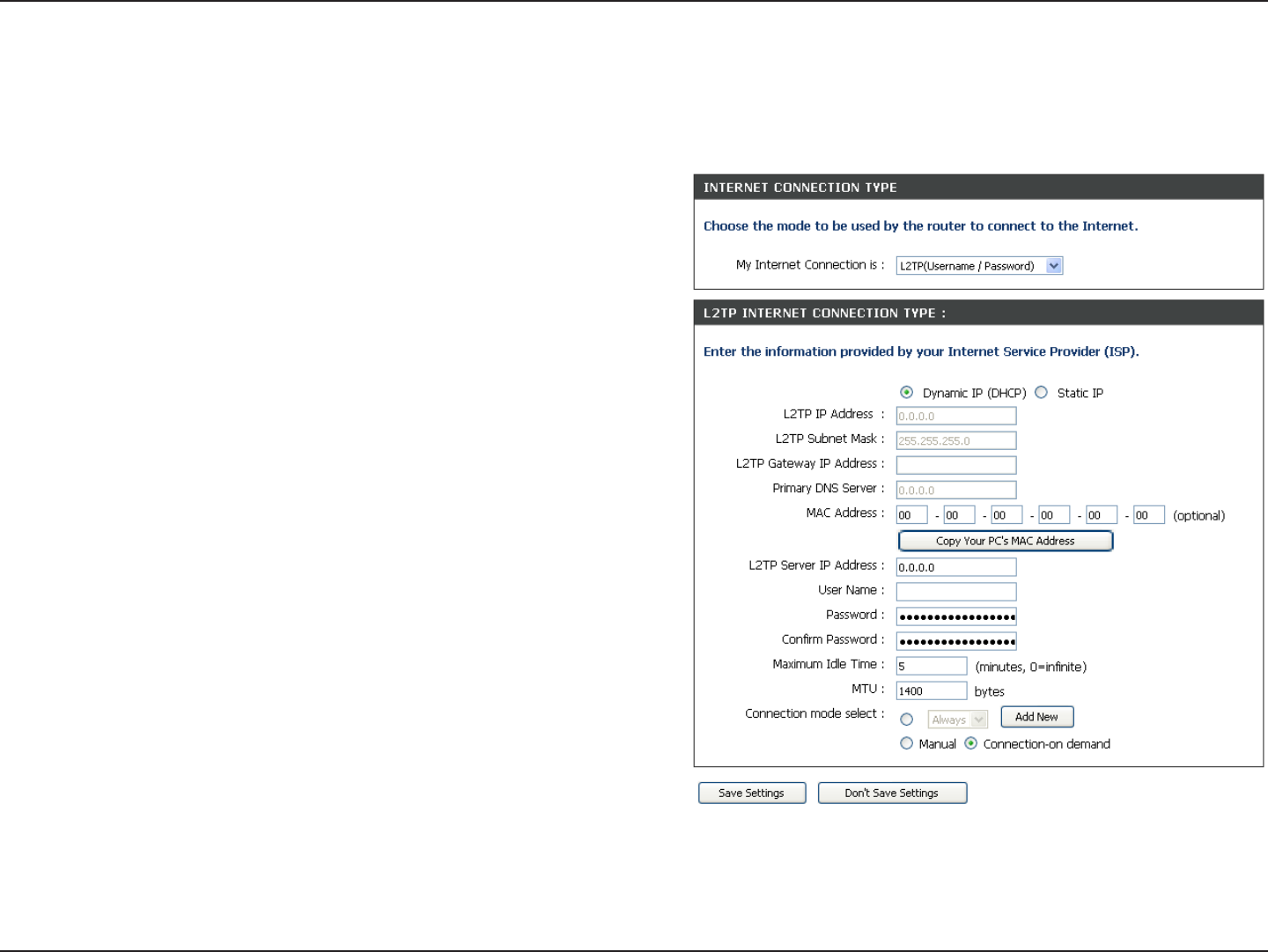
47D-Link DIR-604 User Manual
Section 3 - Configuration
Choose L2TP (Layer 2 Tunneling Protocol ) if your ISP uses a L2TP connection. Your ISP will provide you with a
username and password. This option is typically used for DSL services.
Manual Internet Configuration (L2TP)
Select L2TP (Username/Password) to obtain IP Address
information automatically from your ISP.
Select Static IP if your ISP assigned you the IP address,
subnet mask, gateway, and DNS server addresses. In most
cases, users will select Dynamic IP (DHCP).
Enter the IP address (Static L2TP only).
Enter the subnet mask (Static L2TP only).
Enter the gateway IP address provided by your ISP.
Enter the primary DNS server Address (Static L2TP only).
The default MAC address is set to the Internet port’s physical
interface MAC address on the broadband Router. It is not
recommended that you change the default MAC address
unless required by your ISP. You can use the Copy Your
PC’s MAC Address button to replace the Internet port’s MAC
address with the MAC address of your Ethernet card.
Enter the server IP address provided by your ISP (optional).
Enter your L2TP user name.
My Internet
Connection is:
Address Mode:
L2TP IP
Address:
L2TP Subnet
Mask:
L2TP Gateway
IP Address:
Primary DNS
Server:
MAC Address:
L2TP Server IP
Address:
User Name:

48D-Link DIR-604 User Manual
Section 3 - Configuration
Click the Save Settings button when you have nished conguring the Internet connection.
Password:
Confirm
Password:
Maximum Idle
Time:
MTU:
Connection
Mode Select:
Enter your L2TP password.
Retype the L2TP password entered above.
Enter a maximum idle time during which the Internet connection is maintained during inactivity. To disable this feature, select
either Always or Manual for the Connection mode select setting below.
Maximum Transmission Unit. You may need to change the MTU for optimal performance with your specic ISP. The default
is 1400.
Select either Always, Manual, or Connection On-Demand. Click the Add New button to create a new connection.
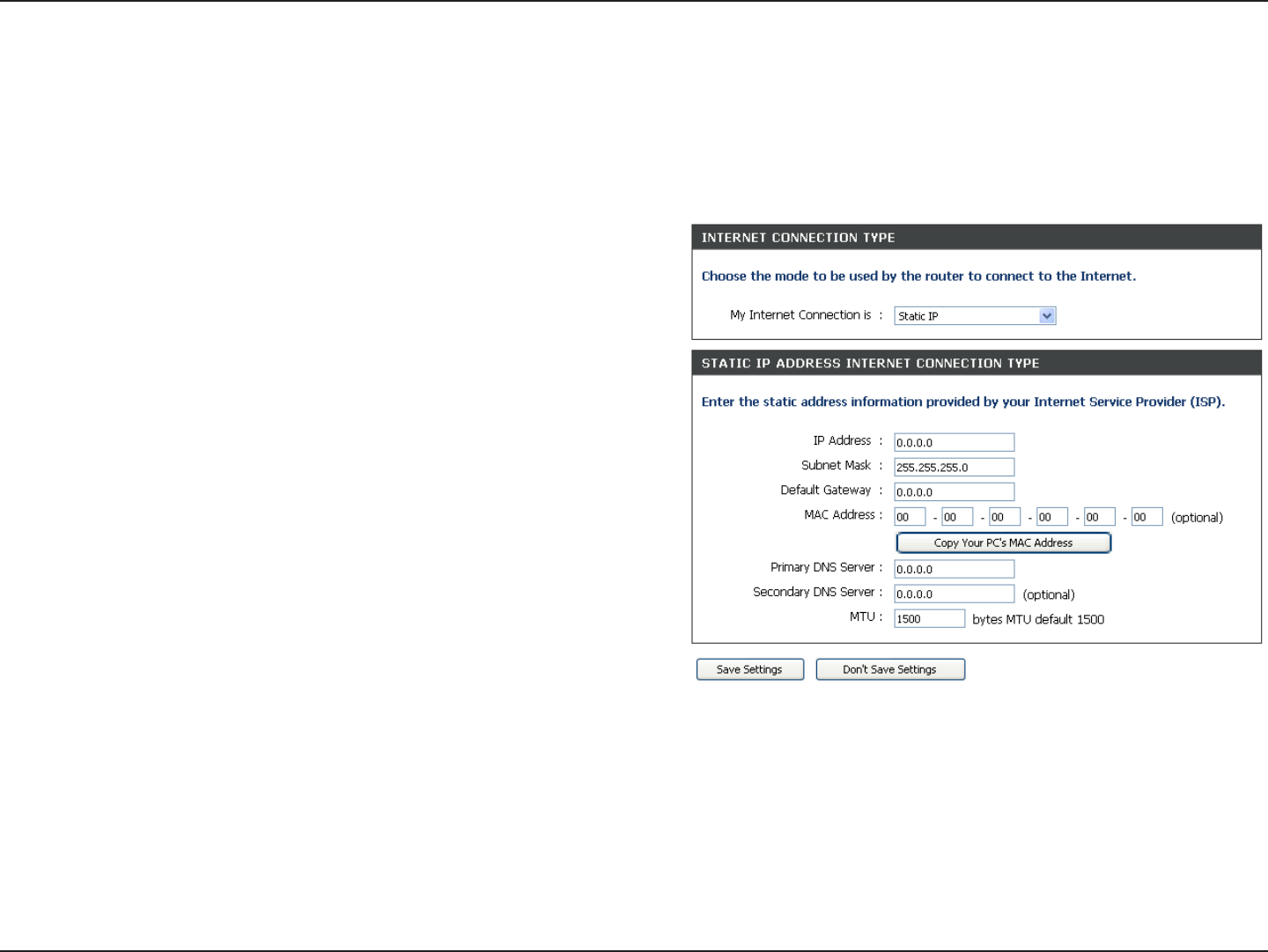
49D-Link DIR-604 User Manual
Section 3 - Configuration
Select Static IP Address if all the Internet port’s IP information is provided to you by your ISP. You will need to enter in
the IP address, subnet mask, gateway address, and DNS address(es) provided to you by your ISP. Each IP address
entered in the elds must be in the appropriate IP form, which are four octets separated by a dot (x.x.x.x). The Router
will not accept the IP address if it is not in this format.
Manual Internet Configuration (Static IP)
Select Static IP if you want to manually enter information
provided by your ISP.
Enter the IP address assigned by your ISP.
Enter the subnet mask assigned by your ISP.
Enter the gateway IP address provided by your ISP.
The default MAC address is set to the Internet port’s physical
interface MAC address on the broadband Router. It is not
recommended that you change the default MAC address
unless required by your ISP. You can use the Copy Your
PC’s MAC Address button to replace the Internet port’s
MAC address with the MAC address of your Ethernet card.
Enter the primary DNS server address provided by your ISP.
Enter the secondary DNS server address provided by your
ISP.
Maximum Transmission Unit. You may need to change the
MTU for optimal performance with your specic ISP. The
default is 1500.
My Internet
Connection is:
IP Address:
Subnet Mask:
Default
Gateway:
MAC Address:
Primary DNS
Server:
Secondary
DNS Server:
MTU:
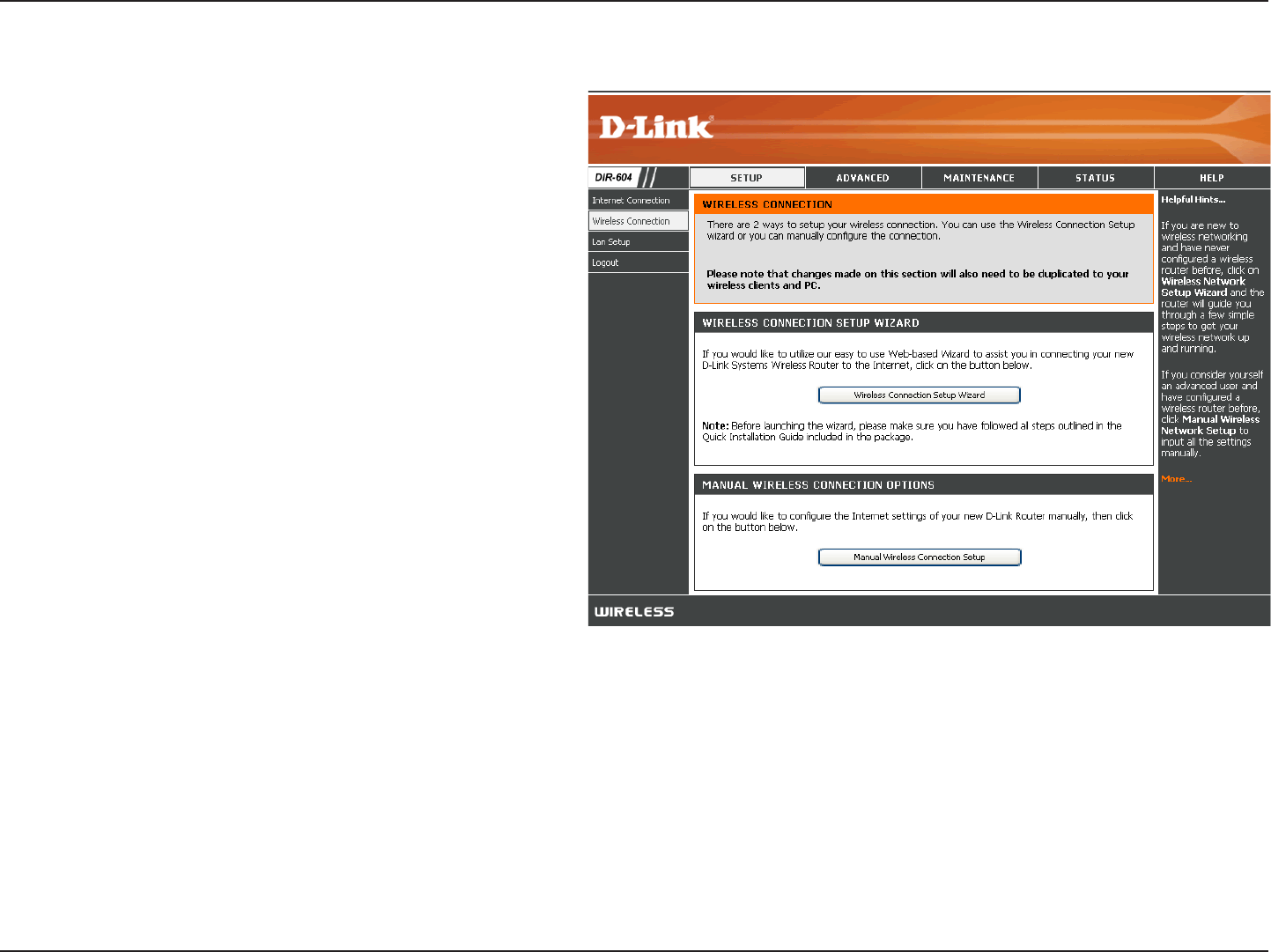
50D-Link DIR-604 User Manual
Section 3 - Configuration
Wireless Connections
If you want to congure the wireless settings on your
Router using the wizard, click Wireless Connection
Setup Wizard and refer to “Wireless Connection
Setup Wizard” on page 81.
If you want to manually congure the wireless settings
on your Router, click Manual Wireless Connection
Setup and refer to the next page.

51D-Link DIR-604 User Manual
Section 3 - Configuration
Manual Wireless Network Setup
Tick the check box to enable the wireless
function. If you do not want to use wireless, de-
select the check box to disable all the wireless
functions.
Service Set Identier (SSID) is the name of your
wireless network. Create a name using up to 32
characters. The SSID is case-sensitive.
The Auto Channel Scan setting can be selected
to allow the DIR-604 to choose the channel with
the least amount of interference.
Indicates the channel setting for the DIR-604.
By default the channel is set to 6. The Channel
can be changed to t the channel setting for an
existing wireless network or to customize the
wireless network. If you enable Auto Channel
Scan, this option will be grayed out.
Select the transmit rate. It is strongly suggested
to select Best (automatic) for best performance.
WMM (Wi-Fi Multimedia) is QoS for your
wireless network. Check this box to improve the
quality of video and voice applications for your
wireless clients. This feature is not available in
802.11n congurations.
Enable
Wireless:
Wireless
Network Name
(SSID):
Enable Auto
Channel
Selection:
Wireless
Channel:
Transmission
Rate:
WMM Enable:
Enable Hidden
Wireless:
Enabling Hidden Mode is another way to secure your network. With this option enabled, no wireless clients will
be able to see your wireless network when they perform a scan to see what’s available. In order for your wireless
devices to connect to your Router, you will need to manually enter the Wireless Network Name on each device.
Refer to Section 4 - Wireless Security for more information regarding wireless security.
Security
Mode:
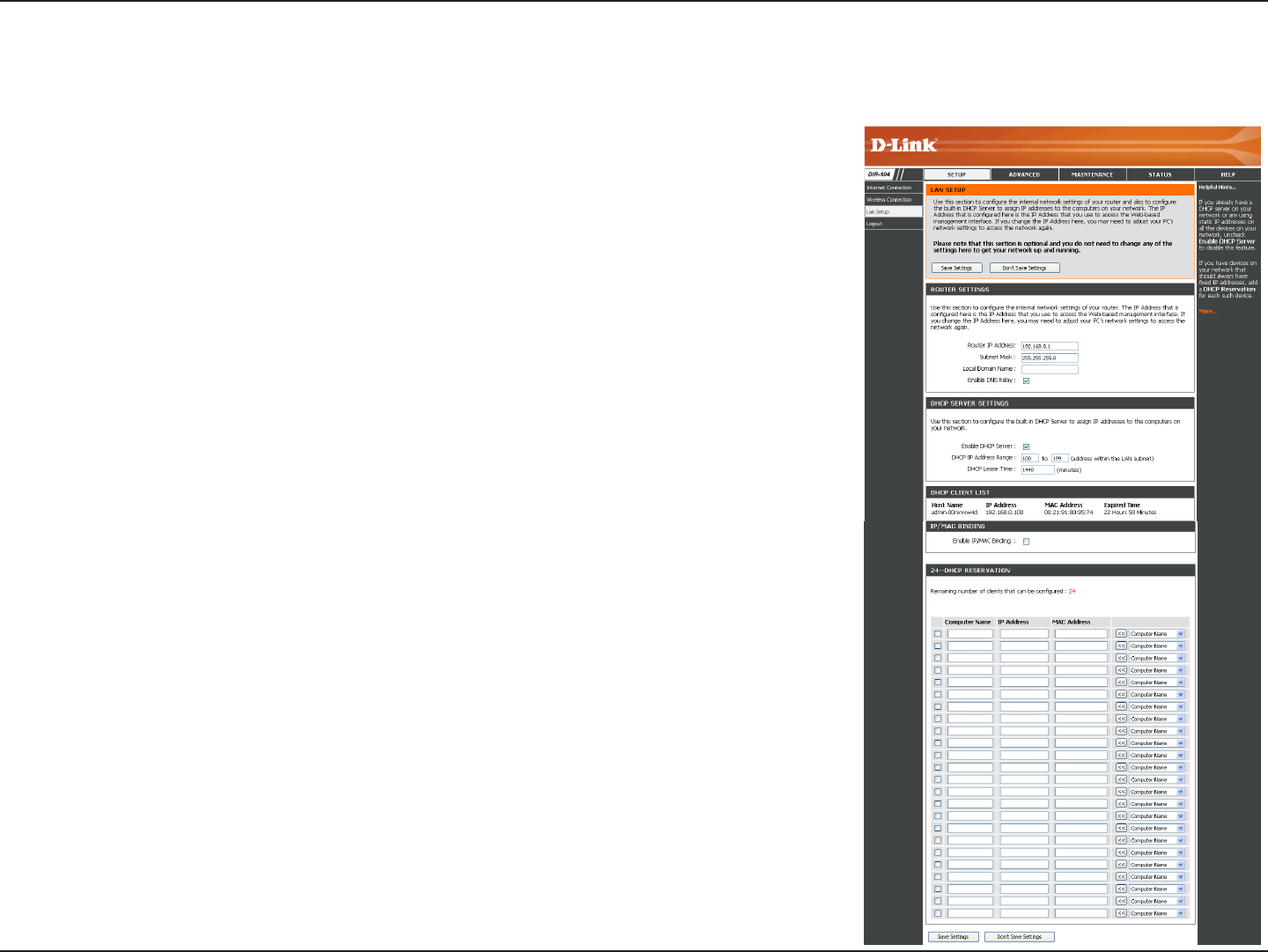
52D-Link DIR-604 User Manual
Section 3 - Configuration
LAN Setup
This section will allow you to change the internal network settings of the Router and to congure the DHCP settings.
Enter the IP address of the Router. The default IP address is 192.168.0.1.
If you change the IP address, once you click Save Settings, you will need to
enter the new IP address in your browser to get back into the conguration
utility.
Enter the subnet mask. The default subnet mask is 255.255.255.0.
Enter the primary DNS server IP address.
Enter the secondary DNS server IP address.
Tick this check box to enable the DHCP server on your Router. De-select
to disable this function.
Enter the starting and ending IP addresses for the DHCP server’s IP
assignment.
Note: If you statically (manually) assign IP addresses to your computers or
devices, make sure the IP addresses are outside of this range or you may
have an IP conict.
Router
IP Address:
Subnet Mask:
Local Domain
Name:
Enable DNS Relay:
Enable
DHCP Server:
DHCP IP Address
Range:
DHCP Lease Time:
DHCP Client List:
Enable IP/MAC
Binding:
The length of time for the IP address lease. Enter the Lease time in
minutes.
Displays a list of the DHCP reservations that have been congured on the
Router. See the DHCP Reservation section on the next page for more info.
Tick to enable IP/MAC binding.
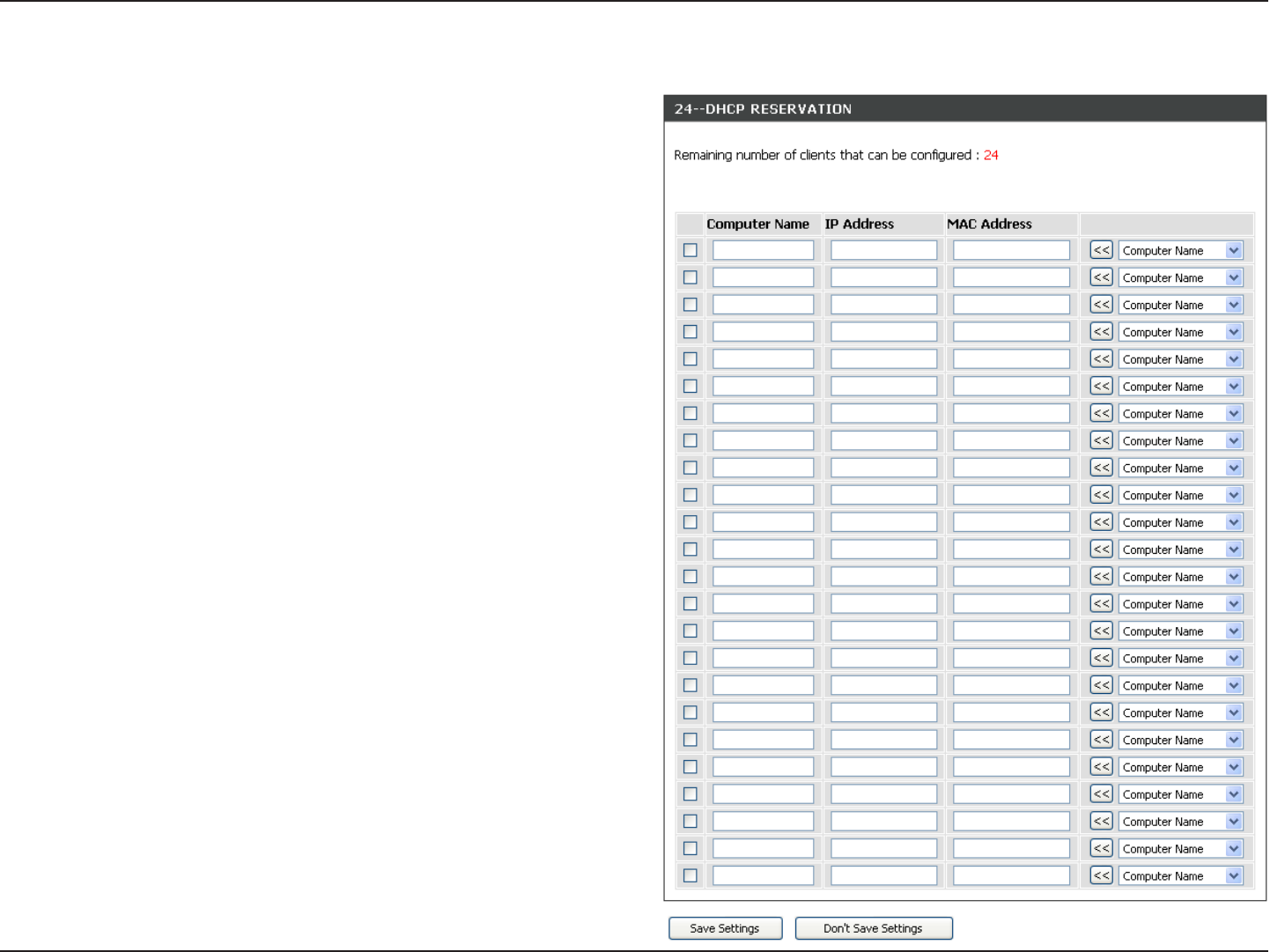
53D-Link DIR-604 User Manual
Section 3 - Configuration
DHCP Reservation
If you want a computer or device to always have the same
IP address assigned, you can create a DHCP reservation.
The Router will assign the IP address only to that computer
or device.
Congure the parameters, as described below, to create a
new DHCP Reservation.
Note: This IP address must be within the DHCP IP address
range.
Enter the computer name or select a computer name
from the drop-down menu on the right-hand side and
click <<.
Enter the IP address you want to assign to the computer
or device. This IP Address must be within the DHCP IP
Address Range.
Enter the MAC address of the computer or device.
Computer
Name:
IP Address:
MAC Address:
When you have nished conguring the above settings, tick
the check boxes next to the DHCP Reservation entries you
want to add to the DHCP Reservations List and click the
Save Settings button at the top or bottom of the window to
save your entries and activate your reservations.
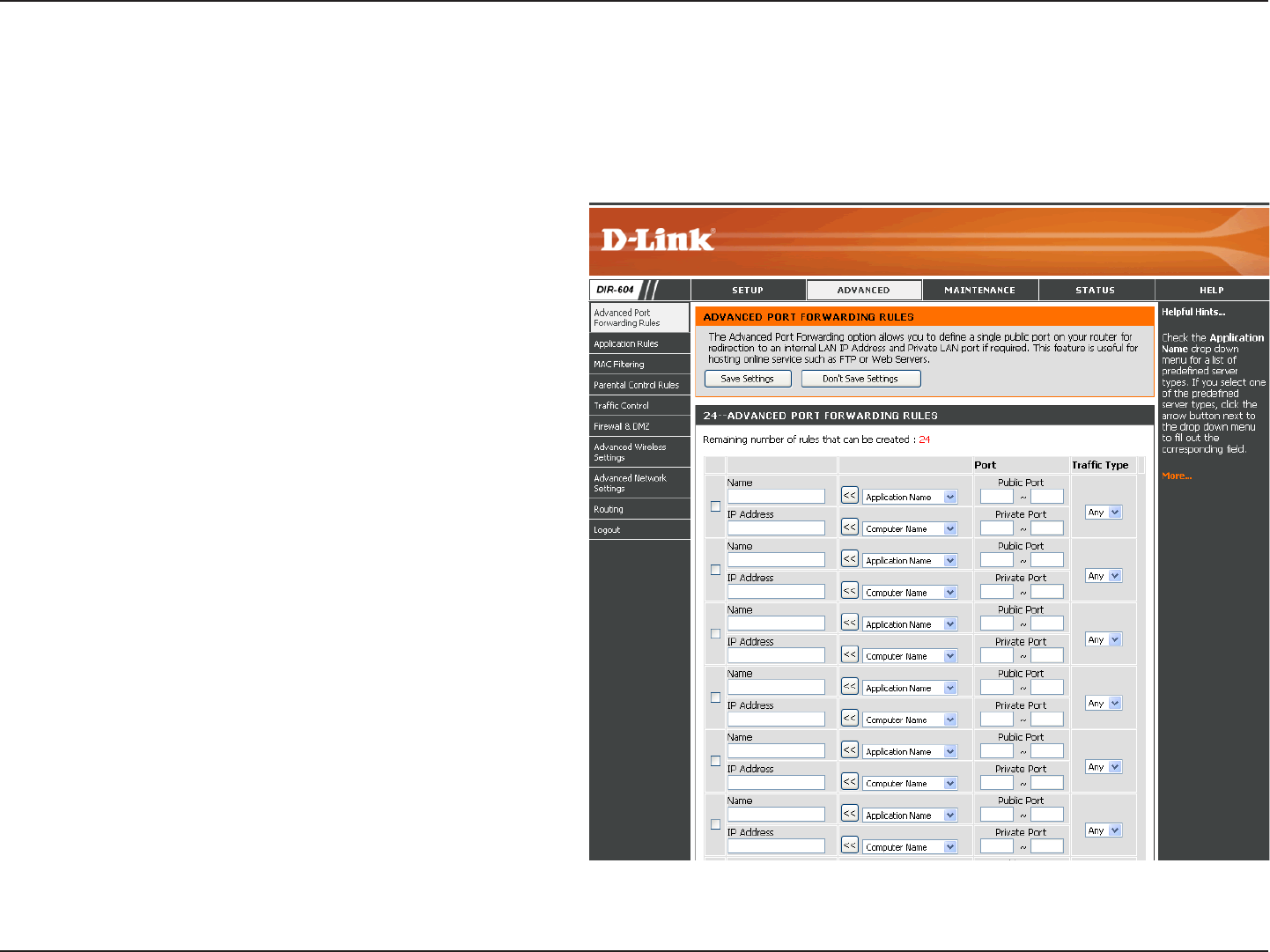
54D-Link DIR-604 User Manual
Section 3 - Configuration
Port Forwarding is a feature that allows you to open a single port or a range of ports and redirect the data received
through those ports to a single PC on your network. When you are nished on this page, go to the Schedule page
(Maintenance > Schedule) and create a schedule for when the port forwarding rule will be enabled.
Advanced Port Forwarding Rules
Enter a name for the rule or select an application
from the drop-down menu. Select an application
and click << to populate the elds.
Enter the IP address of the computer on your
local network that you want to allow the incoming
service to. If your computer is receiving an IP
address automatically from the Router (DHCP),
you computer will be listed in the “Computer
Name” drop-down menu. Select your computer
and click <<.
Enter the range of ports that you want to open
next to the Private Port and Public Port elds.
The private and public ports are usually the
same. The private ports are the ports being
used by the application on the computer within
your local network, and the public ports are the
ports seen from the Internet side.
Use the drop-down menu to select whether
TCP, UDP, or Any type of trafc is used for the
port forwarding rule.
Name:
IP Address:
Public Port/
Private Port:
Traffic Type:
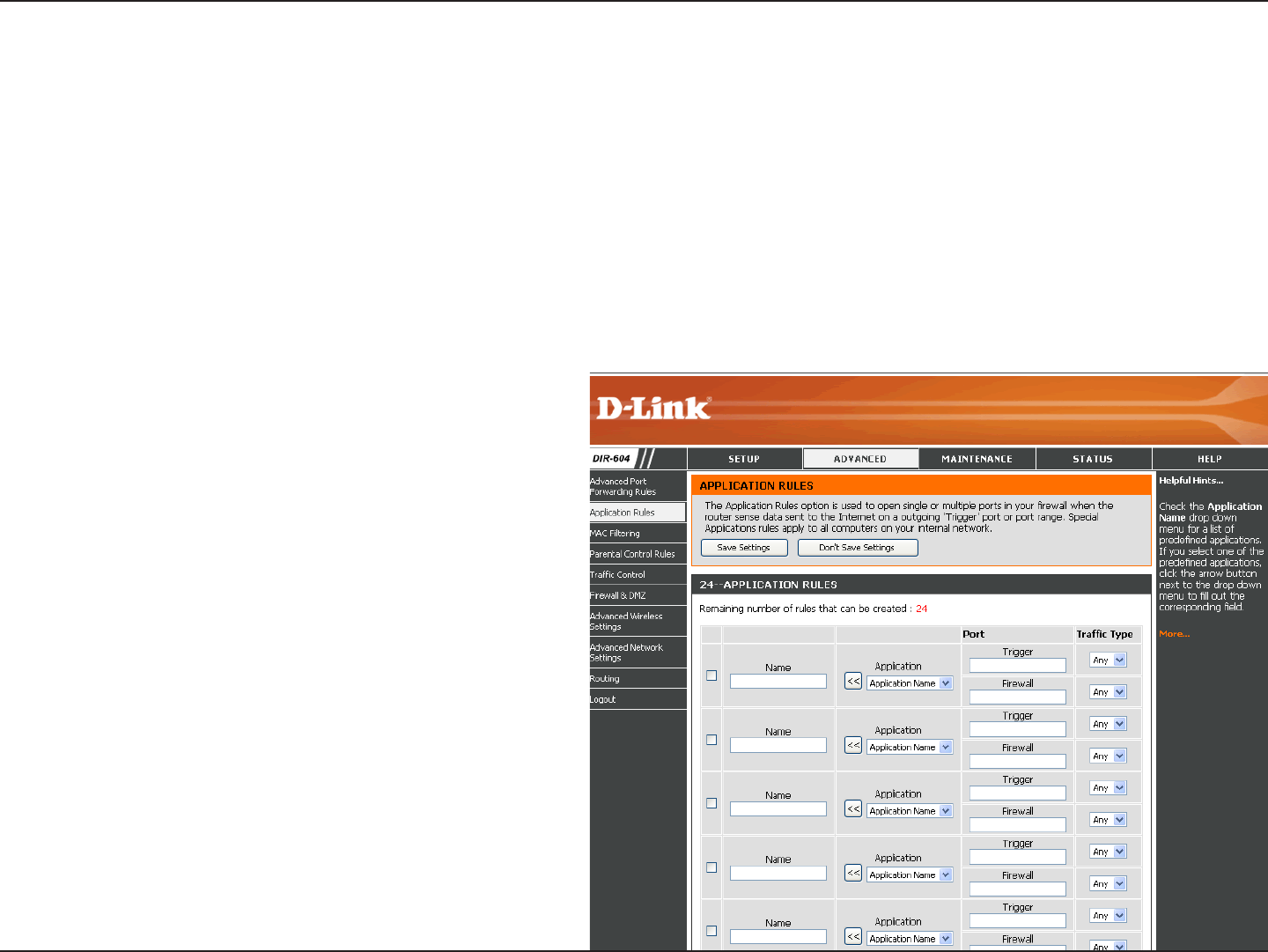
55D-Link DIR-604 User Manual
Section 3 - Configuration
Enter a name for the rule. You may select a
pre-dened application from the drop-down
menu and click <<.
This is the port used to trigger the application. It
can be either a single port or a range of ports.
Select the protocol of the trigger port (TCP,
UDP, or Any).
This is the port number on the Internet side that
will be used to access the application. You may
dene a single port or a range of ports. You
can use a comma to add multiple ports or port
ranges.
Select the protocol of the rewall port (TCP,
UDP, or Any).
Name:
Trigger:
Traffic Type:
Firewall:
Traffic Type:
Application Rules
Some applications require multiple connections, such as Internet gaming, video conferencing, Internet telephony and
others. These applications have difculties working through NAT (Network Address Translation). Special Applications
makes some of these applications work with the DIR-604. If you need to run applications that require multiple connections,
specify the port normally associated with an application in the Trigger port eld, select the protocol type as TCP, UDP,
or Any, and then enter the rewall (public) ports associated with the trigger port to open them for inbound trafc.
The DIR-604 provides some predened applications in the table on the bottom of the Web page. Select the application
you want to use and enable it. When you are nished on this page, go to the Schedule page (Maintenance > Schedule)
and create a schedule for when the application rule will be enabled.
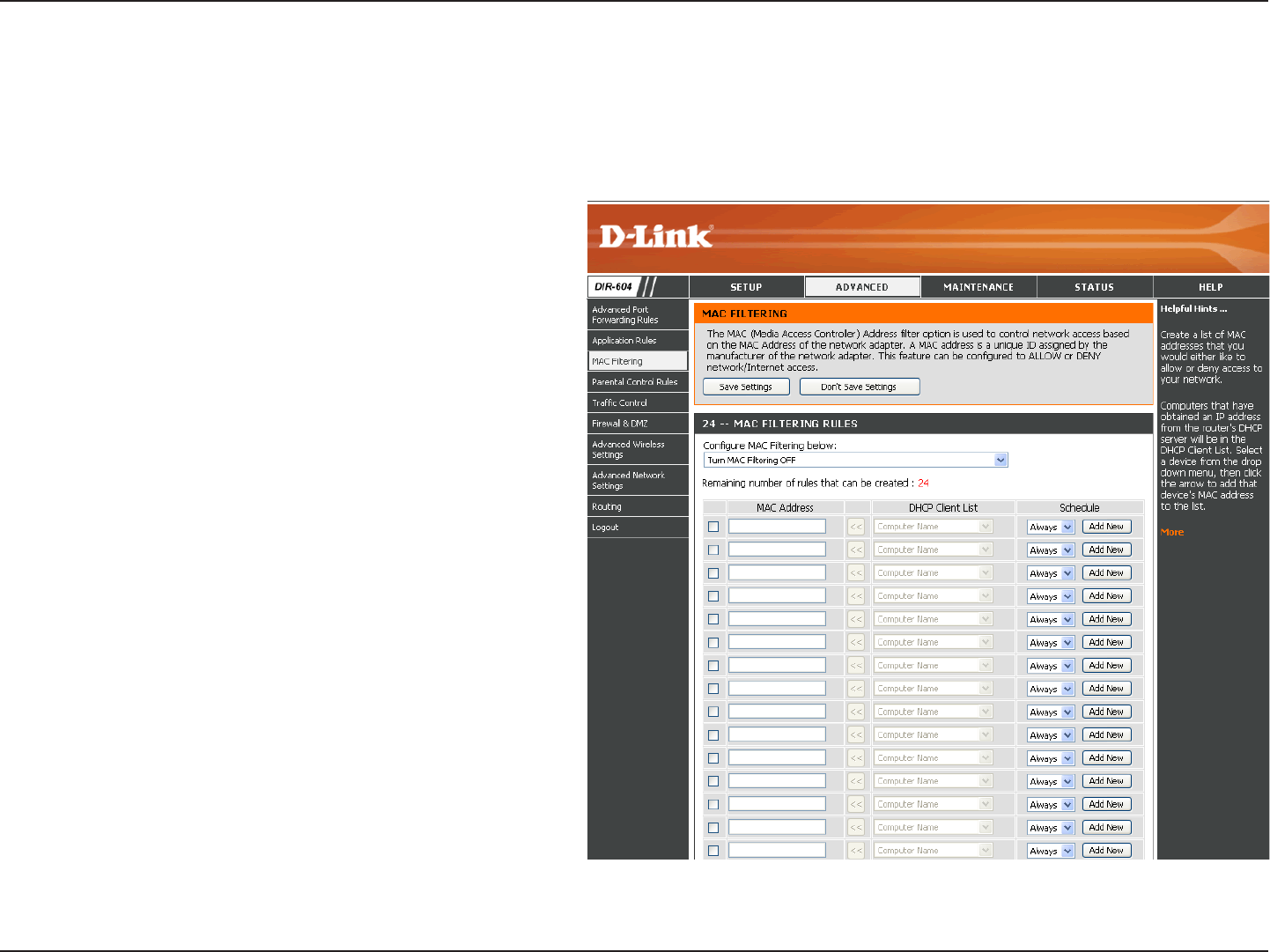
56D-Link DIR-604 User Manual
Section 3 - Configuration
MAC Filtering
Select Turn MAC Filtering Off, Turn MAC
Filtering ON and ALLOW computers listed to
access the network, or Turn MAC Filtering
ON and DENY computers listed to acces the
network from the drop-down menu.
Enter the MAC address you would like to lter.
To nd the MAC address on a computer, please
refer to the Networking Basics section in this
manual.
Select a DHCP client from the drop-down menu
and click << to copy the MAC Address from the
DHCP client.
Select a schedule for when the Network Filter
will be enabled. The user can click the Add New
button to bring up the Schedule page. This is
used to congure a new schedule.
Configure
MAC
Filtering:
MAC Address:
DHCP Client
List:
Schedule:
Use MAC (Media Access Control) Filters to allow or deny LAN (Local Area Network) computers by their MAC addresses
from accessing the network. You can either manually add a MAC address or select the MAC address from the list of
clients that are currently connected to the Router.
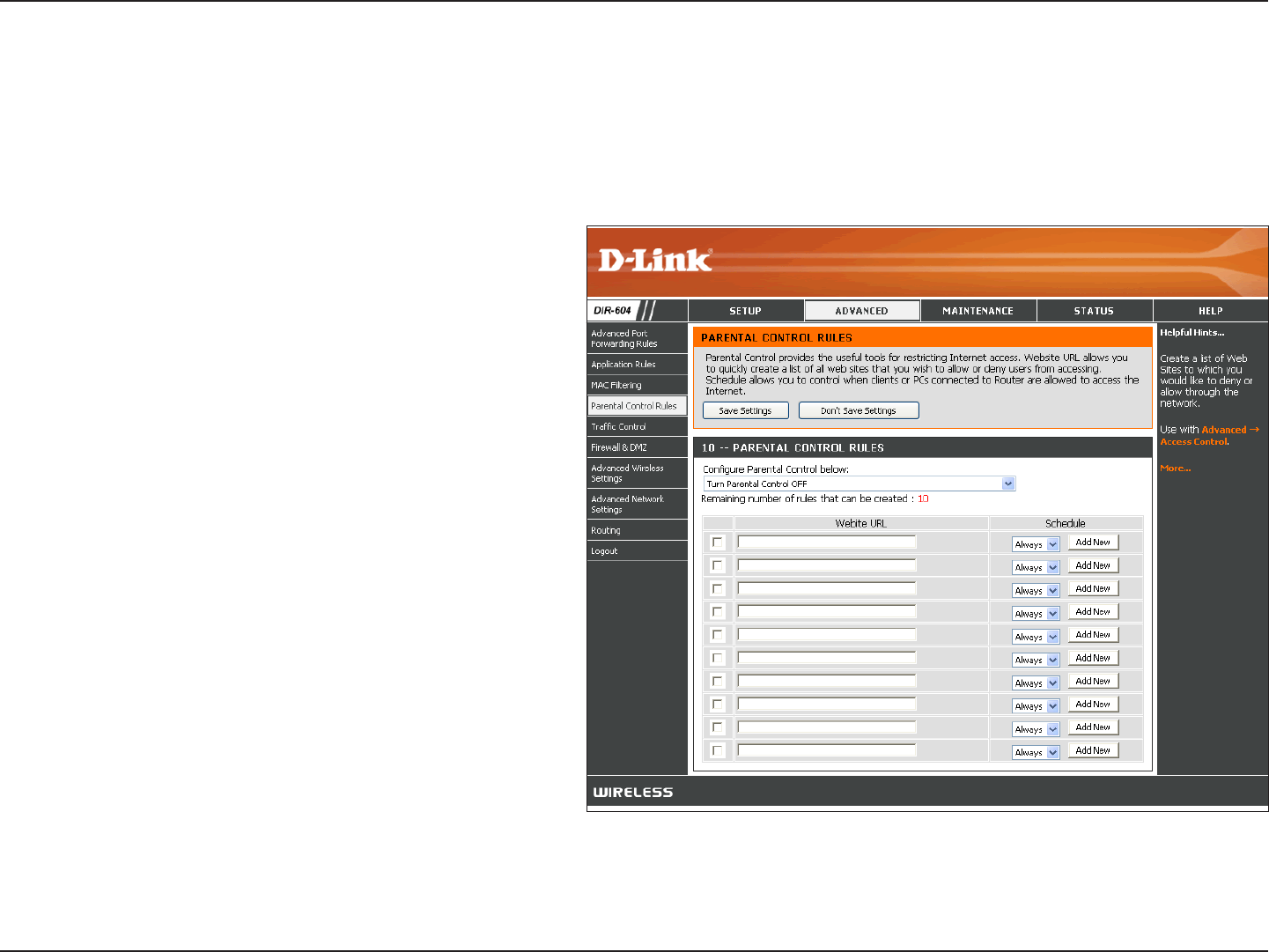
57D-Link DIR-604 User Manual
Section 3 - Configuration
Select Turn Parental Control OFF, Turn
Parental Control ON and Deny computers
access to only these sites, or Turn Parental
Control ON and Allow computers access to
only these sites.
Enter the URLs that you want to allow or deny.
Use the drop-down menu to select the schedule
for the network lter rule. Click the Add New
button to bring up the Schedule page. This is
used to congure a new schedule.
Configure
Parental
Control Below:
Website URL:
Schedule:
Parental Control Rules
Parental Control Rules are used to allow you to set up a list of allowed Websites that can be used by multiple users
through the network. To use this feature, select to allow or deny computer access to the specied sites, enter the
domain or Website, and then click Add New and congure a schedule on the Schedule page. Finally, tick the desired
corresponding parental control rule check box and then click Save Settings.
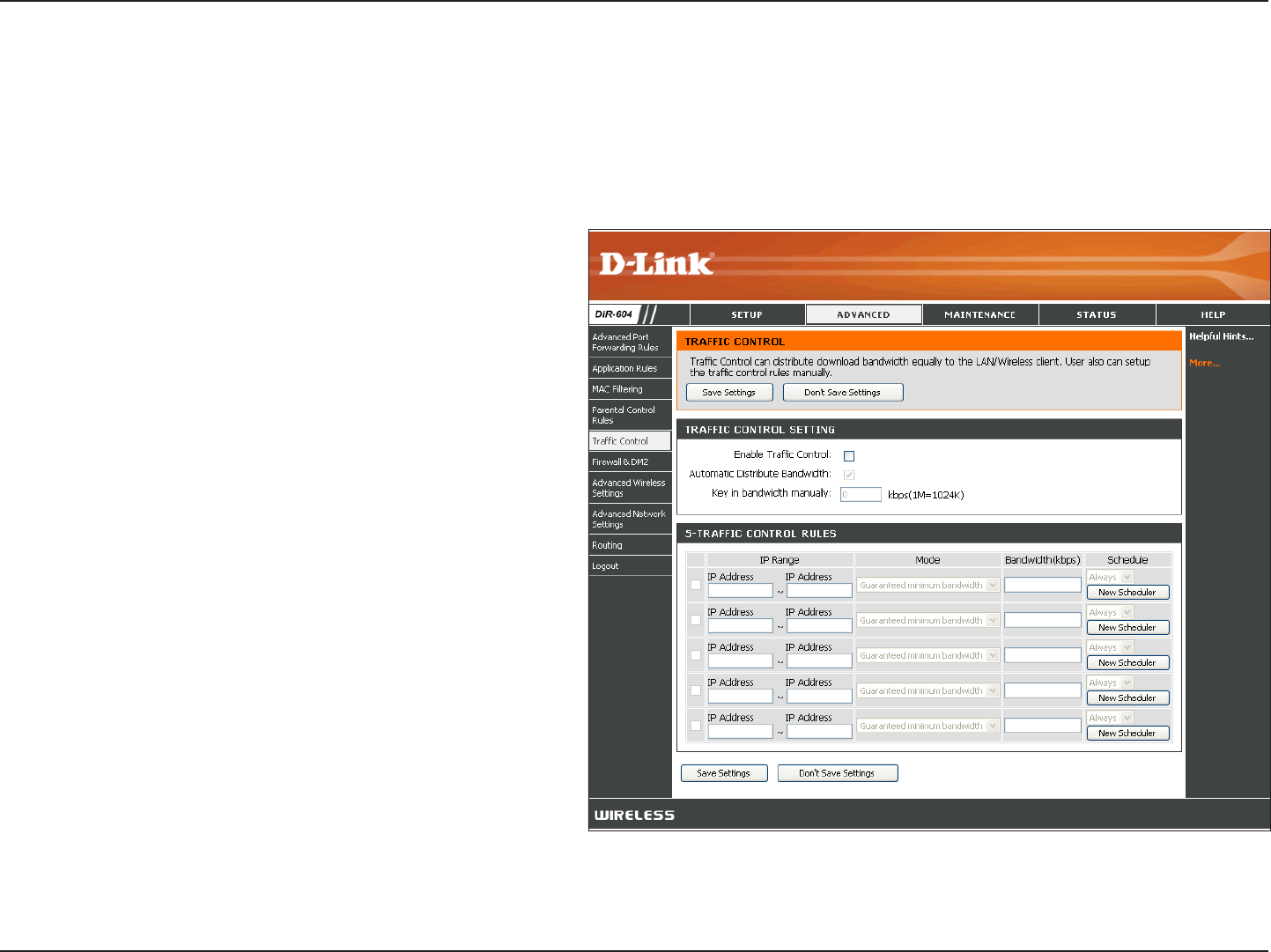
58D-Link DIR-604 User Manual
Section 3 - Configuration
Tick the Enable Trafc Control check box to
enable the trafc control feature.
Tick the Automatic Distribute Bandwidth check
box to automatically equally share bandwith
among LAN and wireless clients.
Enter the desired bandwith in kbps.
Manually congure beginning and ending IP
address ranges for trafc control rules. To
activate, tick the corresponding check box for
each desired trafc control rule.
Select Guaranteed minimum bandwidth or
Restricted maximum bandwidth.
Enter the bandwith for the specic trafc control
rule.
Use the drop-down menu to select the schedule
for the traffic control rule. Click the New
Scheduler button to bring up the Schedule
page. This is used to congure a new schedule.
Enable Traffic
Control:
Automatic
Distribute
Bandwidth:
Key in
bandwidth
manually:
IP Range:
Mode:
Bandwidth
(kbps):
Schedule:
Traffic Control
Trafc Control is used to equally distribute download bandwidth to LAN/wireless clients. This can be done automatically
or manually. To use this feature, enable trafc control and then choose to automatically or manually distribute bandwith.
Next, click New Scheduler and congure a schedule on the Schedule page. Finally, if you have chosen the manual
option, tick the desired corresponding trafc control rule check box and then click Save Settings.
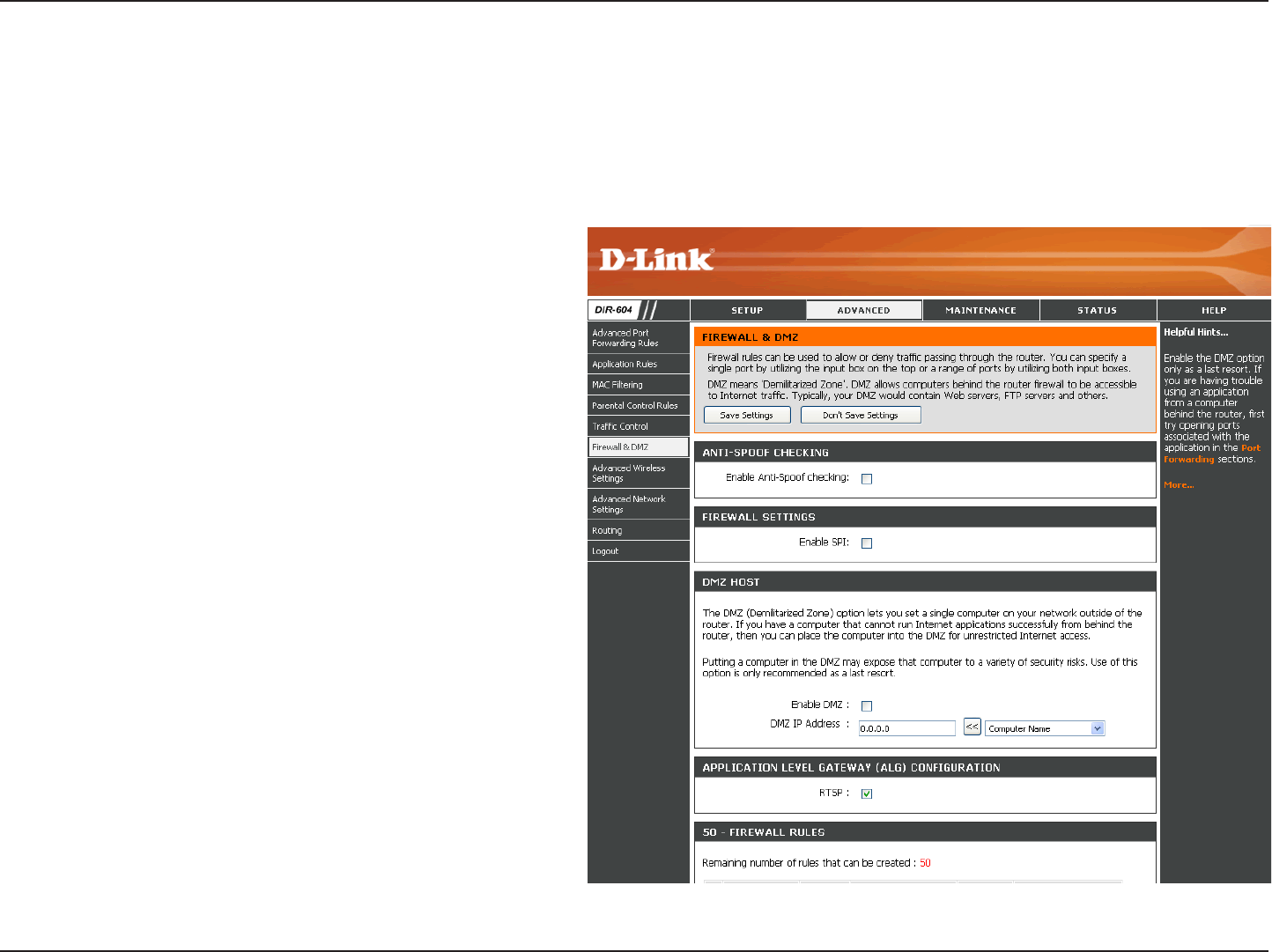
59D-Link DIR-604 User Manual
Section 3 - Configuration
Tick to enable the Router’s built-in anti-spoong
feature.
SPI (Stateful Packet Inspection, also known as
dynamic packet ltering) helps to prevent cyber
attacks by tracking more state per session. It
validates that the trafc passing through the
session conforms to the protocol.
Tick this check box to enable DMZ.
Specify the IP address of the computer on the
LAN that you want to have unrestricted Internet
communication in this eld. Use the drop-down
menu to specify a host that currently has a
DHCP lease from the DIR-604. If this computer
has obtained its IP address automatically using
DHCP, be sure to make a static reservation on
the LAN Setup page (Setup > LAN Setup) in
the DHCP Reservation section so that the IP
address of the DMZ machine does not change.
Tick to enable application level gateway (ALG)
conguration of RTSP.
Use this section to create rules that deny or
allow trafc from passing through the device.
See the following page for information on how to create rewall rules.
Enable
Anti-Spoof
checking:
Enable SPI:
Enable DMZ:
DMZ
IP Address:
RSTP:
Firewall Rules:
Firewall & DMZ
A rewall protects your network from the outside world. The D-Link DIR-604 offers a rewall type functionality. The SPI
feature helps prevent cyber attacks. Sometimes you may want a computer exposed to the outside world for certain
types of applications. If you choose to expose a computer, you can enable DMZ (DMZ is short for Demilitarized Zone).
This option will completely expose the chosen computer to the outside world.
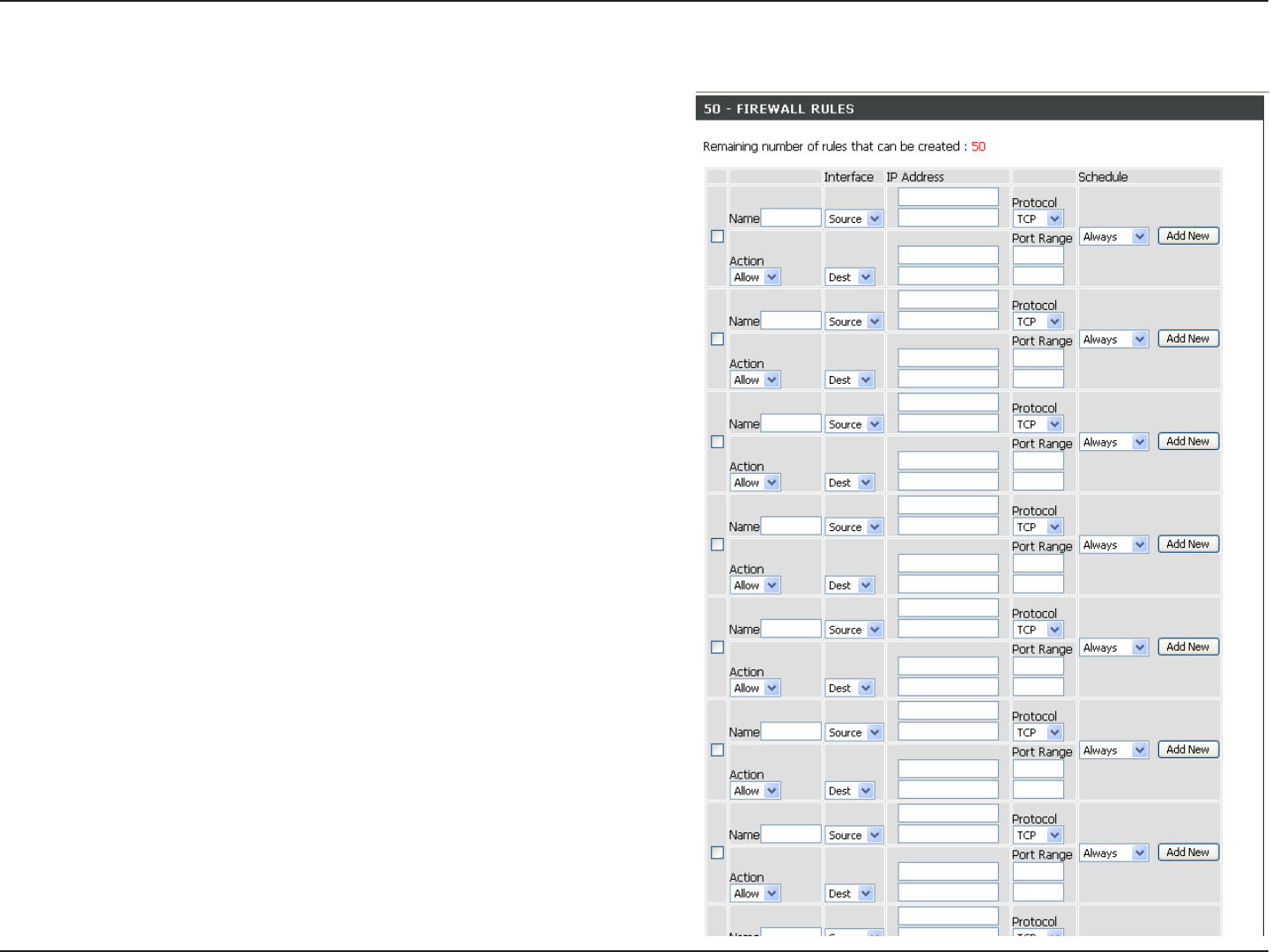
60D-Link DIR-604 User Manual
Section 3 - Configuration
Firewall Rules
Enter a name for the rewall rule.
Use the drop-down menu to specify if the Router should
Allow or Deny trafc matching the rewall rule.
Use the drop-down menus to select the Source and Dest
(ination) interfaces for the rewall rule. You also may opt
to choose either LAN or WAN for each pair of interfaces.
Use these elds next to each Interface drop-down menu to
specify the IP address ranges for the Source/Destination
interfaces.
The rst host in the IP address range should be entered
in the top eld and the last host in the IP address range
should be entered in the eld beneath for both the Source/
Destination interfaces.
Use the drop-down menu to select the protocol that will be
used for the rewall rule (TCP, UDP, ICMP, or All).
Enter the range of ports that the rewall rule will apply to.
The rst port in the port range should be entered in the top
eld and the last host in the port range should be entered
in the eld beneath.
Use the drop-down menu to select the schedule for the
rewall rule. Click the Add New button to bring up the
Schedule page to congure the new schedule.
Name:
Action:
Interface:
IP Address:
Protocol:
Port Range:
Schedule:
To create a rewall rule, congure the parameters
described below:
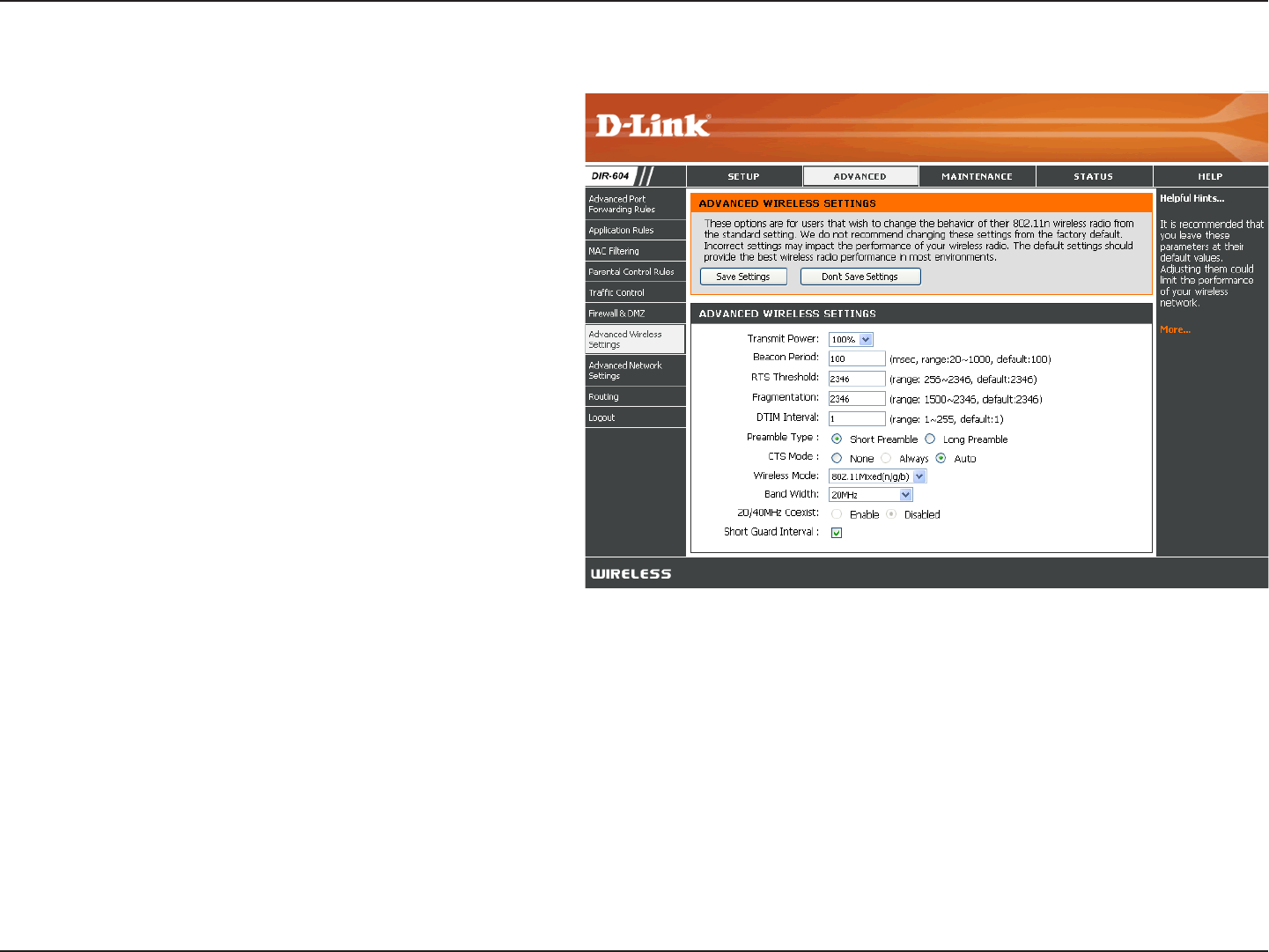
61D-Link DIR-604 User Manual
Section 3 - Configuration
Set the transmit power of the antennas.
Beacons are packets sent by an Access Point to
synchronize a wireless network. Specify a value.
100 is the default setting and is recommended.
This value should remain at its default setting of
2432. If inconsistent data ow is a problem, only
a minor modication should be made.
The fragmentation threshold, which is specied
in bytes, determines whether packets will be
fragmented. Packets exceeding the 2346 byte
setting will be fragmented before transmission.
2346 is the default setting.
(Delivery Trafc Indication Message) 1 is the
default setting. A DTIM is a countdown informing
clients of the next window for listening to
broadcast and multicast messages.
Select Short or Long Preamble. The preamble denes the length of the CRC block (Cyclic Redundancy Check is a common
technique for detecting data transmission errors) for communication between the wireless router and the roaming wireless
network adapters. Note: High network trafc areas should use the Short Preamble type.
Select None to disable this feature. Select Always to force the Router to require each wireless device on the network to
perform an RTS/CTS handshake before they are allowed to transmit data. Select Auto to allow the Router to decide when
RTS/CTS handshakes are necessary
Use the drop-down menu to select the wireless modes you want to enable on the Router. The available options are 802.11n
only, 802.11 Mixed (g/b), and 802.11 Mixed (n/g/b).
Use the drop-down menu to select 20MHz or 20/40MHz (Auto).
Transmit
Power:
Beacon
Period:
RTS
Threshold:
Fragmentation:
DTIM
Interval:
Preamble
Type:
CTS Mode:
Wireless
Mode:
Bandwidth:
Advanced Wireless Settings

62D-Link DIR-604 User Manual
Section 3 - Configuration
Click the Save Settings button when you have nished the advanced wireless conguration.
20/40Mhz
Coexist:
Short Guard
Interval:
Select to enable or disable 20MHz and 40MHz co-existing in the same wireless network. This is useful when 20MHz
and 40MHz devices exist in the same wireless coverage area. Enable this feature to properly allocate channels without
interference in such a scenario.
Tick this check box to reduce the guard interval time therefore increasing the data capacity. However, this is less reliable
and may create higher data loss.
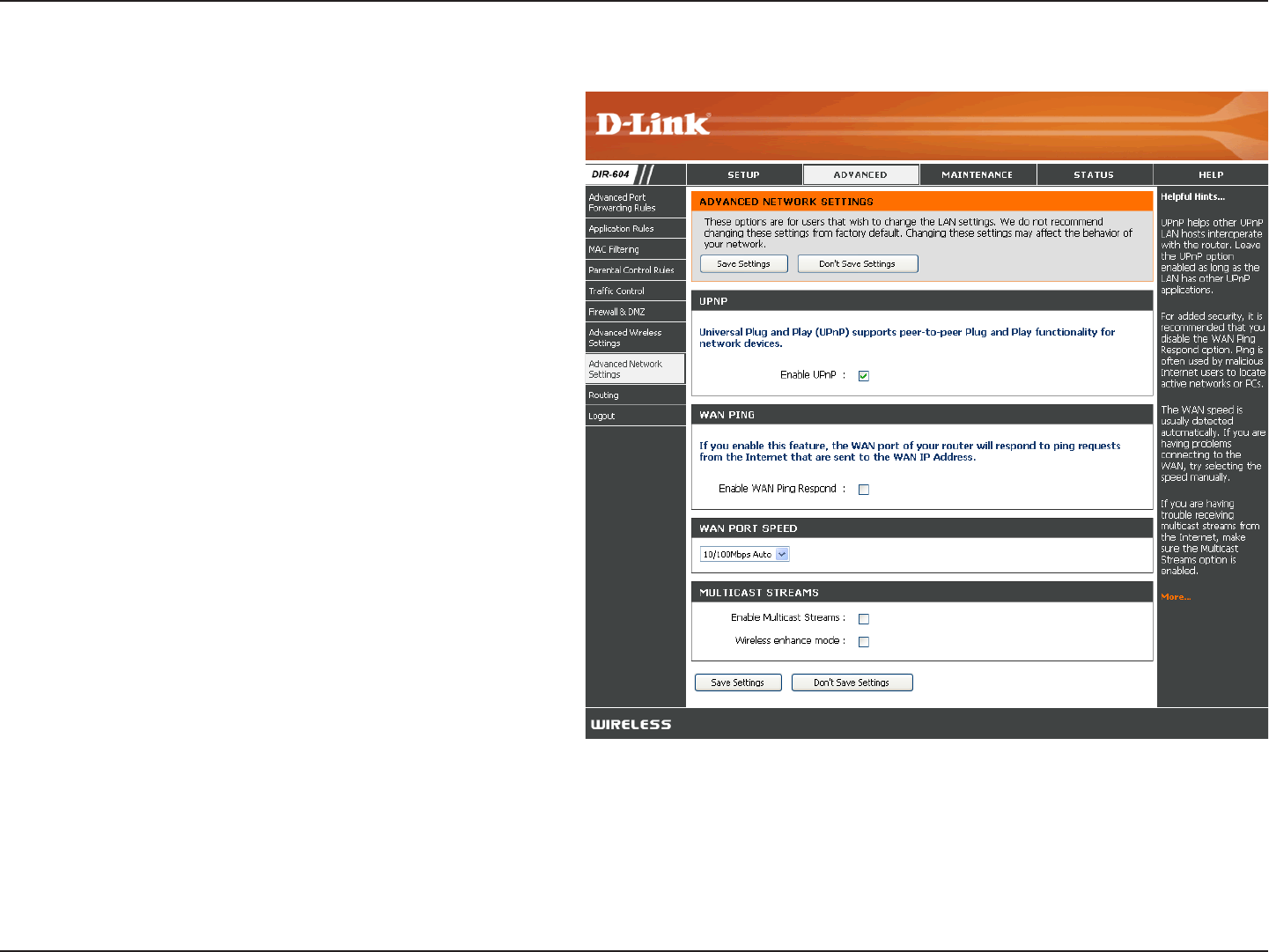
63D-Link DIR-604 User Manual
Section 3 - Configuration
To use the Universal Plug and Play (UPnP™)
feature, tick the Enable UPNP box. UPNP
provides compatibility with networking
equipment, software, and peripherals.
De-selecting this check box will not allow the
DIR-604 to respond to pings. Blocking the Ping
may provide some extra security from hackers.
Tick the check box to allow the Internet port
to be “pinged”.
You may set the port speed of the Internet
port to 10Mbps, 100Mbps, or 10/100Mbps
Auto. Some older cable or DSL modems may
require you to set the port speed to 10Mbps.
Tick the Enable Multicast Streams check
box to allow multicast trafc to pass through
the Router from the Internet.
Tick the Wireless Enhance Mode check box
to enable the Router to forward all multicast
streams from the Internet to the wireless
station using a unicast stream. This feature
helps improve the quality of multimedia
applications for wireless users.
Enable UPnP:
Enable WAN
Ping Respond:
WAN
Port Speed:
Enable
Multicast
Streams:
Wireless
Enhance
Mode:
Advanced Network Settings
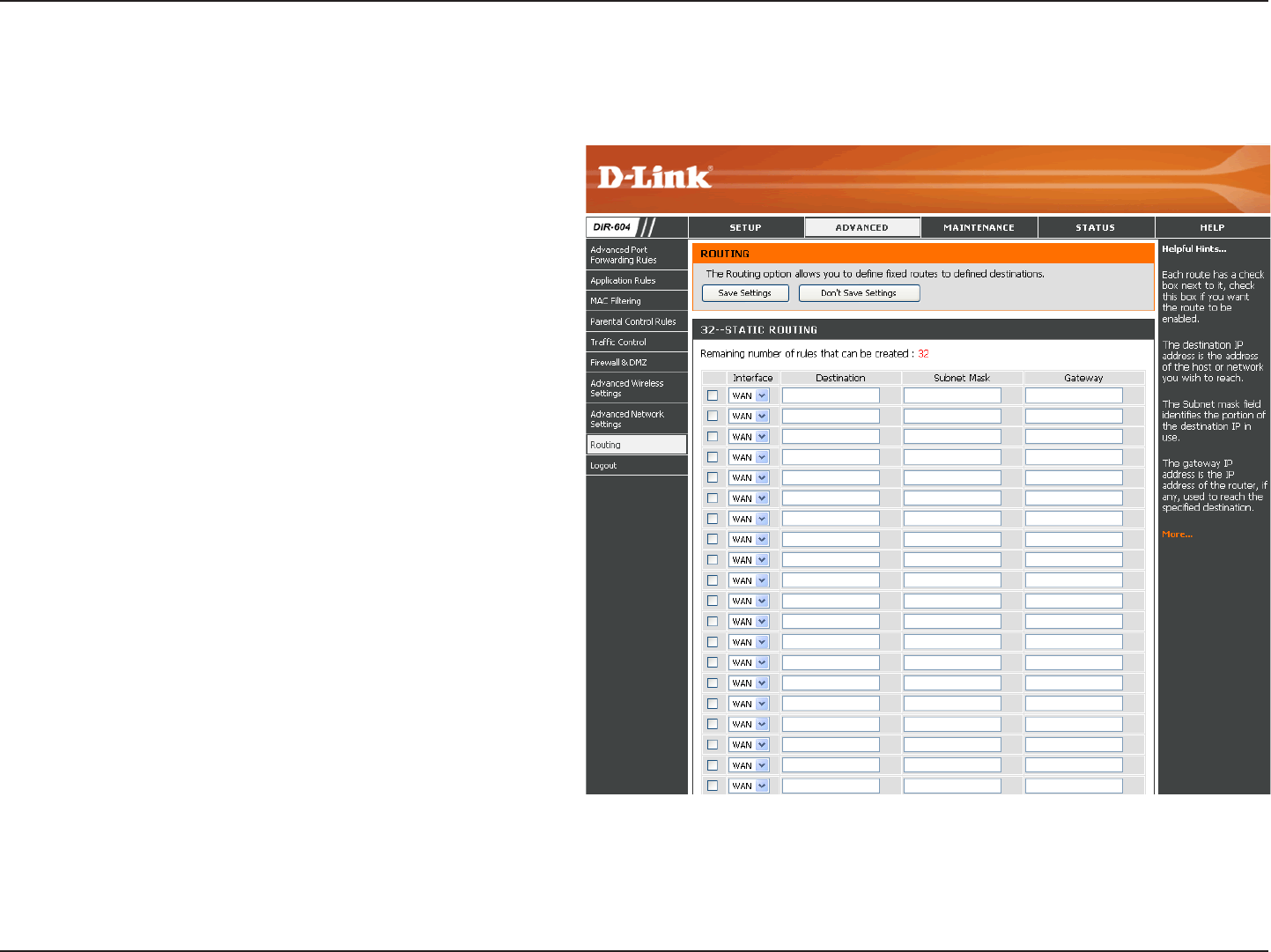
64D-Link DIR-604 User Manual
Section 3 - Configuration
Routing
UPnP
Internet Ping Block
Internet Port Speed
Multicast Streams
Select the interface which the IP packet must
use to transit out of the Router when this route
is used. Each route has a check box next to
it. Tick the check box of the route you wish to
enable.
Enter the IP address of the host or network
you wish to access.
This eld identies the portion of the destination
IP address in use.
The gateway is the IP address of the router, if
any, used to reach the specied destination.
Interface:
Destination:
Subnet Mask:
Gateway:
The routing feature allows users to dene xed routes to dened destinations.

65D-Link DIR-604 User Manual
Section 3 - Configuration
Change Password
Remote Management
Enter the login name. The default is admin.
Enter a new password for the Administrator
Login Name. The administrator can make
changes to the settings.
Retype the new password for the Administrator
Login Name.
Tick this check box to enable graphical
authentication. The device supports this function
to prevent phishing.
Remote management allows the DIR-604 to be
congured from the Internet by a Web browser.
A username and password is still required to
access the Web Management interface. In
general, only a member of your network can
browse the built-in Web pages to perform
Administrator tasks. This feature enables you to perform Administrator tasks from the remote (Internet) host.
Enter the IP address of the computer on the Internet that you want to have access to the Router. If left blank, any computer
on the Internet can access the Router.
The port number used to access the DIR-604. Example: http://x.x.x.x:8080 whereas x.x.x.x is the Internet IP address of the
DIR-604 and 8080 is the port used for the Web Management interface.
Login Name:
Password:
Confirm
Password:
Enable
Graphical
Authentication:
Enable
Remote
Management:
IP Allowed to
Access:
Port:
Administrator Settings
This page will allow you to change the Administrator and User passwords. You can also enable Remote Management.
There are two accounts that can access the management interface through the Web browser. The accounts are admin
and user. Admin has read/write access while user has read-only access. User can only view the settings but cannot
make any changes. Only the admin account has the ability to change both admin and user account passwords.
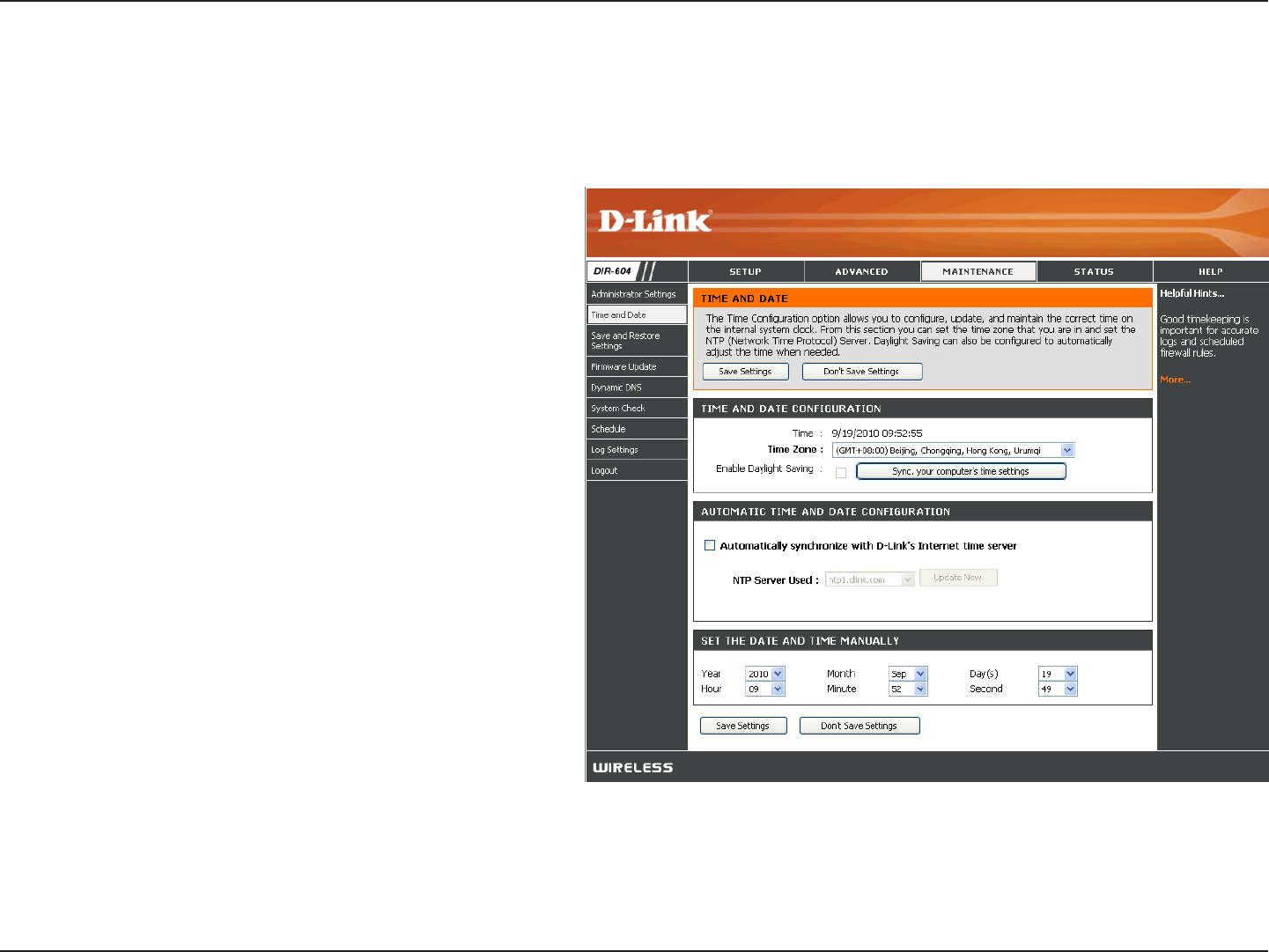
66D-Link DIR-604 User Manual
Section 3 - Configuration
Time and Date
Select the Time Zone from the drop-down menu.
Tick the check box to enable Daylight Saving
Time.
Click this button to set the device’s time the
same to local PC.
Check the box to enable the device to
automatically synchronize with a D-Link NTP
Server. NTP stands for Network Time Protocol.
NTP synchronizes computer clock times in a
network of computers. This will only connect
to a server on the Internet, not a local server.
Select one of the D-Link NTP Servers from
the drop-down menu. The DIR-604 will then
synchronize its clock to be the same time as
the D-Link Internet
time server. Click the Update Now button to
synchronize with the D-Link Internet time server
immediatley.
To manually input the time, use the drop-down
menus to enter the values in these elds for the
Year, Month, Day, Hour, Minute, and Second.
Time Zone:
Enable
Daylight
Saving:
Sync your
computer’s time
settings:
Automatically
synchronize
with D-Link’s
Internet time
server:
NTP
Server Used:
Set the Time
and Date
Manually:
The Time and Date Conguration option allows you to congure, update, and maintain the correct time on the internal
system clock. From this section you can set the time zone that you are in and set the Time Server. Daylight Saving
can also be congured to automatically adjust the time when needed.
Click the Save Settings button to save any changes made.

67D-Link DIR-604 User Manual
Section 3 - Configuration
Use this option to save the current router
conguration settings to a le on the hard disk
of the computer you are using. First, click the
Save button. You will then see a le dialog,
where you can select a location and le name
for the settings.
Use this option to load previously saved
router configuration settings. First, use the
Browse control to nd a previously save le of
conguration settings. Then, click the Upload
Settings button to transfer those settings to
the Router.
Click the Restore Device button to restore
all conguration settings back to the settings
that were in effect at the time the Router was
shipped from the factory. Any settings that have
not been saved will be lost, including any rules
that you have created. If you want to save the
current router conguration settings, use the
Save button above.
Click the Clear button to restore the device back
to the English interface version and remove
other languages installed for the system web
pages.
Save Settings
to Local Hard
Drive:
Load Settings
from Local
Hard Drive:
Restore to
Factory
Default
Settings:
Clear
Language
Pack:
Save and Restore Settings

68D-Link DIR-604 User Manual
Section 3 - Configuration
Displays the current rmware version.
Displays the current rmware date.
Click the Check Now button, or the “Click here
to check for an upgrade on our support site.”
hyperlink at the top of the page, to see what the
latest rmware for the Router is.
After you have downloaded the new rmware,
click the Browse control to locate the rmware
update on your hard drive. Click Upload to
complete the rmware upgrade.
This function allows the user to transfer the
language of the GUI from English to their own
language by upgrading the language pack.
Click the Browse control to locate the desired
language pack on your hard drive. Click Upload
to complete the language pack upgrade.
Current
Firmware
Version:
Current
Firmware
Date:
Check Online
Now for Latest
Firmware
Version:
Firmware
Upgrade:
Language
Pack
Upgrade:
Firmware Update
You can upgrade the rmware of the Router here. Please check the D-Link support site for rmware updates at http://
support.dlink.com or simply click the Check Now button located in the Firmware Information section. You can download
rmware upgrades to your hard drive from the D-Link support site. Make sure the rmware you want to use is on the
local hard drive of the computer. Click on Browse to locate the rmware le to be used for the update.
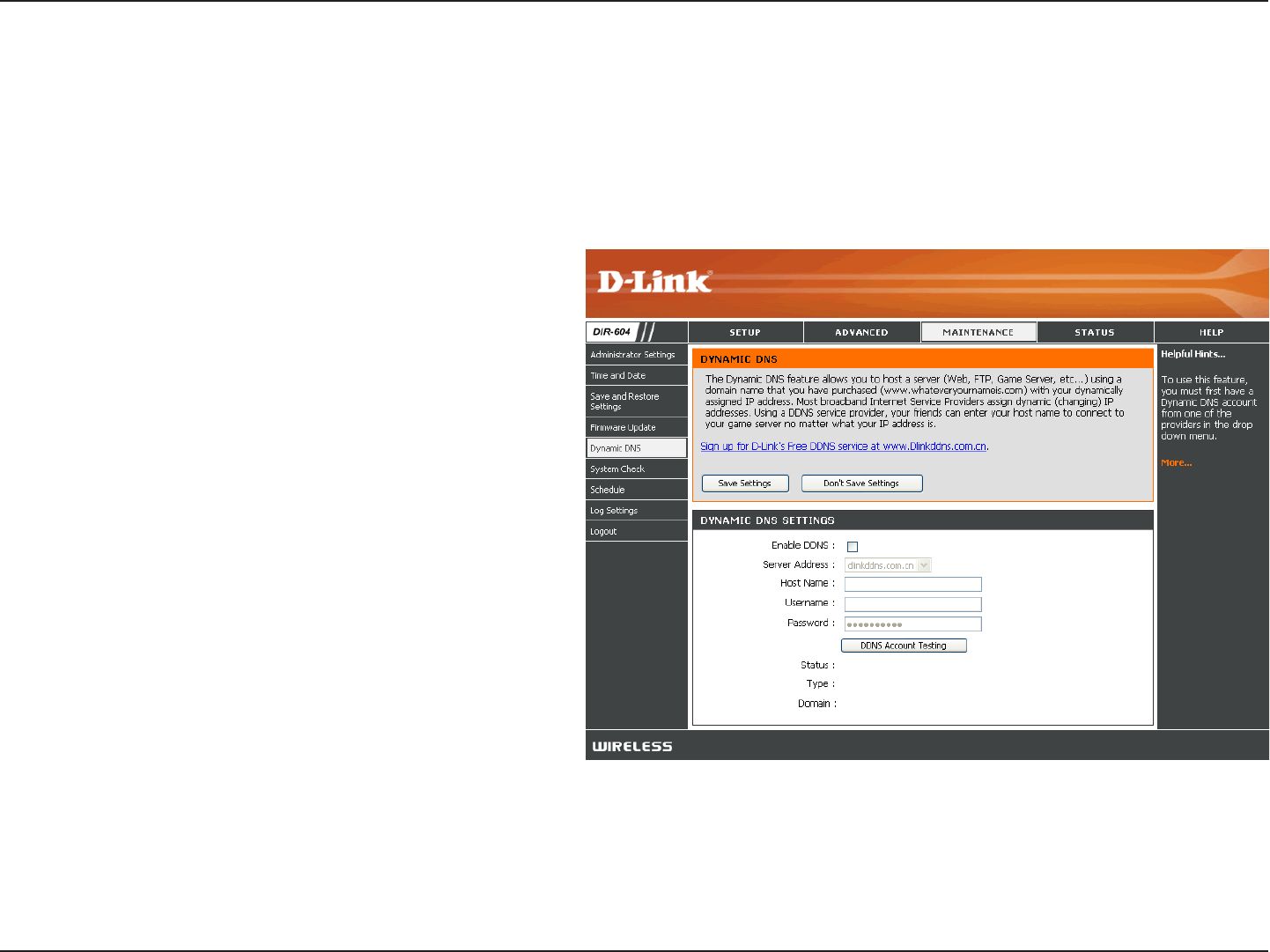
69D-Link DIR-604 User Manual
Section 3 - Configuration
Dynamic Domain Name System is a method of
keeping a domain name linked to a changing
IP Address. Check the box to enable DDNS.
Choose your DDNS provider from the drop-
down menu.
Enter the Host Name that you registered with
your DDNS service provider.
Enter the User Name for your DDNS account.
Enter the Password for your DDNS account.
This is to test if the DDNS account is valid for
use.
Enable DDNS:
Server Address:
Host Name:
Username:
Password:
DDNS Account
Testing:
Dynamic DNS
The DDNS feature allows you to host a server (Web, FTP, Game Server, etc…) using a domain name that you have
purchased (www.whateveryournameis.com) with your dynamically assigned IP address. Most broadband Internet
Service Providers assign dynamic (changing) IP addresses. Using a DDNS service provider, your friends can enter in
your domain name to connect to your server no matter what your IP address is.
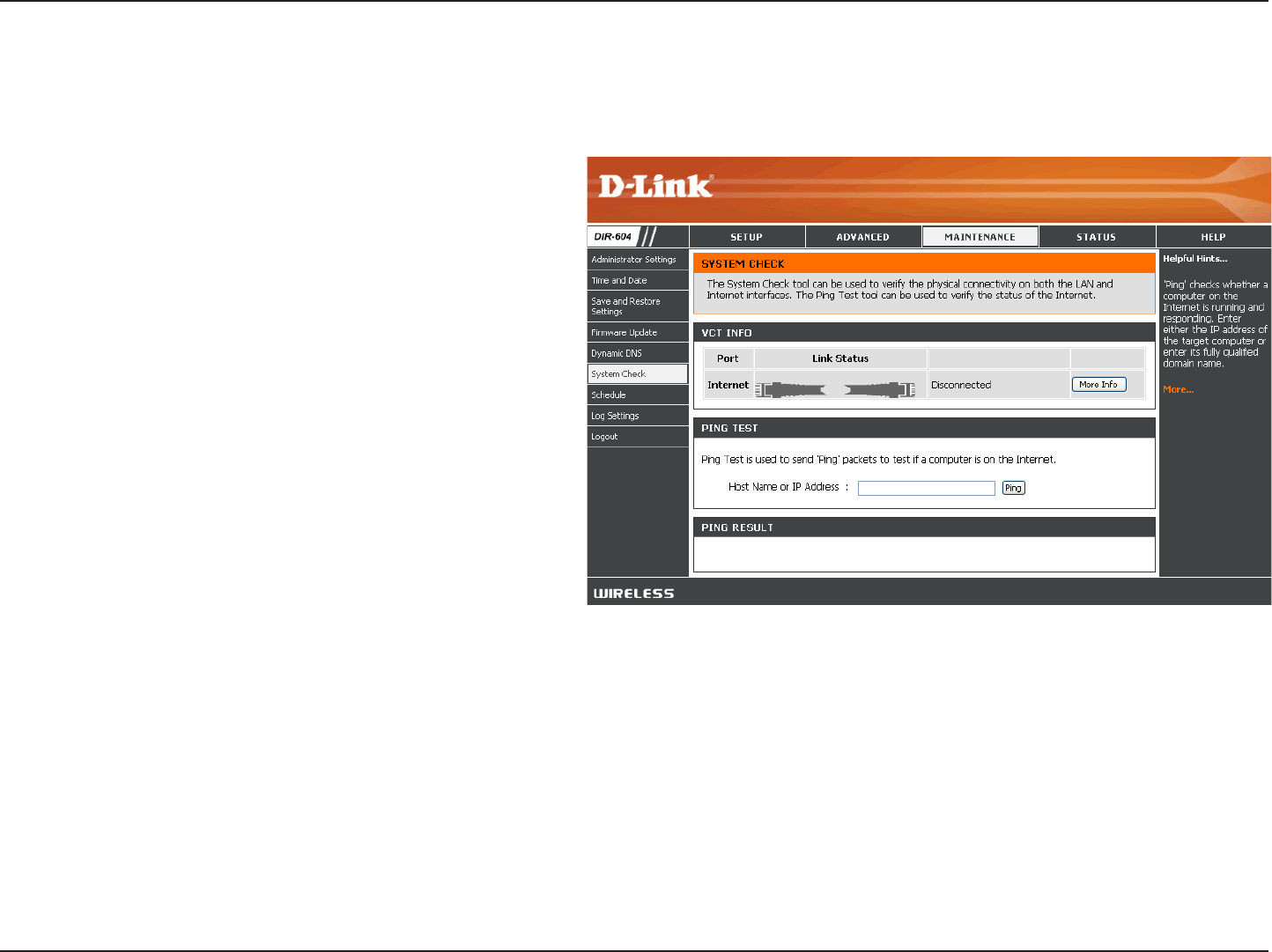
70D-Link DIR-604 User Manual
Section 3 - Configuration
The Ping Test is used to send Ping packets
to test if a computer is on the Internet. Enter
the IP Address that you wish to Ping, and
click Ping.
The results of your ping attempts will be
displayed here.
Ping Test:
Ping Result:
The System Check feature allows you to verify the physical connectivity on both the LAN and Internet interface.
System Check
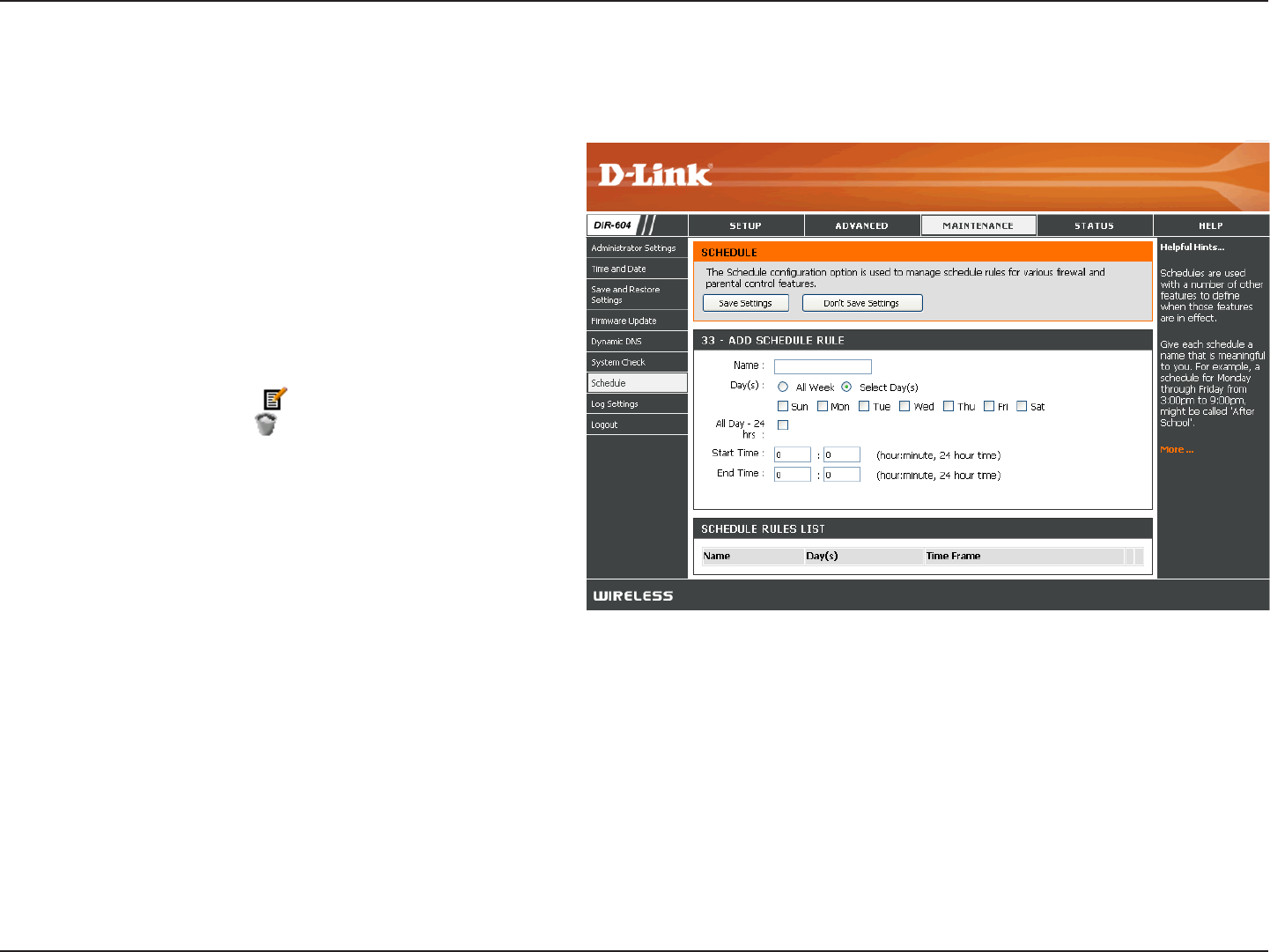
71D-Link DIR-604 User Manual
Section 3 - Configuration
Enter a name for your new schedule.
Select a day, a range of days, or All Week to
include every day.
Check All Day - 24 hrs or use the Start Time
and End Time elds to specify the start and
end time for your schedule.
The list of schedules will be listed here. Click
the Edit icon to make changes or click the
Delete icon to remove the schedule.
Name:
Day(s):
Time:
Schedule Rules
List:
Schedule
The Schedule page allows you to manage schedule rules for various rewall and parental control features.
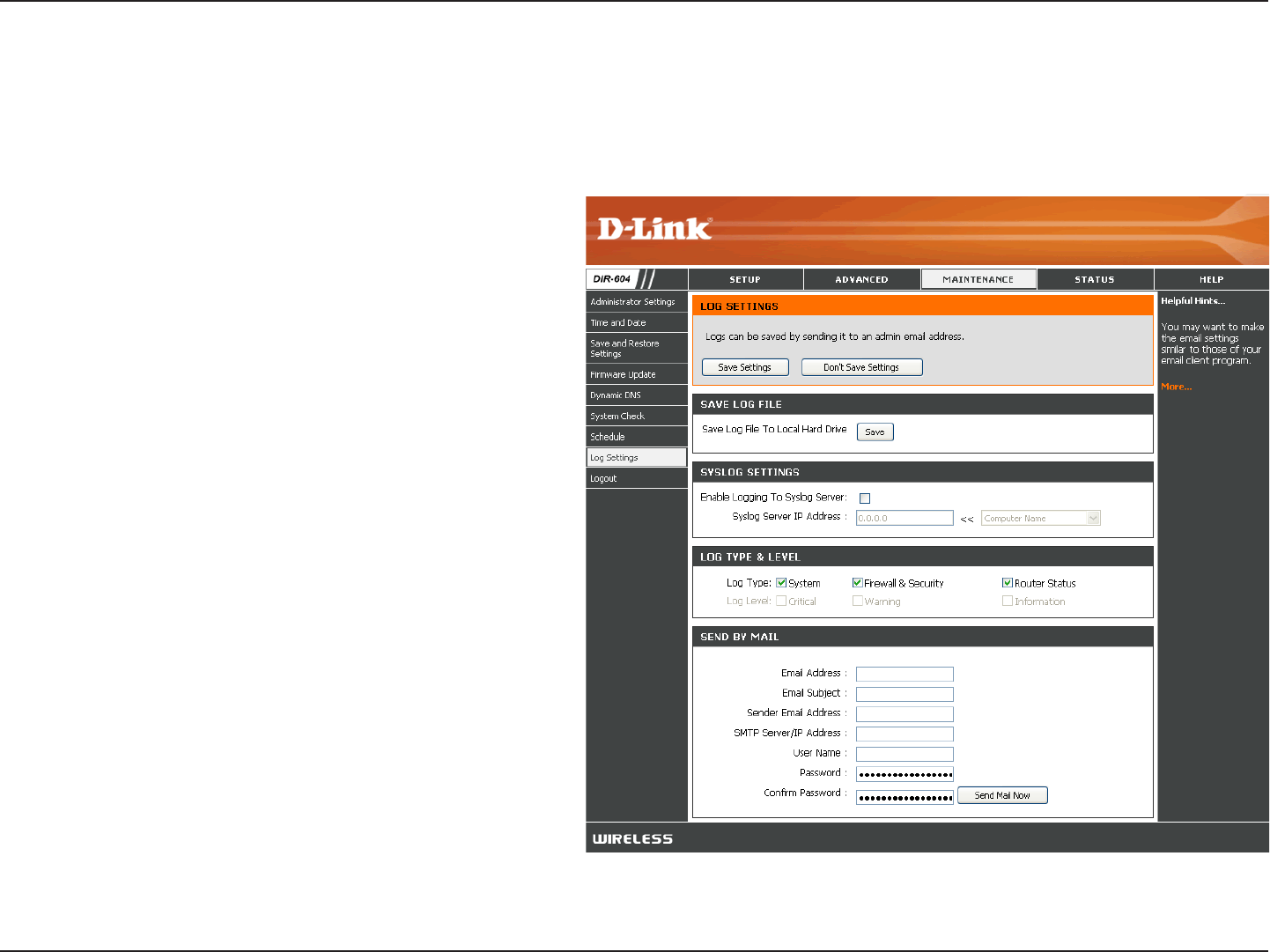
72D-Link DIR-604 User Manual
Section 3 - Configuration
Log Settings
The Router keeps a running log of events and activities occurring on the device. You can dene what types of events
you want to view and the level of the events to view. The Router also has external Syslog Server support, so you can
send the log les to a computer on your network that is running a Syslog utility.
Click the Save button to save the log le to
your local hard drive.
Tick this check box to send the Router logs to
a SysLog Server.
The address of the SysLog server that will be
used to send the logs. You may also select
your computer from the drop-down menu (only
if receiving an IP address from the Router via
DHCP).
Tick the desired type(s) of logs that should be
displayed: System, Firewall & Security, and
Router Status.
Tick the desired level(s) of importance:
Critical, Warning, and Information.
Enter the e-mail address where you want the
email sent.
Enter a subject description for your e-mail.
This e-mail address will appear as the sender
when you receive a log file or firmware
upgrade notication via e-mail.
Save Log File
to Local Hard
Drive:
Enable
Logging to
Syslog Server:
Syslog Server
IP Address:
Log Type:
Log Level:
Email Address:
Email Subject:
Sender Email
Address:

73D-Link DIR-604 User Manual
Section 3 - Configuration
Click the Save Settings button when you have nished the log settings conguration.
SMTP Server/
IP Address:
User Name:
Password:
Confirm
Password:
Enter the SMTP server address for sending e-mail. If your SMTP server requires authentication, select this option.
Enter your account user name for sending e-mail.
Enter the password associated with the account.
Re-type the password associated with the account and click the Send Mail Now button.

74D-Link DIR-604 User Manual
Section 3 - Configuration
This page displays the current information for the DIR-604. It will display the LAN, Internet (WAN), and Wireless
information, in addition to the rmware version and date the rmware was last updated.
If your Internet connection is set up for a Dynamic IP
address then a DHCP Release button and a DHCP
Renew button will be displayed. Use DHCP Release
to disconnect from your ISP and use DHCP Renew
to connect to your ISP.
If your Internet connection is set up for PPPoE, PPTP,
or L2TP, a Connect button and a Disconnect button
will be displayed. Use Disconnect to drop the Internet
connection and use Connect to establish the Internet
connection.
See the following for more information.
Device Information
LAN:
Internet:
Wireless
802.11n:
Displays the MAC address and the private
(local) IP settings for the Router.
Displays the MAC address and the public IP
settings for the Router.
Displays the wireless mode, MAC address and
your wireless settings such as SSID, Channel,
and Encryption status.
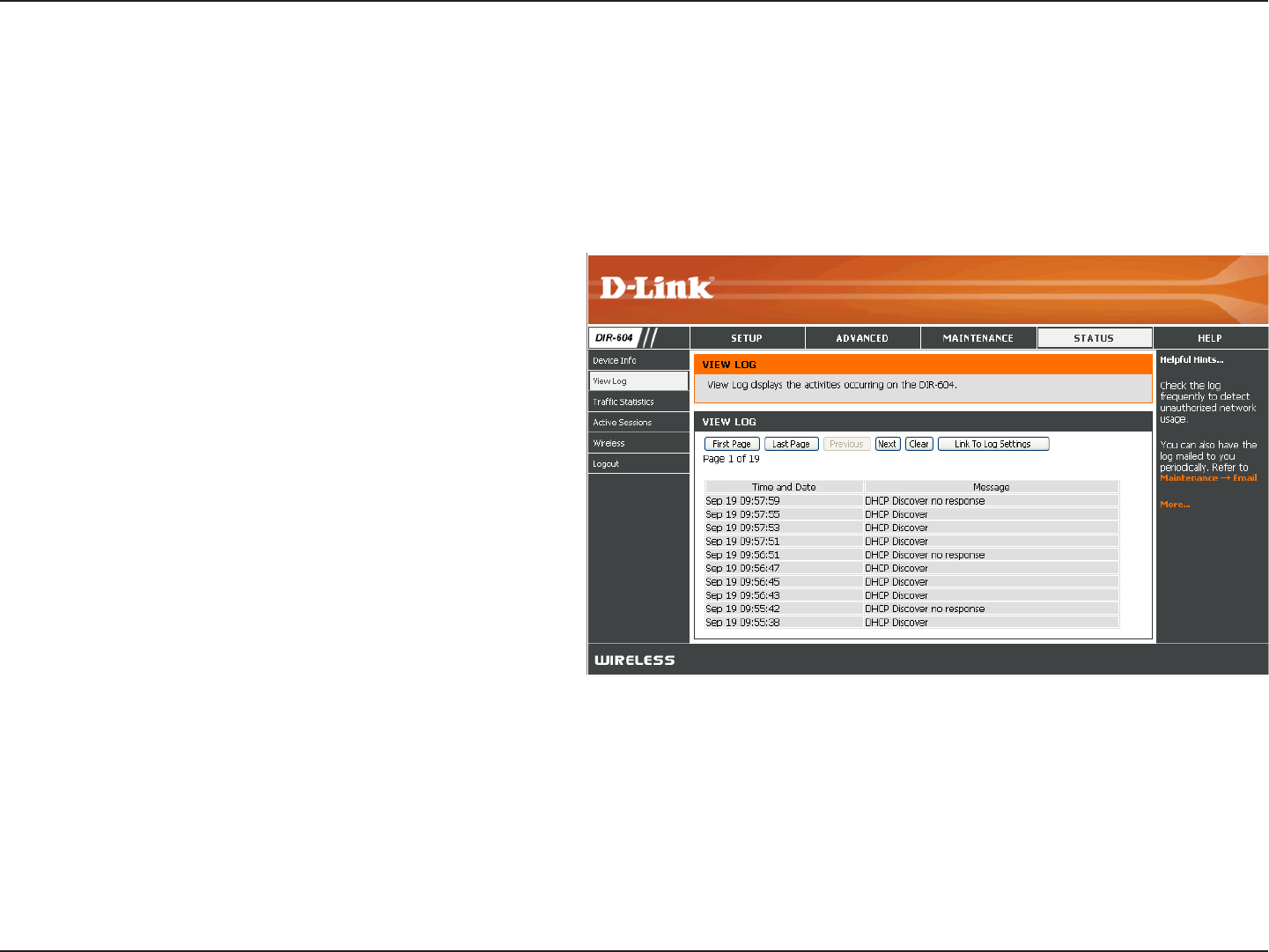
75D-Link DIR-604 User Manual
Section 3 - Configuration
View Log
First Page:
Last Page:
Previous:
Next:
Clear:
Link to Log
Settings:
Click this button to view the rst page of the
log le.
Click this button to view the last page of the
log le.
Click this button to view the previous page of
the log le.
Click this button to view the next page of the
log le.
Clears all of the log contents.
The user can click the button to “ link to log
settings” and save the logs to a local hard drive
or to a Syslog server.
The Router automatically logs (records) events of possible interest in its internal memory. If there is not enough internal
memory for all events, logs of older events are deleted but logs of the latest events are retained. The View Log option
allows you to view the router logs. You can dene what types of events you want to view and the level of the events
to view on the Log Settings page. The Router also has external Syslog Server support, so you can send the log les
to a computer on your network that is running a Syslog utility (see the Log Settings page).

76D-Link DIR-604 User Manual
Section 3 - Configuration
Traffic Statistics
The page displays the Trafc Statistics. Here you can view the amount of packets that pass through the DIR-604 on the
Internet, LAN, and Wireless connections. The trafc counter will reset if the device is rebooted. Alternatively, you can
click either the Reset button or the Refesh button.

77D-Link DIR-604 User Manual
Section 3 - Configuration
Active Sessions
The Active Sessions page displays full details of active Internet sessions through your Router. An Internet session is a
conversation between a program or application on a LAN-side computer and a program or application on a WAN-side
computer.
NAPT Session:
NAPT (Active)
Session:
Displays information about the NAPT sessions
on the Router, including the number of TCP
sessions, the number of UDP sessions, and
the combined number of TCP and UDP NAPT
sessions.
Displays the IP address of the local application
and the TCP/UDP packets being sent by
the source IP address for each NAPT active
Session.
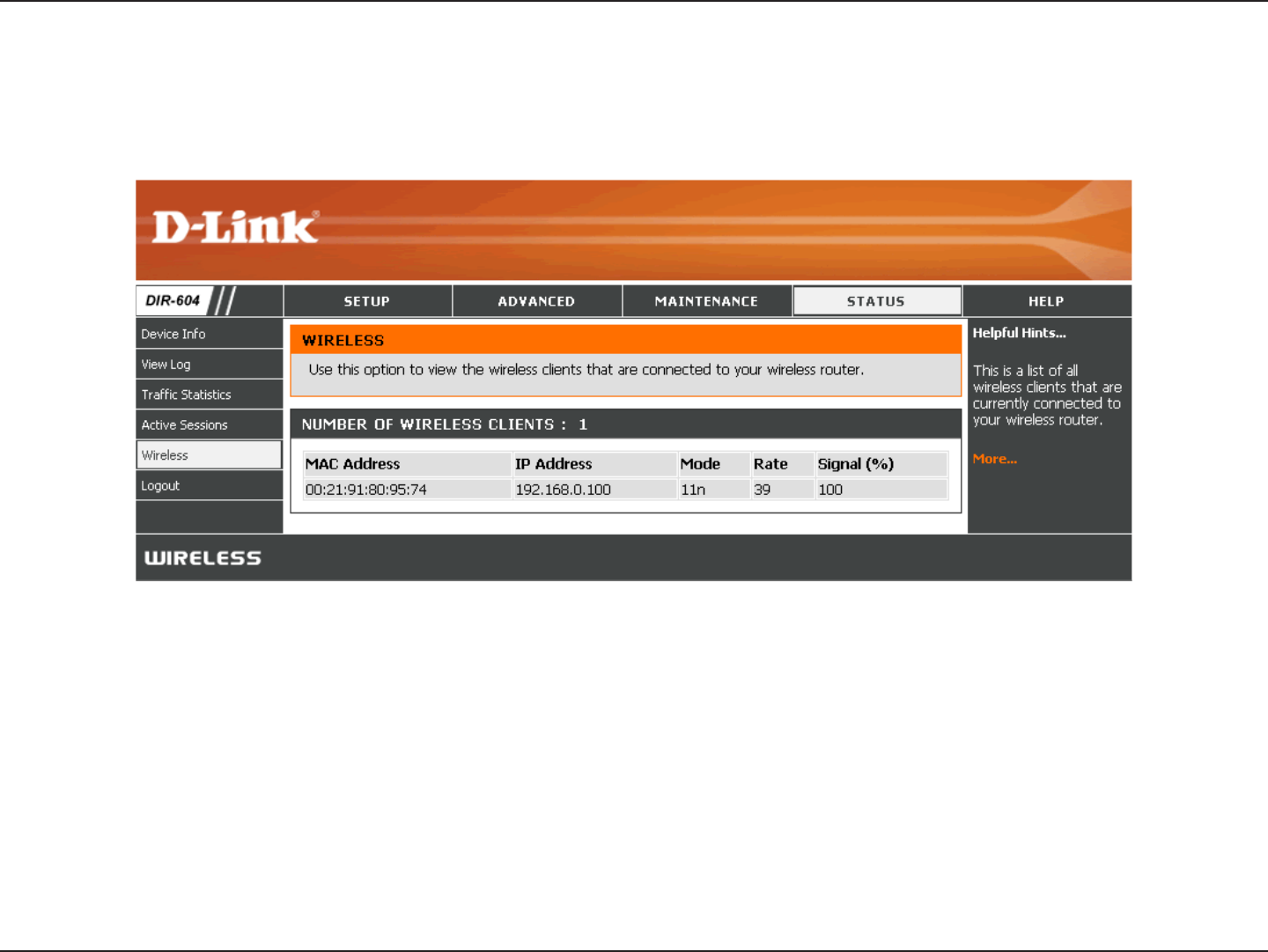
78D-Link DIR-604 User Manual
Section 3 - Configuration
The wireless client table displays a list of current connected wireless clients. This table also displays the connection
time and MAC address of the connected wireless clients.
Wireless
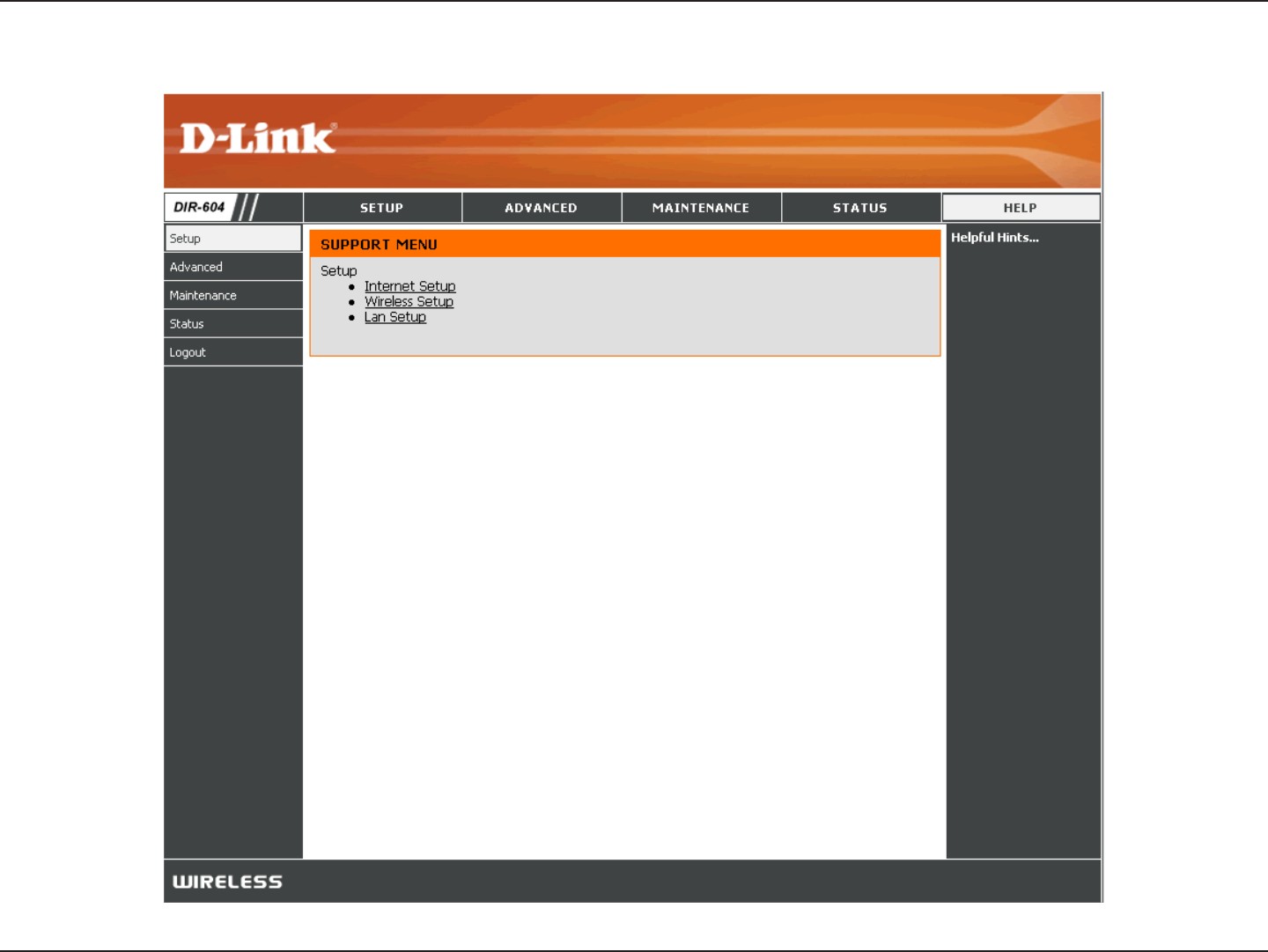
79D-Link DIR-604 User Manual
Section 3 - Configuration
Help

80D-Link DIR-604 User Manual
Section 4 - Security
Wireless Security
This section will show you the different levels of security you can use to protect your data from intruders. The DIR-604
offers the following types of security:
• WPA2 (Wi-Fi Protected Access 2) • WPA2-PSK(Pre-Shared Key)
• WPA (Wi-Fi Protected Access) • WPA-PSK (Pre-Shared Key)
What is WPA?
WPA, or Wi-Fi Protected Access, is a Wi-Fi standard that was designed to improve the security features of WEP (Wired
Equivalent Privacy).
The 2 major improvements over WEP:
• Improved data encryption through the Temporal Key Integrity Protocol (TKIP). TKIP scrambles the keys
using a hashing algorithm and, by adding an integrity-checking feature, ensures that the keys haven’t
been tampered with. WPA2 is based on 802.11i and uses Advanced Encryption Standard (AES) instead
of TKIP.
• User authentication, which is generally missing in WEP, through the extensible authentication protocol
(EAP). WEP regulates access to a wireless network based on a computer’s hardware-specic MAC
address, which is relatively simple to be sniffed out and stolen. EAP is built on a more secure public-key
encryption system to ensure that only authorized network users can access the network.
WPA-PSK/WPA2-PSK uses a passphrase or key to authenticate your wireless connection. The key is an alpha-numeric
password between 8 and 63 characters long. The password can include symbols (!?*&_) and spaces. This key must
be the exact same key entered on your wireless router or access point.
WPA/WPA2 incorporates user authentication through the Extensible Authentication Protocol (EAP). EAP is built on a
more secure public key encryption system to ensure that only authorized network users can access the network.

81D-Link DIR-604 User Manual
Section 4 - Security
Wireless Connection Setup Wizard
To run the security wizard, browse to the Setup page and then click the Wireless Connection Setup Wizard button.
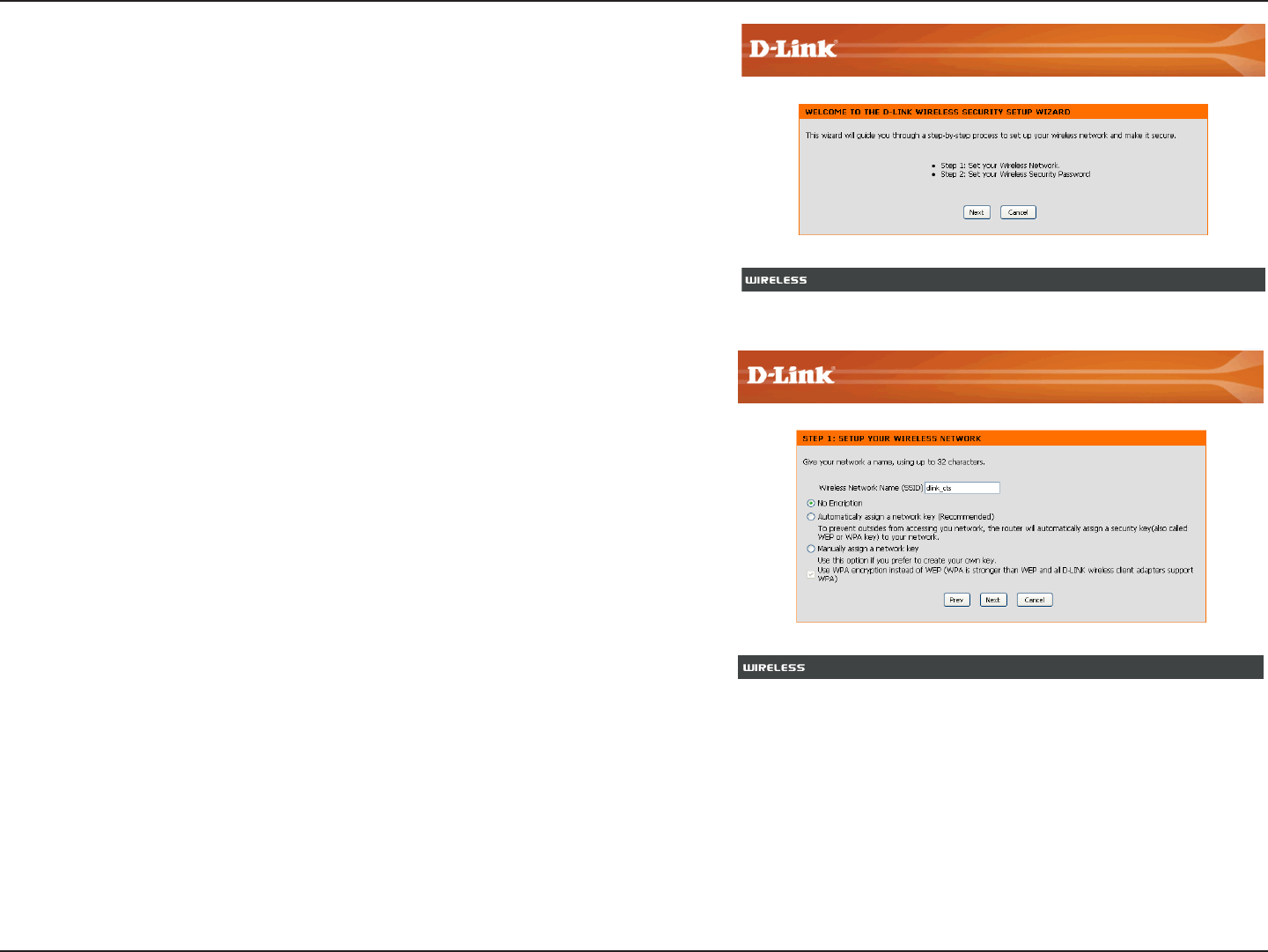
82D-Link DIR-604 User Manual
Section 4 - Security
Click Next to allow the setup wizard to guide you through a
step-by-step process to set up your wireless network and make
it secure.
Enter the SSID (Service Set Identier). The SSID is the name of
your wireless network. Create a name using up to 32 characters.
The SSID is case-sensitive.
If you would like the Router to automatically assign a network
key to your network, click the Automatically assign a network
key (Recommended) radio button.
Alternativley, click the Manually assign a network key radio
button to create your own network key.
Click Next to continue.
The following window appears if you selected the option to
manually create your own network key.
Type a password that you would like to use for wireless security
in the Wireless Security Password eld.
Click Next to continue.
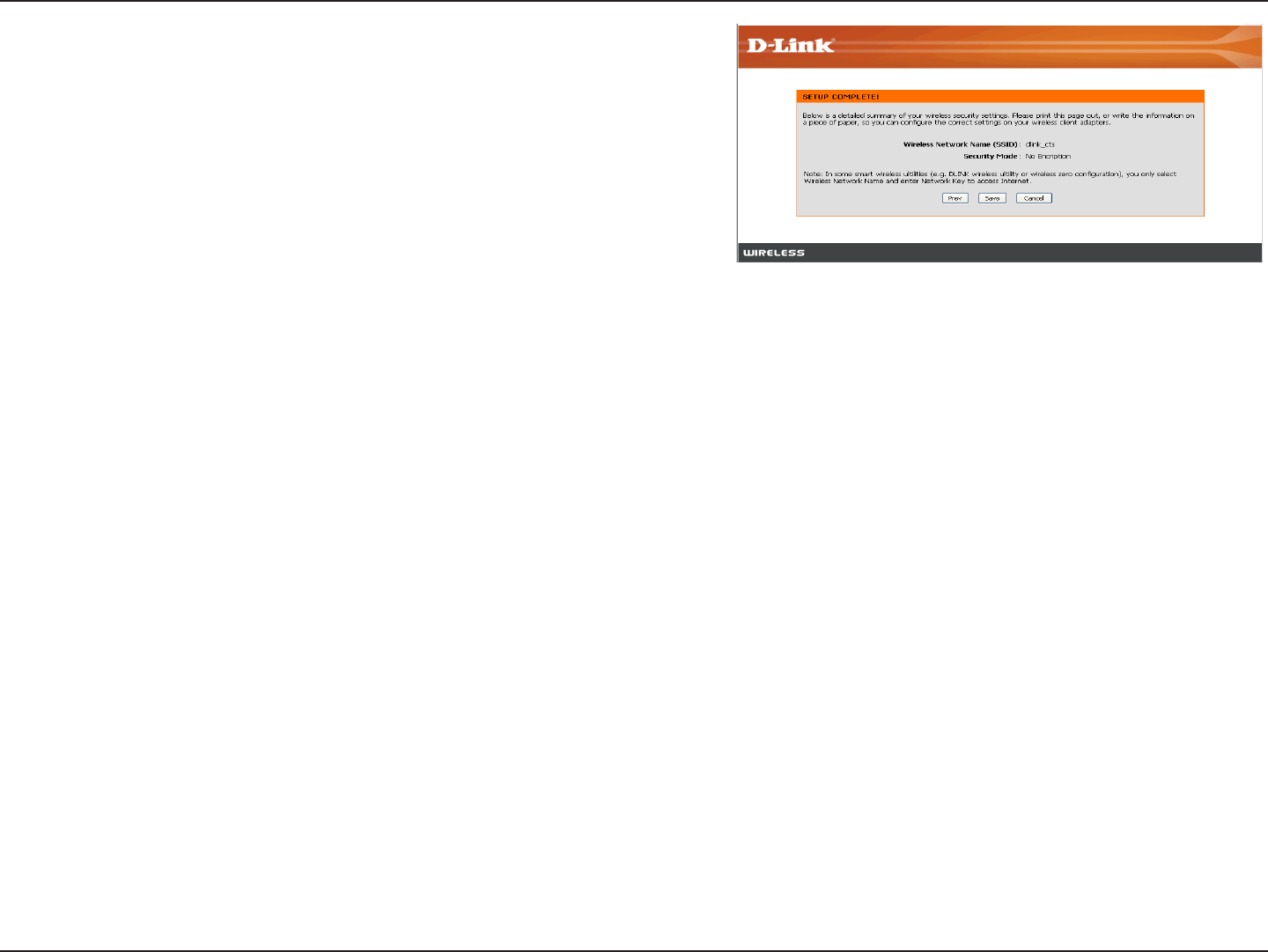
83D-Link DIR-604 User Manual
Section 4 - Security
The following window appears to indicate that the Wireless
Connection Setup Wizard is complete.
If you selected the option that automatically generated a
network key, the automatically generated key will display next
to the Pre-Shared Key eld.
If you manually specied a network key, the Wireless Security
Password that you specied will display next to the Pre-Shared
Key eld.
Click Save to nish the Security Wizard.

84D-Link DIR-604 User Manual
Section 4 - Security
From the Setup > Wireless Settings screen, click Add
Wireless Device with WPS.
Add Wireless Device with WPS Wizard
PIN: Select this option to use PIN method. In order to use this
method you must know the wireless client’s 8 digit PIN and
click Connect.
PBC: Select this option to use PBC (Push Button) method to
add a wireless client. Click Connect.
Select Auto to add a wireless client using WPS (Wi-Fi Protected
Setup). Once you select Auto and click Connect, you will have
a 120 second time limit to apply the settings to your wireless
client(s) and successfully establish a connection.
If you select Manual, a settings summary screen will appear.
Write down the security key and enter this on your wireless
clients.
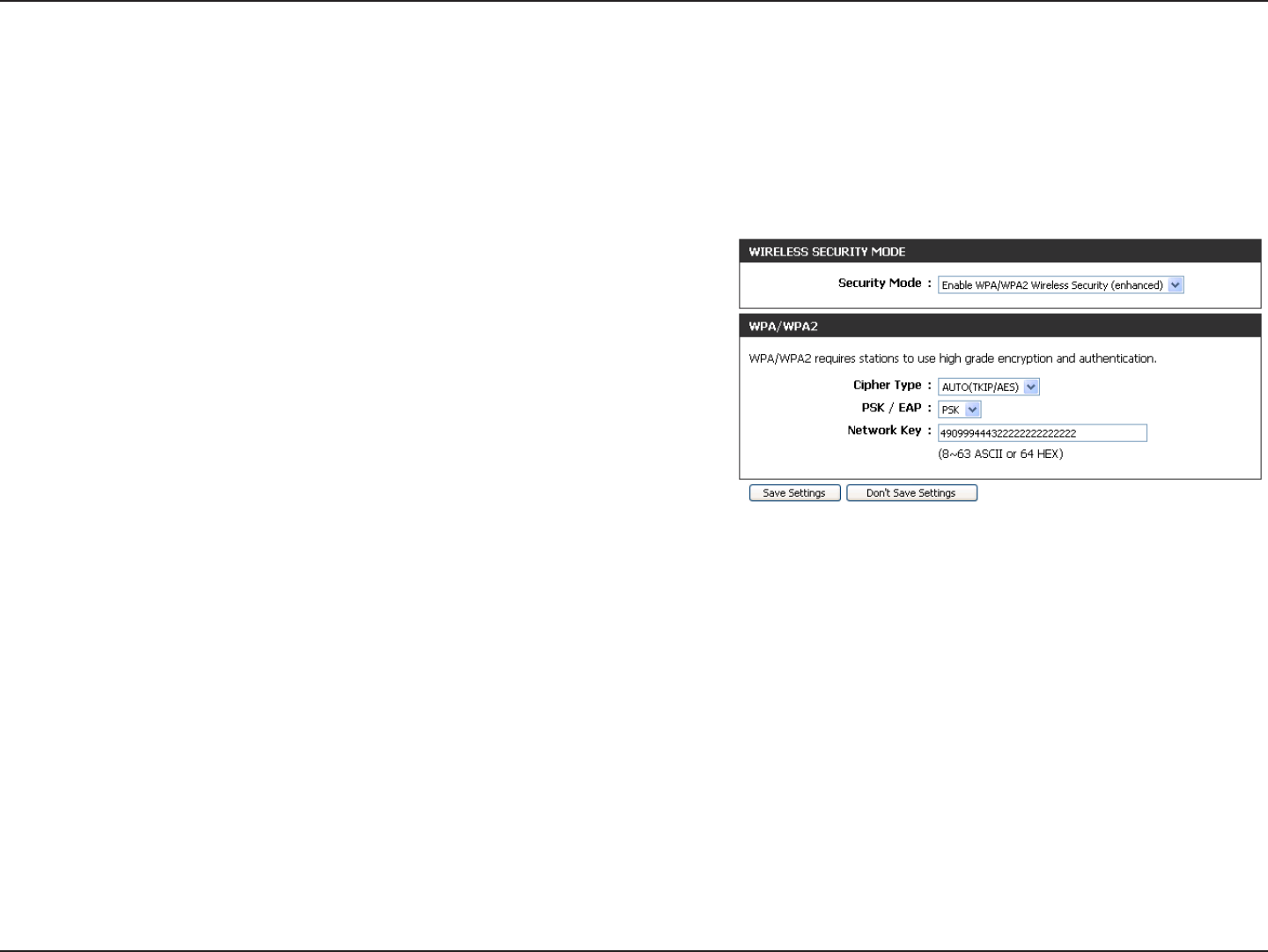
85D-Link DIR-604 User Manual
Section 4 - Security
Configure WPA-Personal (PSK)
It is recommended to enable encryption on your wireless router before your wireless network adapters. Please establish
wireless connectivity before enabling encryption. Your wireless signal may degrade when enabling encryption due to
the added overhead.
1. Log into the web-based conguration by opening a web browser
and entering the IP address of the router (192.168.0.1). Click on
Setup and then click Wireless Settings on the left side and then
click the Manual Wireless Network Setup button.
2. Select Enable WPA/WPA2 Wireless Security (enhanced) from
the Security Mode drop-down menu.
3. Select Auto(TKIP/AES), TKIP, or AES from the Cipher Type
drop-down menu. If you have wireless clients that use both types,
use TKIP/AES.
4. Select PSK from the PSK / EAP drop-down menu.
5. Enter a key (passphrase) in the Network Key eld. The key is entered as a pass-phrase in either ASCII or HEX format.
If using ASCII format the pass-phrase must be between 8-63 characters. If using HEX format the pass-phrase must
be 64 characters. The ASCII or HEX pass-phrase must be the same at both ends of the wireless connection.
6. Click Save Settings to save your settings. If you are conguring the router with a wireless adapter, you will lose
connectivity until you enable WPA-PSK on your adapter and enter the same passphrase as you did on the router.

86D-Link DIR-604 User Manual
Section 4 - Security
Configure WPA-Enterprise (RADIUS)
It is recommended to enable encryption on your wireless router before your wireless network adapters. Please establish
wireless connectivity before enabling encryption. Your wireless signal may degrade when enabling encryption due to
the added overhead.
1. Log into the web-based conguration by opening a web browser
and entering the IP address of the router (192.168.0.1). Click on
Setup and then click Wireless Settings on the left side and then
click the Manual Wireless Network Setup button.
2. Select Enable WPA/WPA2 Wireless Security (Enhanced) from
the Security Mode drop-down menu.
3. Select Auto(TKIP/AES), TKIP, or AES from the Cipher Type
drop-down menu. If you have wireless clients that use both types,
use TKIP/AES.
4. Select EAP from the PSK / EAP drop-down menu.
5. Enter the IP Address of your RADIUS server in the RADIUS Server IP Address eld.
6. Enter the port you are using with your RADIUS server in the Port eld.
7. Enter the security key in the Shared Secret eld.
8. Click Save Settings to save your settings. If you are conguring the router with a wireless adapter, you will lose
connectivity until you enable WPA-Enterprise (RADIUS) on your adapter and enter the same passphrase as you did
on the router.
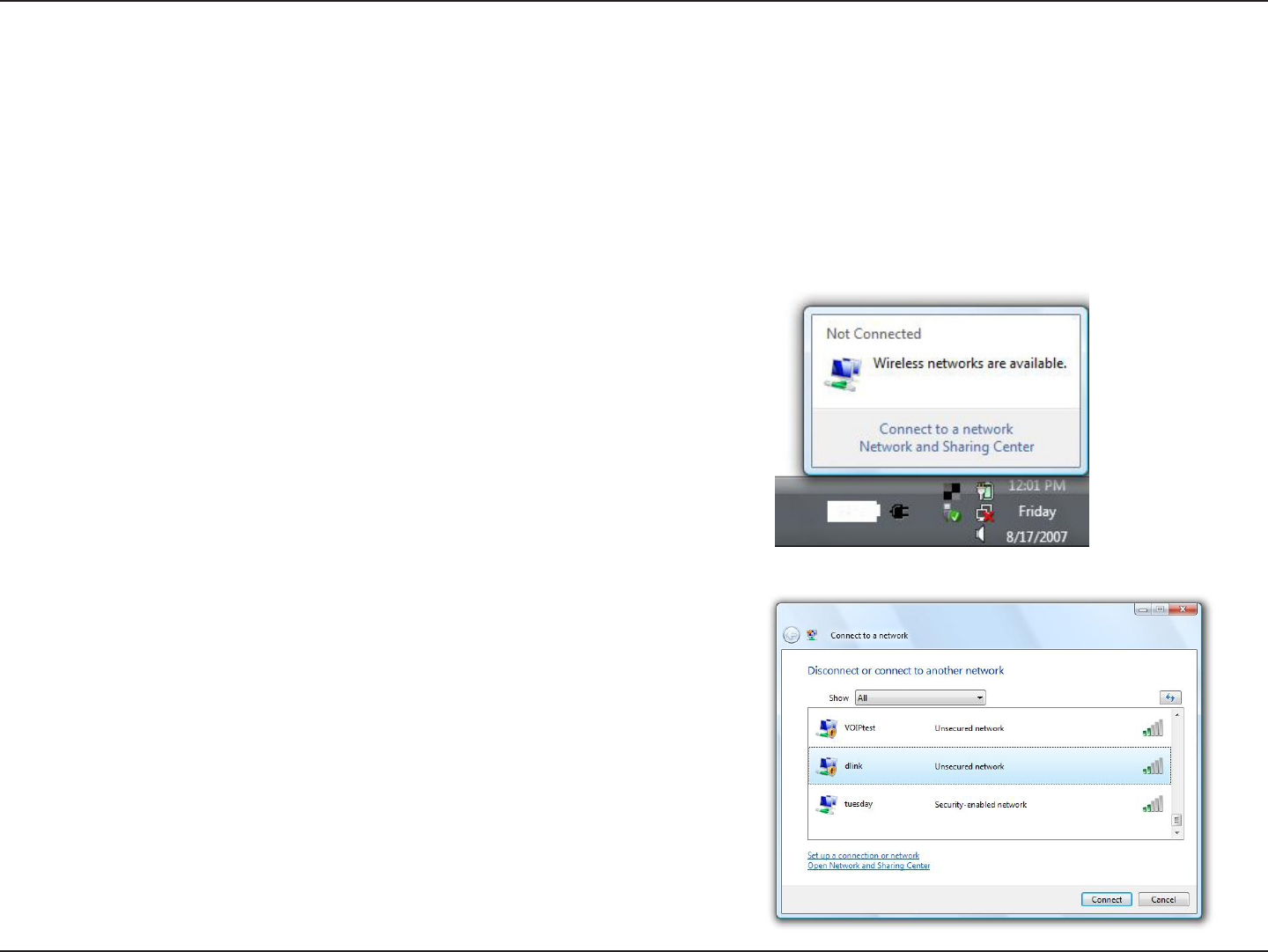
87D-Link DIR-604 User Manual
Section 5 - Connecting to a Wireless Network
Connect to a Wireless Network
Using Windows Vista®
Windows Vista® users may use the built-in wireless utility. If you are using another company’s utility or Windows® 2000,
please refer to the user manual of your wireless adapter for help with connecting to a wireless network. Most utilities
will have a “site survey” option similar to the Windows Vista® utility as seen below.
Right-click on the wireless computer icon in your system tray
(lower-right corner next to the time). Select Connect to a
network.
If you receive the Wireless Networks Detected bubble, click
on the center of the bubble to access the utility.
or
The utility will display any available wireless networks in your
area. Click on a network (displayed using the SSID) and click
the Connect button.
If you get a good signal but cannot access the Internet, check
you TCP/IP settings for your wireless adapter. Refer to the
Networking Basics section in this manual for more information.
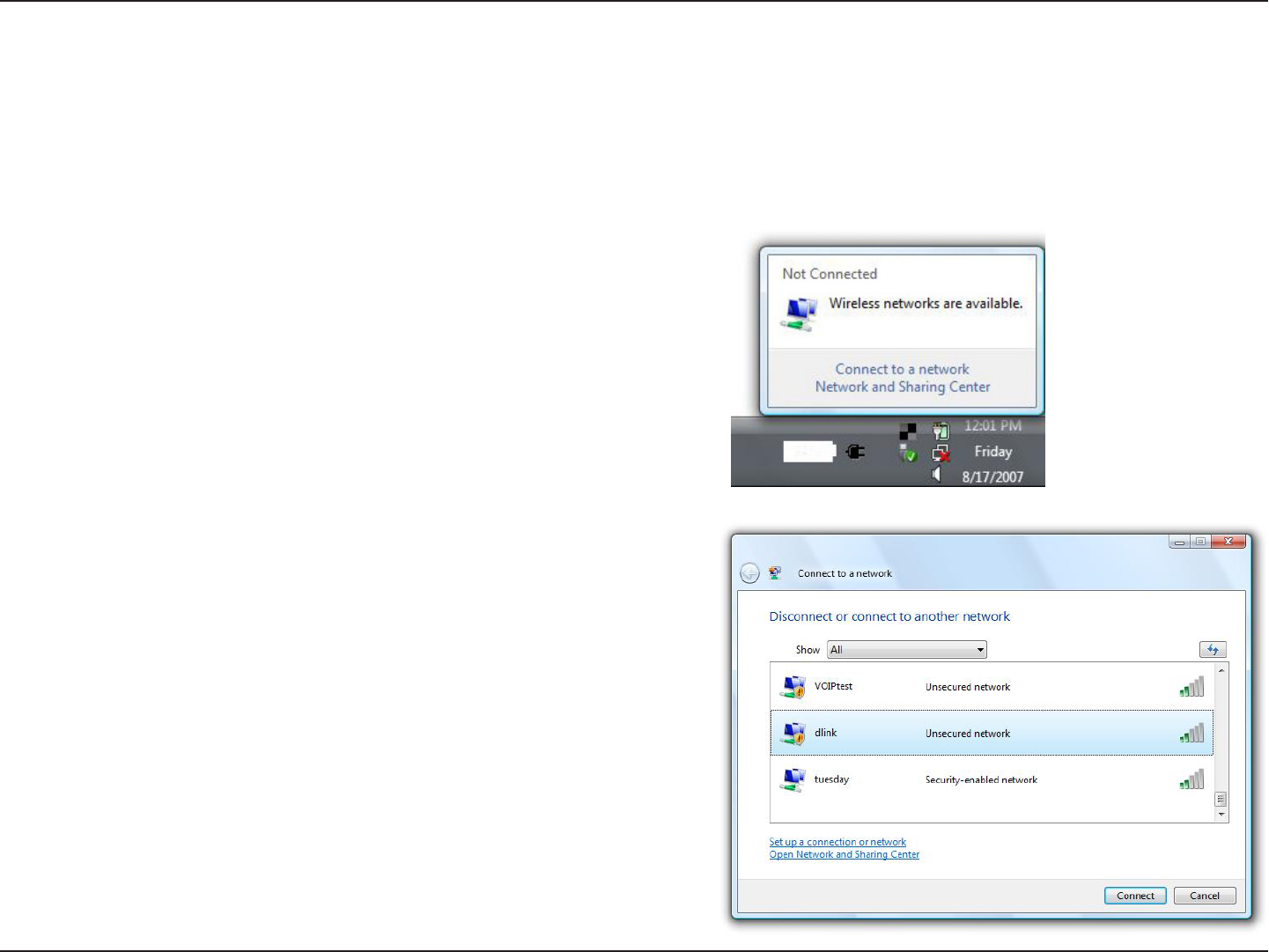
88D-Link DIR-604 User Manual
Section 5 - Connecting to a Wireless Network
Configure WPA/WPA2
It is recommended to enable wireless security (WPA/WPA2) on your wireless router or access point before conguring
your wireless adapter. If you are joining an existing network, you will need to know the security key or passphrase
being used.
2. Highlight the wireless network (SSID) you would like to
connect to and click Connect.
1. Open the Windows Vista® Wireless Utility by right-clicking
on the wireless computer icon in your system tray (lower
right corner of screen). Select Connect to a network.
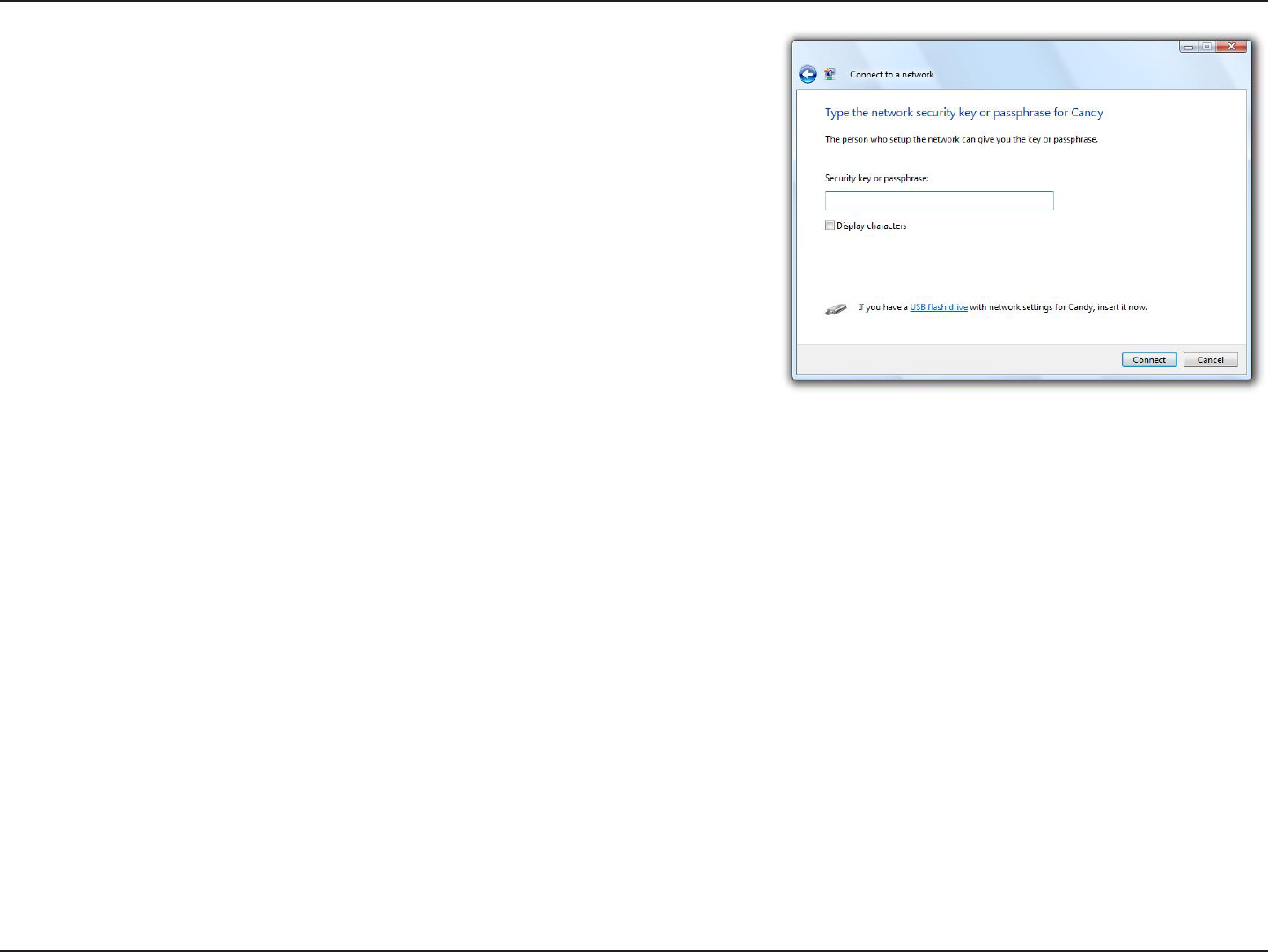
89D-Link DIR-604 User Manual
Section 5 - Connecting to a Wireless Network
3. Enter the same security key or passphrase that is on your router
and click Connect.
It may take 20-30 seconds to connect to the wireless network. If the
connection fails, please verify that the security settings are correct.
The key or passphrase must be exactly the same as on the wireless
router.
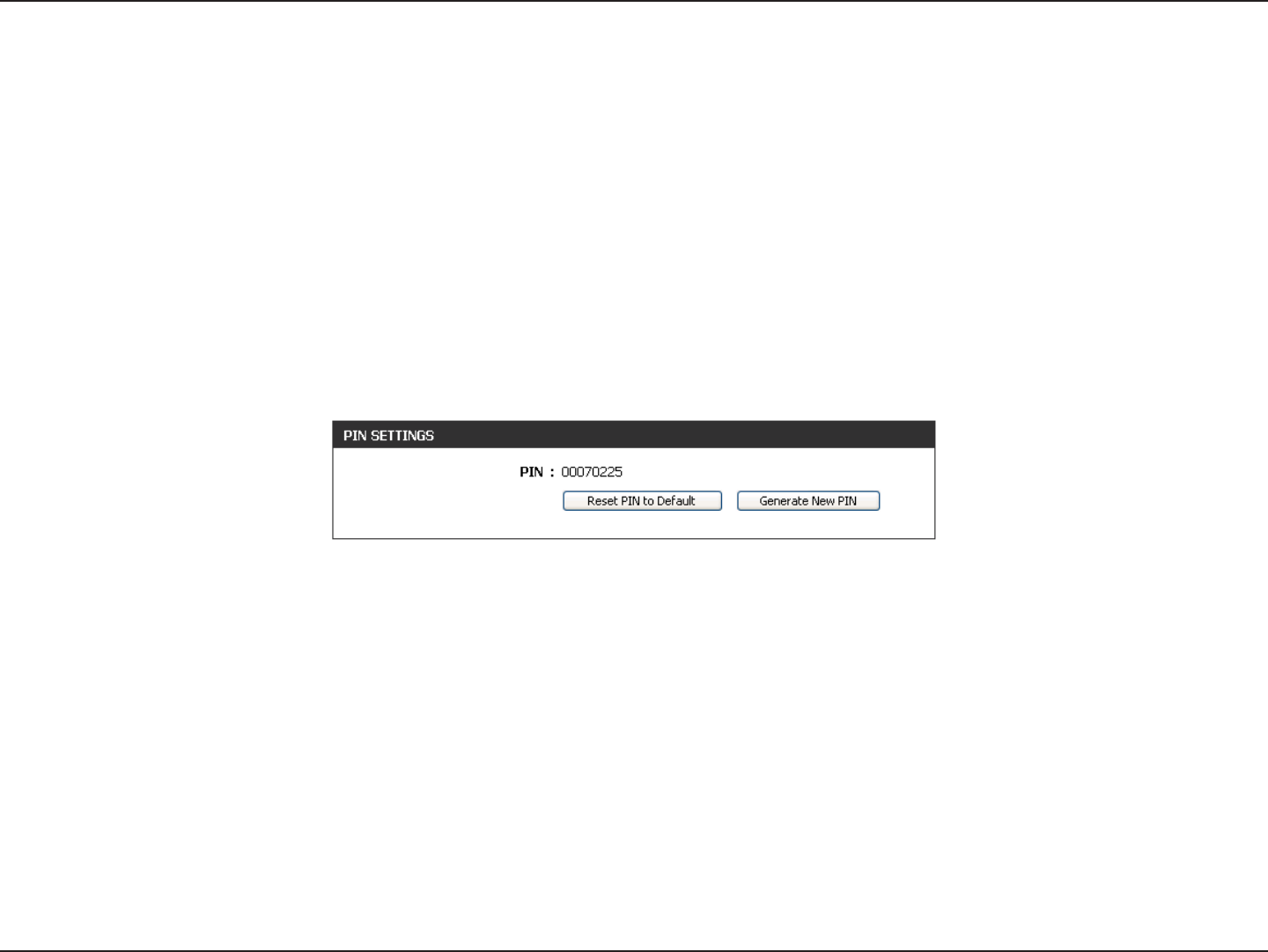
90D-Link DIR-604 User Manual
Section 5 - Connecting to a Wireless Network
Connect Using WCN 2.0
The Router supports Wi-Fi protection, referred to as WCN 2.0 in Windows Vista®. The following instructions for setting
this up depends on whether you are using Windows Vista® to congure the router or third party software.
When you rst set up the Router, Wi-Fi protection is disabled and uncongured. To enjoy the benets of Wi-Fi protection,
the router must be both enabled and congured. There are three basic methods to accomplish this: use Windows
Vista’s built-in support for WCN 2.0, use software provided by a third party, or manually congure.
If you are running Windows Vista®, log into the router and click the Enable checkbox in the Advanced > Wi-Fi Protected
Setup window. Use the Current PIN that is displayed in the PIN Settings section of Advanced > Wi-Fi Protected
Setup window or choose to click the Generate New PIN button or Reset PIN to Default button.
If you are using third party software to set up Wi-Fi Protection, carefully follow the directions. When you are nished,
proceed to the next section to set up the newly-congured router.
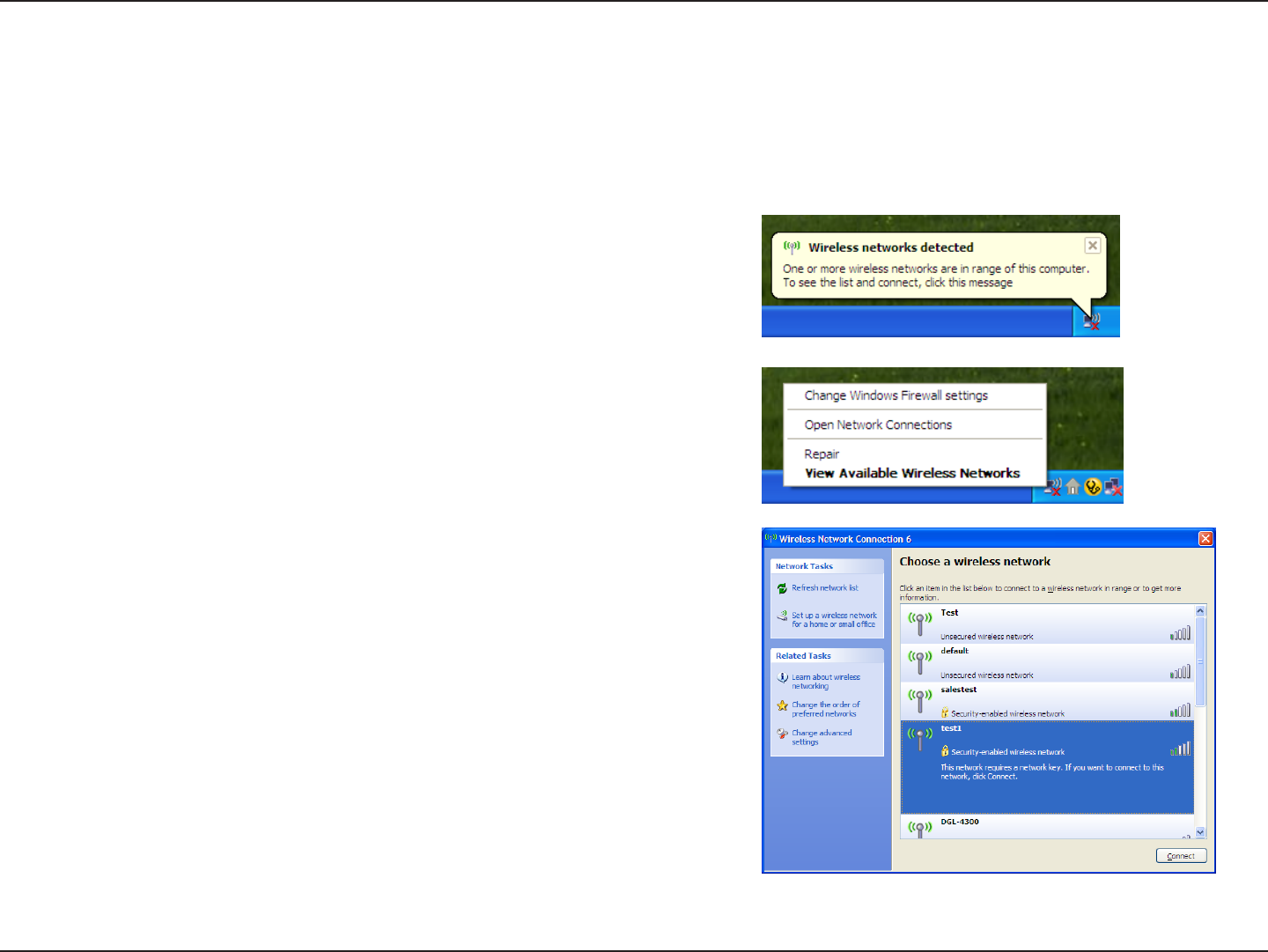
91D-Link DIR-604 User Manual
Section 5 - Connecting to a Wireless Network
Using Windows® XP
Windows® XP users may use the built-in wireless utility (Zero Conguration Utility). The following instructions are for
Service Pack 2 users. If you are using another company’s utility or Windows® 2000, please refer to the user manual
of your wireless adapter for help with connecting to a wireless network. Most utilities will have a “site survey” option
similar to the Windows® XP utility as seen below.
If you receive the Wireless Networks Detected bubble, click
on the center of the bubble to access the utility.
or
Right-click on the wireless computer icon in your system tray
(lower-right corner next to the time). Select View Available
Wireless Networks.
The utility will display any available wireless networks in your
area. Click on a network (displayed using the SSID) and click
the Connect button.
If you get a good signal but cannot access the Internet, check
you TCP/IP settings for your wireless adapter. Refer to the
Networking Basics section in this manual for more information.
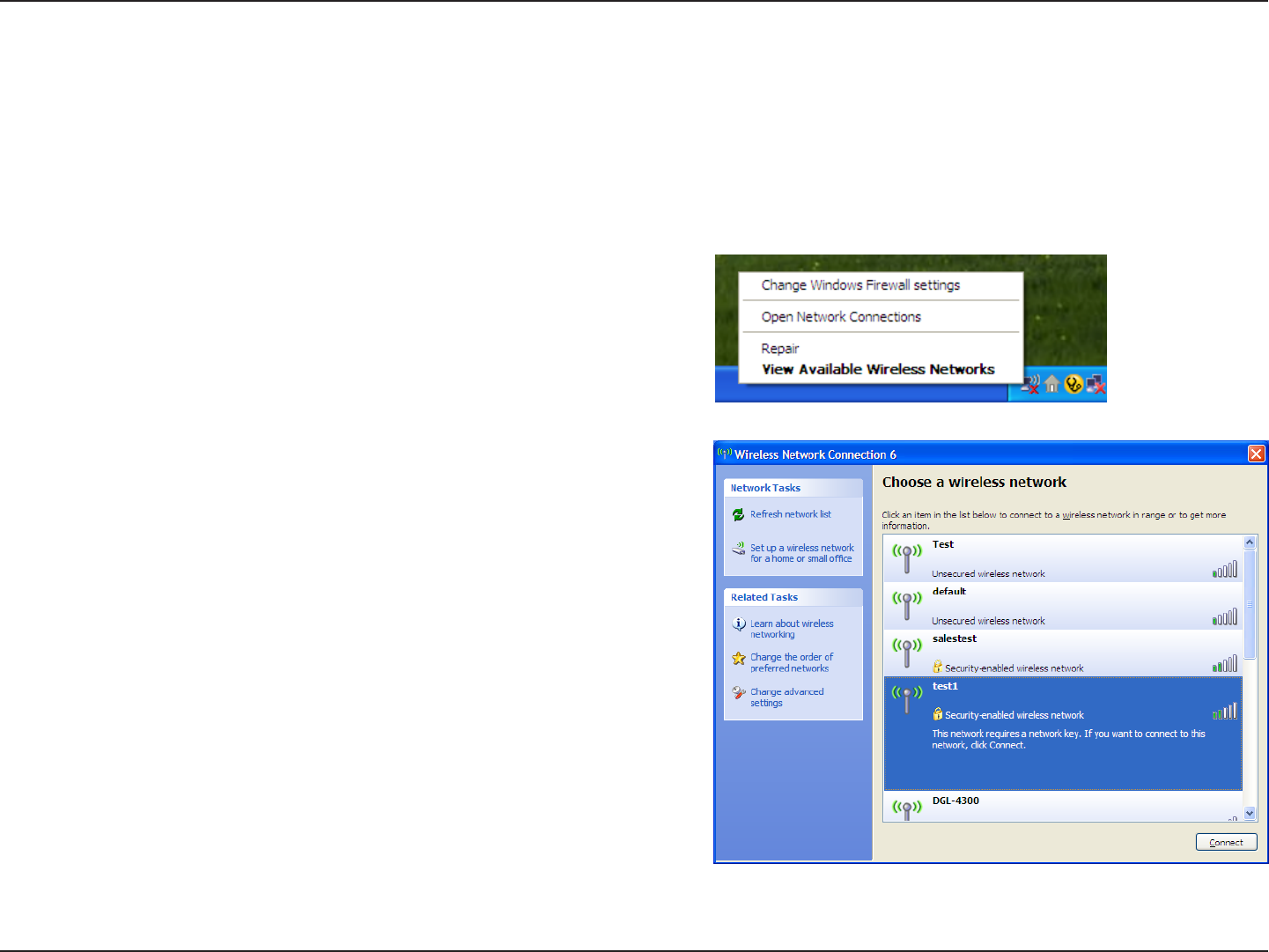
92D-Link DIR-604 User Manual
Section 5 - Connecting to a Wireless Network
Configure WPA-PSK
It is recommended to enable WEP on your wireless router or access point before conguring your wireless adapter. If
you are joining an existing network, you will need to know the WEP key being used.
2. Highlight the wireless network (SSID) you would like to
connect to and click Connect.
1. Open the Windows® XP Wireless Utility by right-clicking
on the wireless computer icon in your system tray
(lower-right corner of screen). Select View Available
Wireless Networks.
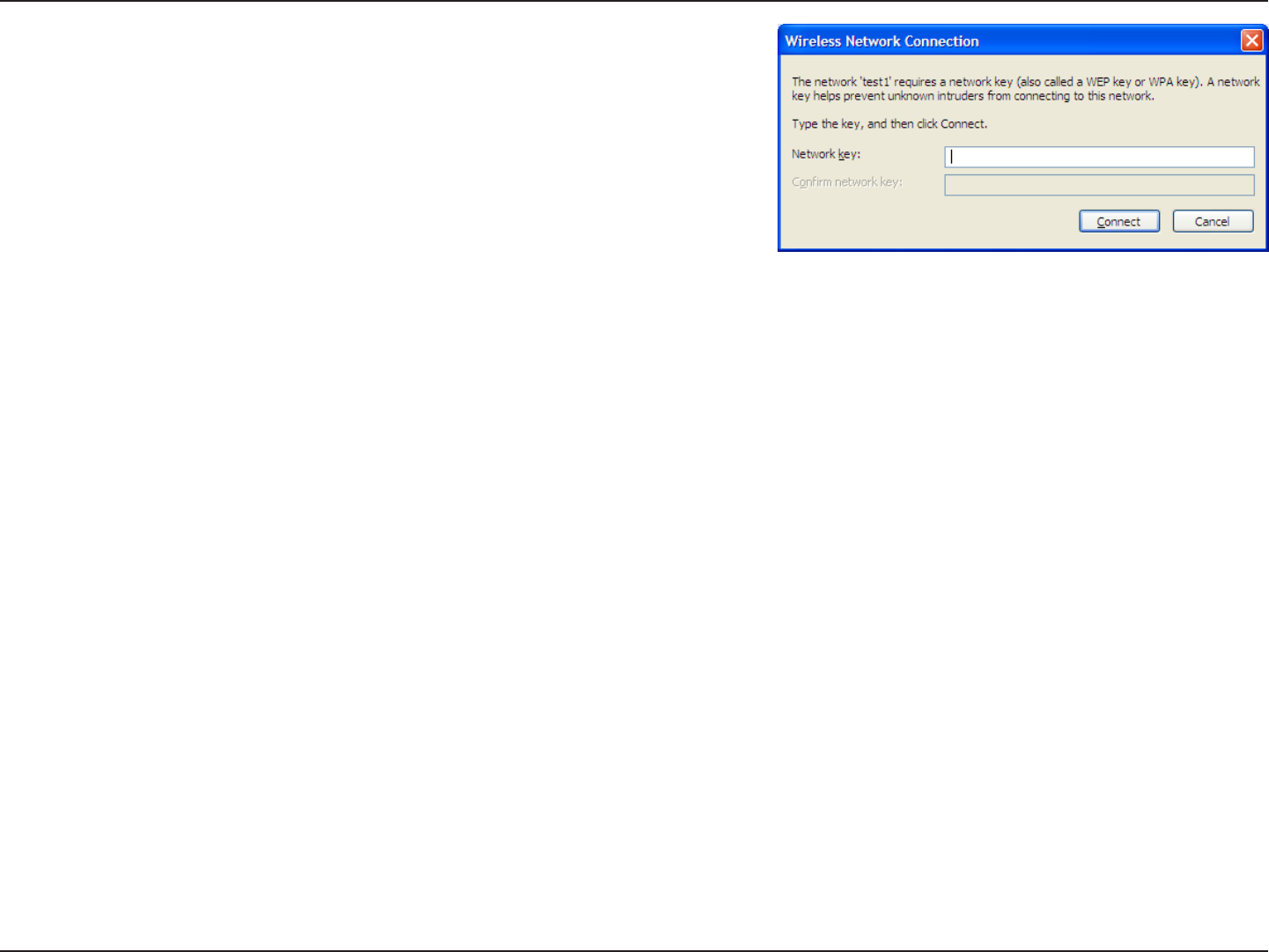
93D-Link DIR-604 User Manual
Section 5 - Connecting to a Wireless Network
3. The Wireless Network Connection box will appear. Enter the
WPA-PSK passphrase and click Connect.
It may take 20-30 seconds to connect to the wireless network. If the
connection fails, please verify that the WPA-PSK settings are correct.
The WPA-PSK passphrase must be exactly the same as on the
wireless router.

94D-Link DIR-604 User Manual
Section 6 - Troubleshooting
Troubleshooting
This chapter provides solutions to problems that can occur during the installation and operation of the DIR-604. Read
the following descriptions if you are having problems. (The examples below are illustrated in Windows® XP. If you
have a different operating system, the screen shots on your computer will look similar to the following examples.)
1. Why can’t I access the Web-based conguration utility?
When entering the IP address of the D-Link Router (192.168.0.1 for example), you are not connecting to a Website
on the Internet or have to be connected to the Internet. The device has the utility built-in to a ROM chip in the device
itself. Your computer must be on the same IP subnet to connect to the Web-based utility.
• Make sure you have an updated Java-enabled Web browser. We recommend the following:
• Internet Explorer 6.0 or higher
• Netscape 8 or higher
• Mozilla 1.7.12 (5.0) or higher
• Opera 8.5 or higher
• Safari 1.2 or higher (with Java 1.3.1 or higher)
• Camino 0.8.4 or higher
• Firefox 1.5 or higher
• Verify physical connectivity by checking for solid link lights on the device. If you do not get a solid link light, try using
a different cable or connect to a different port on the device if possible. If the computer is turned off, the link light may
not be on.
• Disable any Internet security software running on the computer. Software rewalls such as Zone Alarm, Black Ice,
Sygate, Norton Personal Firewall, and Windows® XP rewall may block access to the conguration pages. Check the
help les included with your rewall software for more information on disabling or conguring it.

95D-Link DIR-604 User Manual
Section 6 - Troubleshooting
• Congure your Internet settings:
• Go to Start > Settings > Control Panel. Double-click the Internet Options Icon. From the Security tab,
click the button to restore the settings to their defaults.
• Click the Connection tab and set the dial-up option to Never Dial a Connection. Click the LAN Settings
button. Make sure nothing is checked. Click OK.
• Go to the Advanced tab and click the button to restore these settings to their defaults. Click OK three
times.
• Close your Web browser (if open) and open it.
• Access the Web management. Open your Web browser and enter the IP address of your D-Link router in the address
bar. This should open the login page for your the Web management.
• If you still cannot access the conguration, unplug the power to the router for 10 seconds and plug back in. Wait
about 30 seconds and try accessing the conguration. If you have multiple computers, try connecting using a different
computer.
2. What can I do if I forgot my password?
If you forgot your password, you must reset your router. Unfortunately this process will change all your settings back
to the factory defaults.
To reset the router, locate the reset button (hole) on the rear panel of the unit. With the router powered on, use a
paperclip to hold the button down for 10 seconds. Release the button and the router will go through its reboot process.
Wait about 30 seconds to access the router. The default IP address is 192.168.0.1. When logging in, the username is
admin and leave the password box empty.

96D-Link DIR-604 User Manual
Section 6 - Troubleshooting
3. Why can’t I connect to certain sites or send and receive e-mails when connecting through my router?
If you are having a problem sending or receiving e-mail, or connecting to secure sites such as eBay, banking sites,
and Hotmail, we suggest lowering the MTU in increments of ten (Ex. 1492, 1482, 1472, etc).
Note: AOL DSL+ users must use MTU of 1400.
To nd the proper MTU Size, you’ll have to do a special ping of the destination you’re trying to go to. A destination
could be another computer, or a URL.
• Click on Start and then click Run.
• Windows® 95, 98, and Me users type in command (Windows® NT, 2000, and XP users type in cmd) and
press Enter (or click OK).
• Once the window opens, you’ll need to do a special ping. Use the following syntax:
ping [url] [-f] [-l] [MTU value]
Example: ping yahoo.com -f -l 1472

97D-Link DIR-604 User Manual
Section 6 - Troubleshooting
You should start at 1472 and work your way down by 10 each time. Once you get a reply, go up by 2 until you get a
fragmented packet. Take that value and add 28 to the value to account for the various TCP/IP headers. For example,
lets say that 1452 was the proper value, the actual MTU size would be 1480, which is the optimum for the network
we’re working with (1452+28=1480).
Once you nd your MTU, you can now congure your router with the proper MTU size.
To change the MTU rate on your router follow the steps below:
• Open your browser, enter the IP address of your router (192.168.0.1) and click OK.
• Enter your username (admin) and password (blank by default). Click OK to enter the web conguration
page for the device.
• Click on Setup>Internet and then click Manual Internet Connection Setup.
• To change the MTU enter the number in the MTU eld and click Save Settings to save your settings.
• Test your e-mail. If changing the MTU does not resolve the problem, continue changing the MTU in
increments of ten.

98D-Link DIR-604 User Manual
Appendix A - Wireless Basics
D-Link wireless products are based on industry standards to provide easy-to-use and compatible high-speed wireless
connectivity within your home, business or public access wireless networks. Strictly adhering to the IEEE standard,
the D-Link wireless family of products will allow you to securely access the data you want, when and where you want
it. You will be able to enjoy the freedom that wireless networking delivers.
A wireless local area network (WLAN) is a cellular computer network that transmits and receives data with radio signals
instead of wires. Wireless LANs are used increasingly in both home and ofce environments, and public areas such
as airports, coffee shops and universities. Innovative ways to utilize WLAN technology are helping people to work and
communicate more efciently. Increased mobility and the absence of cabling and other xed infrastructure have proven
to be benecial for many users.
Wireless users can use the same applications they use on a wired network. Wireless adapter cards used on laptop
and desktop systems support the same protocols as Ethernet adapter cards.
Under many circumstances, it may be desirable for mobile network devices to link to a conventional Ethernet LAN in
order to use servers, printers or an Internet connection supplied through the wired LAN. A Wireless Router is a device
used to provide this link.
Wireless Basics

99D-Link DIR-604 User Manual
Appendix A - Wireless Basics
What is Wireless?
Wireless or Wi-Fi technology is another way of connecting your computer to the network without using wires.
Wi-Fi uses radio frequency to connect wirelessly, so you have the freedom to connect computers anywhere
in your home or ofce network.
Why D-Link Wireless?
D-Link is the worldwide leader and award winning designer, developer, and manufacturer of networking
products. D-Link delivers the performance you need at a price you can afford. D-Link has all the products
you need to build your network.
How does wireless work?
Wireless works similar to how cordless phone work, through radio signals to transmit data from one point
A to point B. But wireless technology has restrictions as to how you can access the network. You must be
within the wireless network range area to be able to connect your computer. There are two different types
of wireless networks Wireless Local Area Network (WLAN), and Wireless Personal Area Network (WPAN).
Wireless Local Area Network (WLAN)
In a wireless local area network, a device called an access point (AP) connects computers to the network.
The access point has a small antenna attached to it, which allows it to transmit data back and forth over
radio signals. With an indoor access point as seen in the picture, the signal can travel up to 300 feet. With
an outdoor access point the signal can reach out up to 30 miles to serve places like manufacturing plants,
industrial locations, college and high school campuses, airports, golf courses, and many other outdoor venues.

100D-Link DIR-604 User Manual
Appendix A - Wireless Basics
Wireless Personal Area Network (WPAN)
Bluetooth is the industry standard wireless technology used for WPAN. Bluetooth devices in WPAN operate
in a range up to 30 feet away.
Compared to WLAN the speed and wireless operation range are both less than WLAN, but in return it
doesn’t use nearly as much power which makes it ideal for personal devices, such as mobile phones, PDAs,
headphones, laptops, speakers, and other devices that operate on batteries.
Who uses wireless?
Wireless technology as become so popular in recent years that almost everyone is using it, whether it’s for
home, ofce, business, D-Link has a wireless solution for it.
Home
• Gives everyone at home broadband access
• Surf the Web, check e-mail, instant message, and etc.
• Gets rid of the cables around the house
• Simple and easy to use
Small Ofce and Home Ofce
• Stay on top of everything at home as you would at ofce
• Remotely access your ofce network from home
• Share Internet connection and printer with multiple computers
• No need to dedicate ofce space

101D-Link DIR-604 User Manual
Appendix A - Wireless Basics
Where is wireless used?
Wireless technology is expanding everywhere not just at home or ofce. People like the freedom of mobility
and it’s becoming so popular that more and more public facilities now provide wireless access to attract people.
The wireless connection in public places is usually called “hotspots”.
Using a D-Link Cardbus Adapter with your laptop, you can access the hotspot to connect to Internet from
remote locations like: Airports, Hotels, Coffee Shops, Libraries, Restaurants, and Convention Centers.
Wireless network is easy to setup, but if you’re installing it for the rst time it could be quite a task not knowing
where to start. That’s why we’ve put together a few setup steps and tips to help you through the process of
setting up a wireless network.
Tips
Here are a few things to keep in mind, when you install a wireless network.
Centralize your router or access point
Make sure you place the router/access point in a centralized location within your network for the best
performance. Try to place the router/access point as high as possible in the room, so the signal gets dispersed
throughout your home. If you have a two-story home, you may need a repeater to boost the signal to extend
the range.
Eliminate Interference
Place home appliances such as cordless telephones, microwaves, and televisions as far away as possible
from the router/access point. This would signicantly reduce any interference that the appliances might cause
since they operate on same frequency.

102D-Link DIR-604 User Manual
Appendix A - Wireless Basics
Security
Don’t let you next-door neighbors or intruders connect to your wireless network. Secure your wireless network
by turning on the WPA or WEP security feature on the router. Refer to product manual for detail information
on how to set it up.
There are basically two modes of networking:
• Infrastructure – All wireless clients will connect to an access point or wireless router.
• Ad-Hoc – Directly connecting to another computer, for peer-to-peer communication, using wireless
network adapters on each computer, such as two or more DIR-604 wireless network Cardbus adapters.
An Infrastructure network contains an access point or wireless router. All the wireless devices, or clients, will connect
to the wireless router or access point.
An Ad-Hoc network contains only clients, such as laptops with wireless cardbus adapters. All the adapters must be in
Ad-Hoc mode to communicate.
Wireless Modes

103D-Link DIR-604 User Manual
Appendix B - Networking Basics
Networking Basics
Check your IP address
After you install your adapter, by default, the TCP/IP settings should be set to obtain an IP address from a DHCP server
(i.e. wireless router) automatically. To verify your IP address, please follow the steps below.
Click on Start > Run. In the run box type cmd and click OK. (Windows Vista® users type cmd in the Start Search box.)
At the prompt, type ipconfig and press Enter.
This will display the IP address, subnet mask, and
the default gateway of your adapter.
If the address is 0.0.0.0, check your adapter
installation, security settings, and the settings on
your router. Some rewall software programs may
block a DHCP request on newly installed adapters.
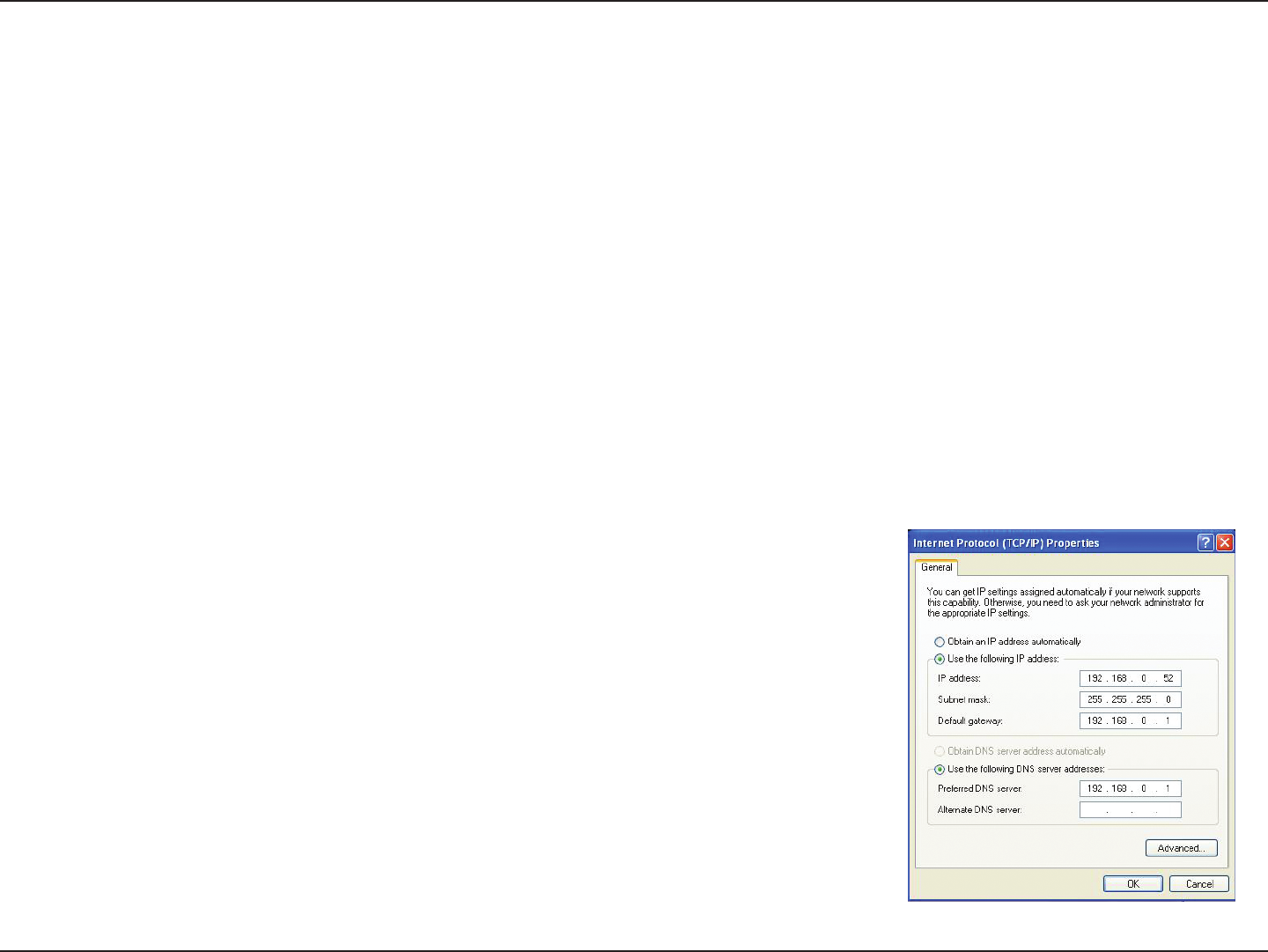
104D-Link DIR-604 User Manual
Appendix B - Networking Basics
Statically Assign an IP address
If you are not using a DHCP capable gateway/router, or you need to assign a static IP address, please follow the steps
below:
Step 1
Windows Vista® - Click on Start > Control Panel > Network and Internet > Network and Sharing Center > Manage
Network Connections.
Windows® XP - Click on Start > Control Panel > Network Connections.
Windows® 2000 - From the desktop, right-click My Network Places > Properties.
Step 2
Right-click on the Local Area Connection which represents your network adapter and select Properties.
Step 3
Highlight Internet Protocol (TCP/IP) and click Properties.
Step 4
Click Use the following IP address and enter an IP address that is on the same
subnet as your network or the LAN IP address on your router.
Example: If the router´s LAN IP address is 192.168.0.1, make your IP address
192.168.0.X where X is a number between 2 and 99. Make sure that the number
you choose is not in use on the network. Set Default Gateway the same as the LAN
IP address of your router (192.168.0.1).
Set Primary DNS the same as the LAN IP address of your router (192.168.0.1).
The Secondary DNS is not needed or you may enter a DNS server from your ISP.
Step 5
Click OK twice to save your settings.

107D-Link DIR-604 User Manual
Appendix D - Contacting Technical Support
以下警語適用台灣地
經型式認證合格之低功率射頻電機,非經許可,公司、商號或使用者均不得擅自變更頻率、
加大功率或變更原設計之特性及功能。
低功率射頻電機之使用不得影響飛航安全及干擾合法通信;經發現有干擾現象時,應立即停
用,並改善至無干擾時方得繼續使用。前項合法通信,指依電信法規定作業之無線電通信。
低功率射頻電機須忍受合法通信或工業、科學及醫療用電波輻射性電機設備之干擾。
Federal Communication Commission Interference Statement
This device complies with Part 15 of the FCC Rules. Operation is subject to the following two
conditions: (1) This device may not cause harmful interference, and (2) this device must
accept any interference received, including interference that may cause undesired operation.
This equipment has been tested and found to comply with the limits for a Class B digital
device, pursuant to Part 15 of the FCC Rules. These limits are designed to provide
reasonable protection against harmful interference in a residential installation. This equipment
generates, uses and can radiate radio frequency energy and, if not installed and used in
accordance with the instructions, may cause harmful interference to radio communications.
However, there is no guarantee that interference will not occur in a particular installation. If
this equipment does cause harmful interference to radio or television reception, which can be
determined by turning the equipment off and on, the user is encouraged to try to correct the
interference by one of the following measures:
- Reorient or relocate the receiving antenna.
- Increase the separation between the equipment and receiver.
- Connect the equipment into an outlet on a circuit different from that
to which the receiver is connected.
- Consult the dealer or an experienced radio/TV technician for help.
FCC Caution: Any changes or modifications not expressly approved by the party responsible
for compliance could void the user's authority to operate this equipment.
This transmitter must not be co-located or operating in conjunction with any other antenna or
transmitter.
Radiation Exposure Statement:
This equipment complies with FCC radiation exposure limits set forth for an uncontrolled
environment. This equipment should be installed and operated with minimum distance 20cm
between the radiator & your body.